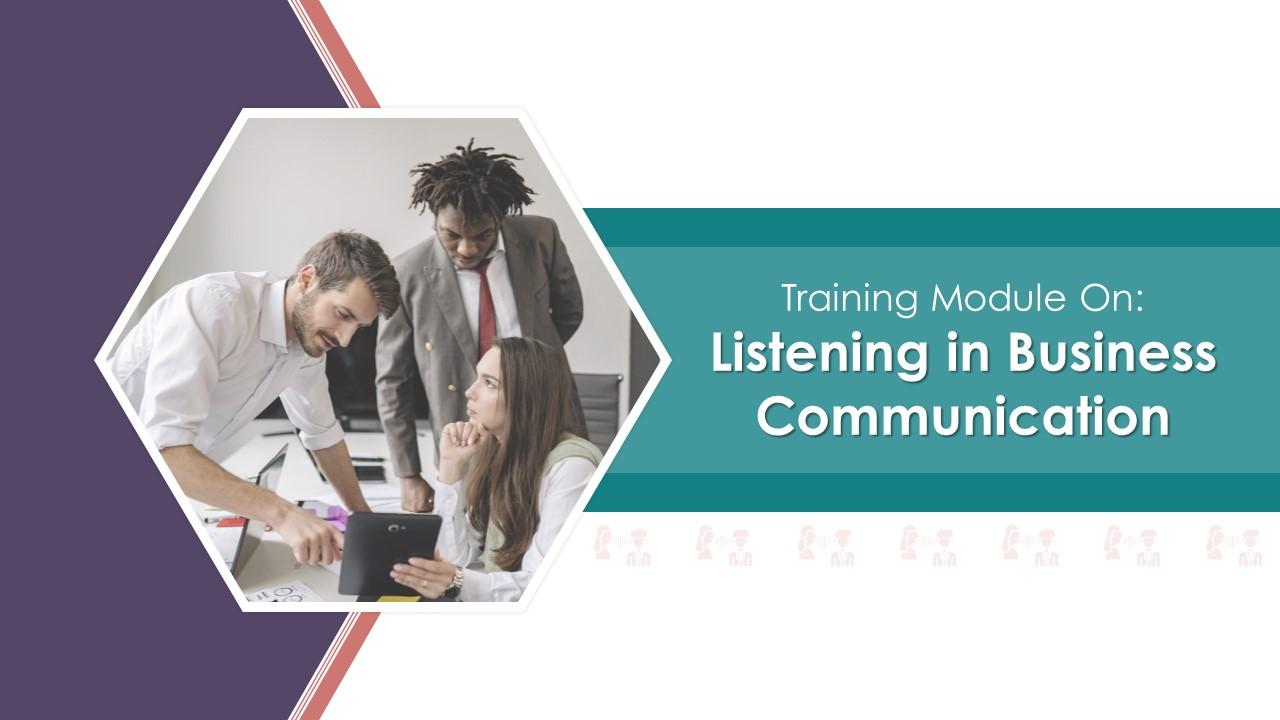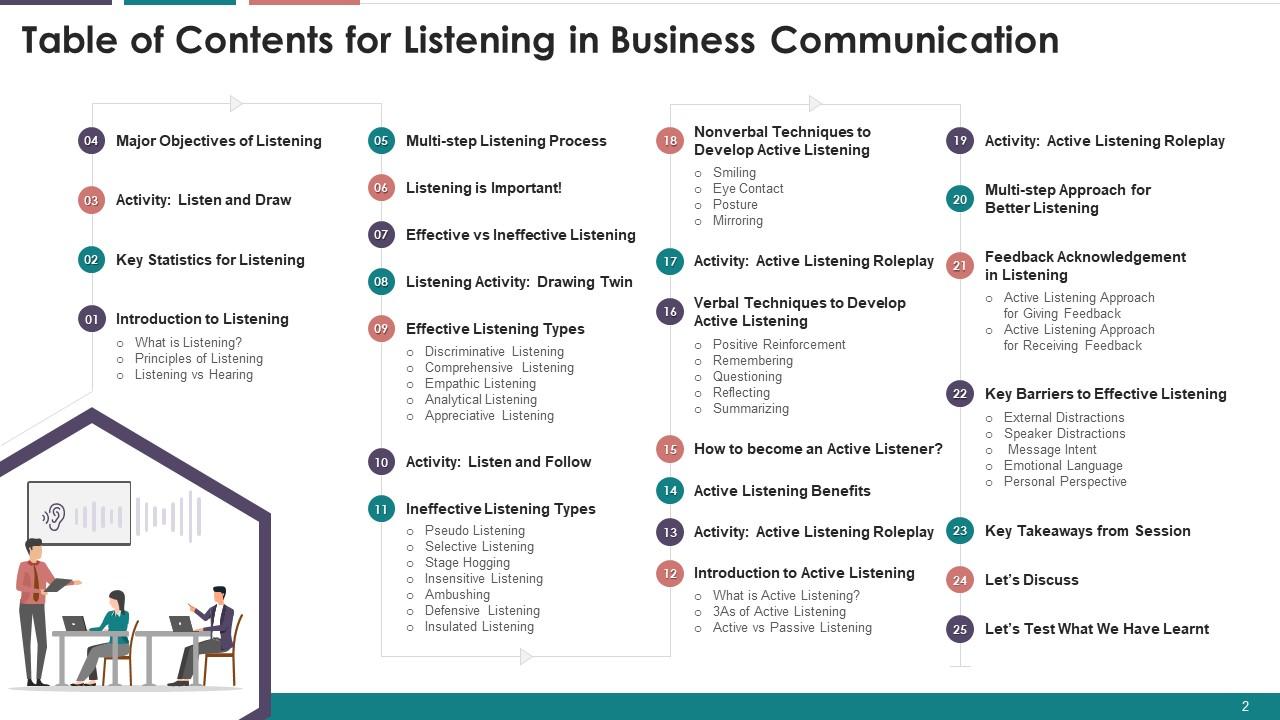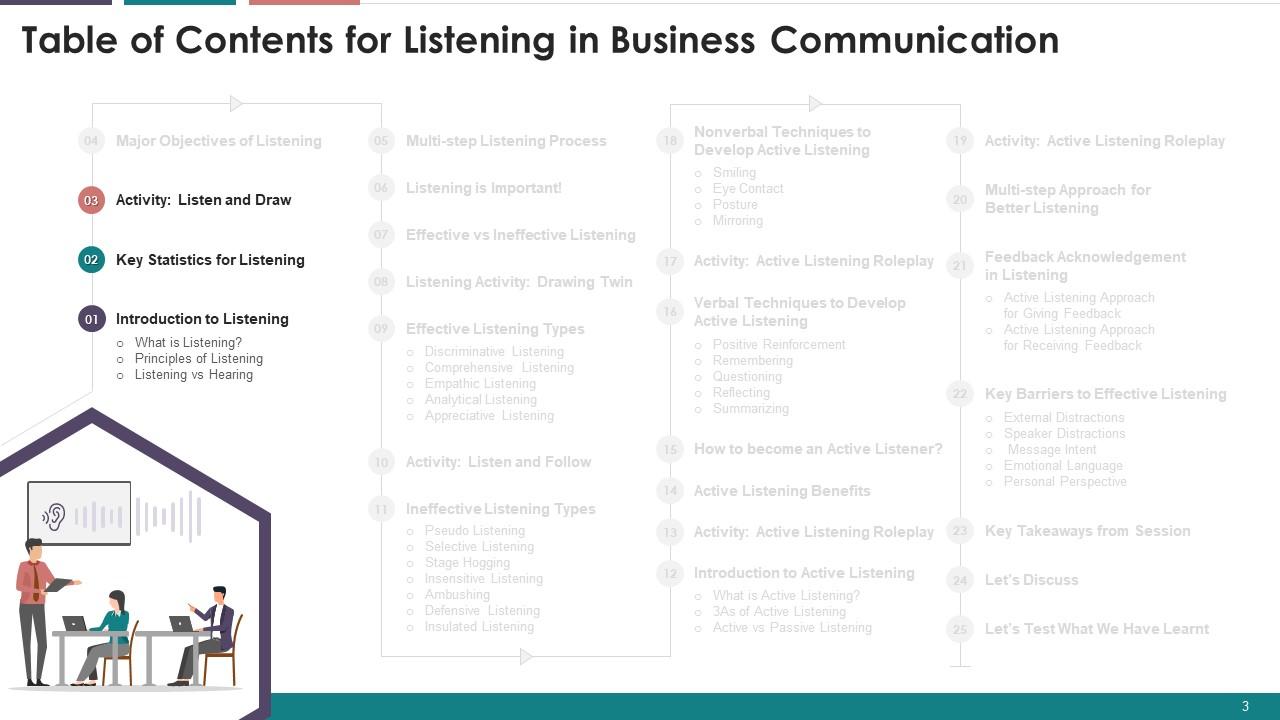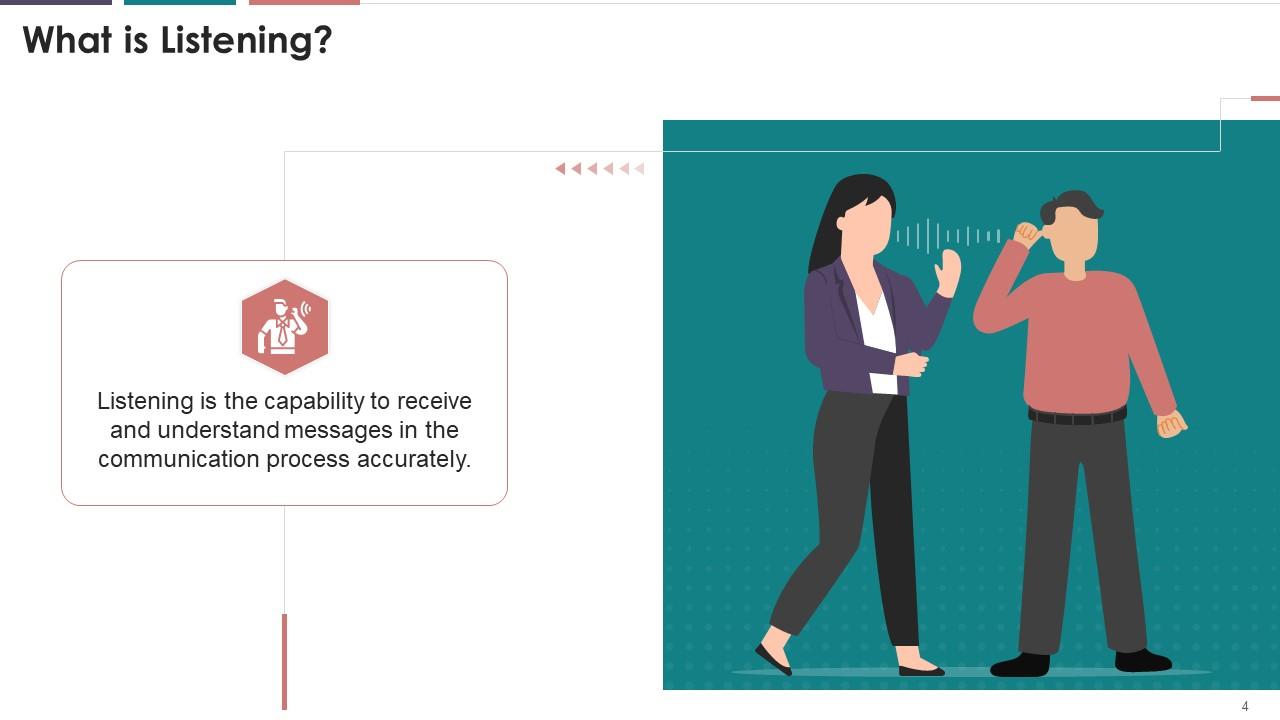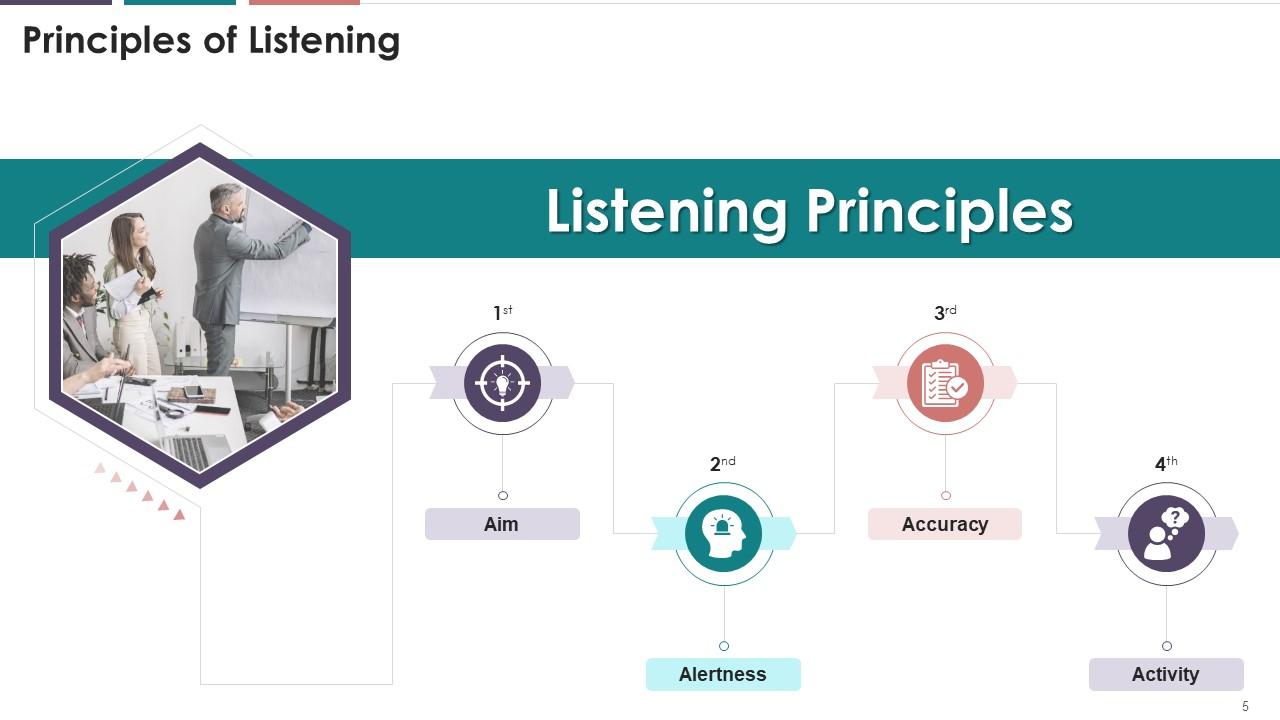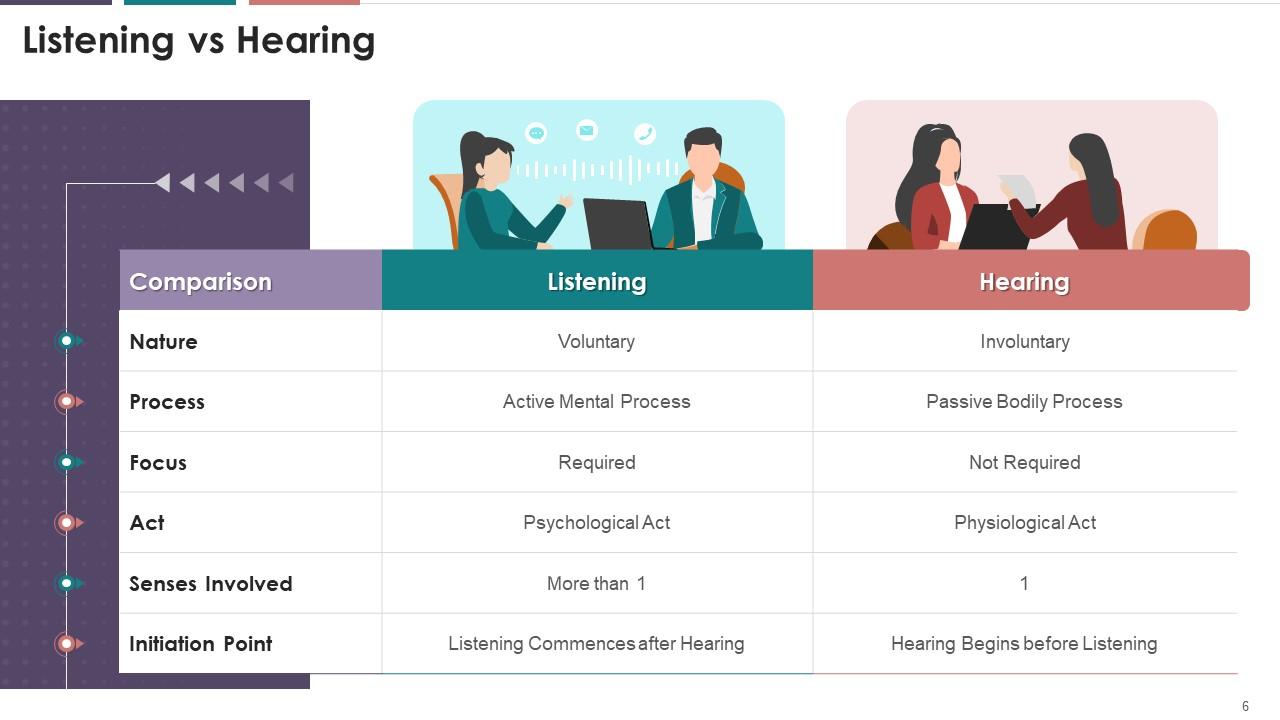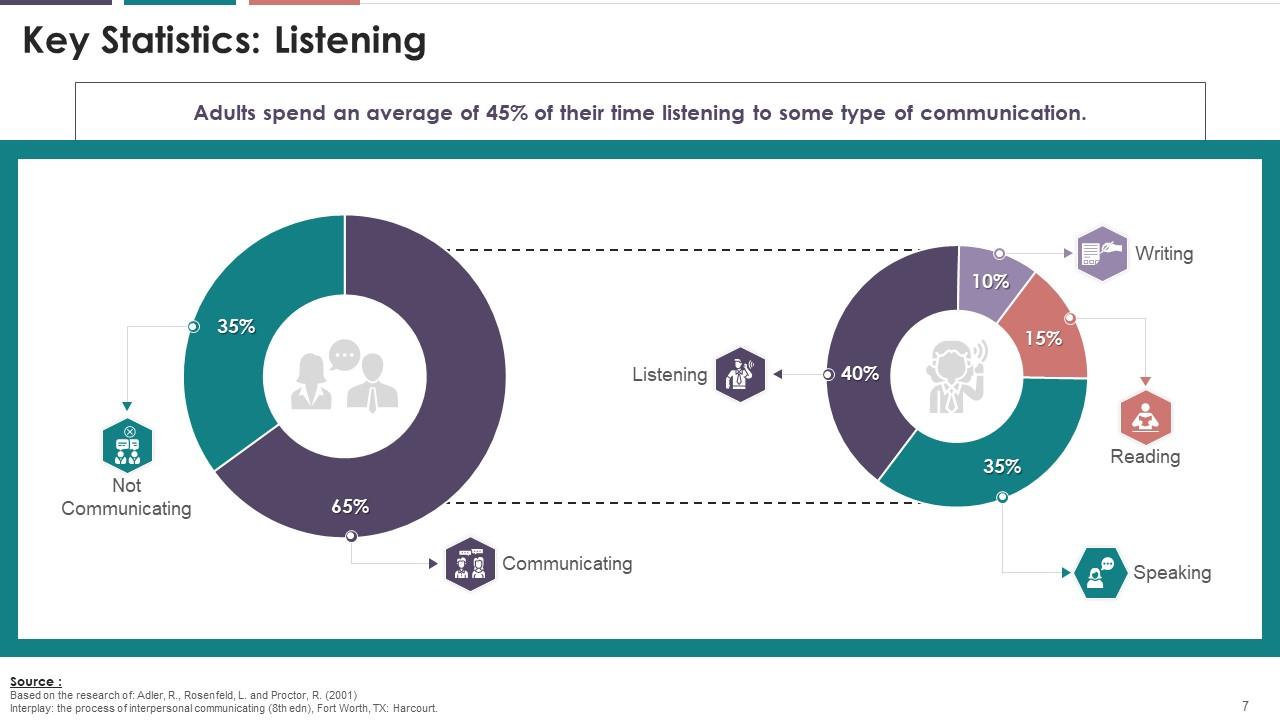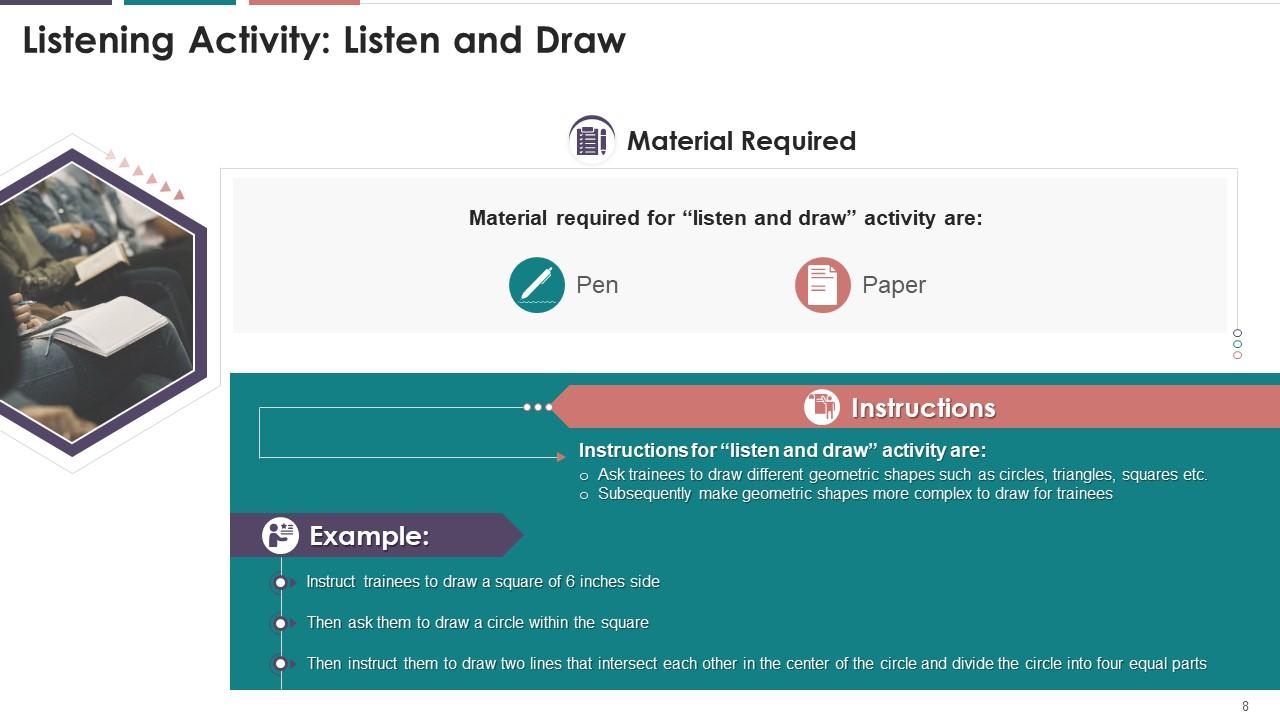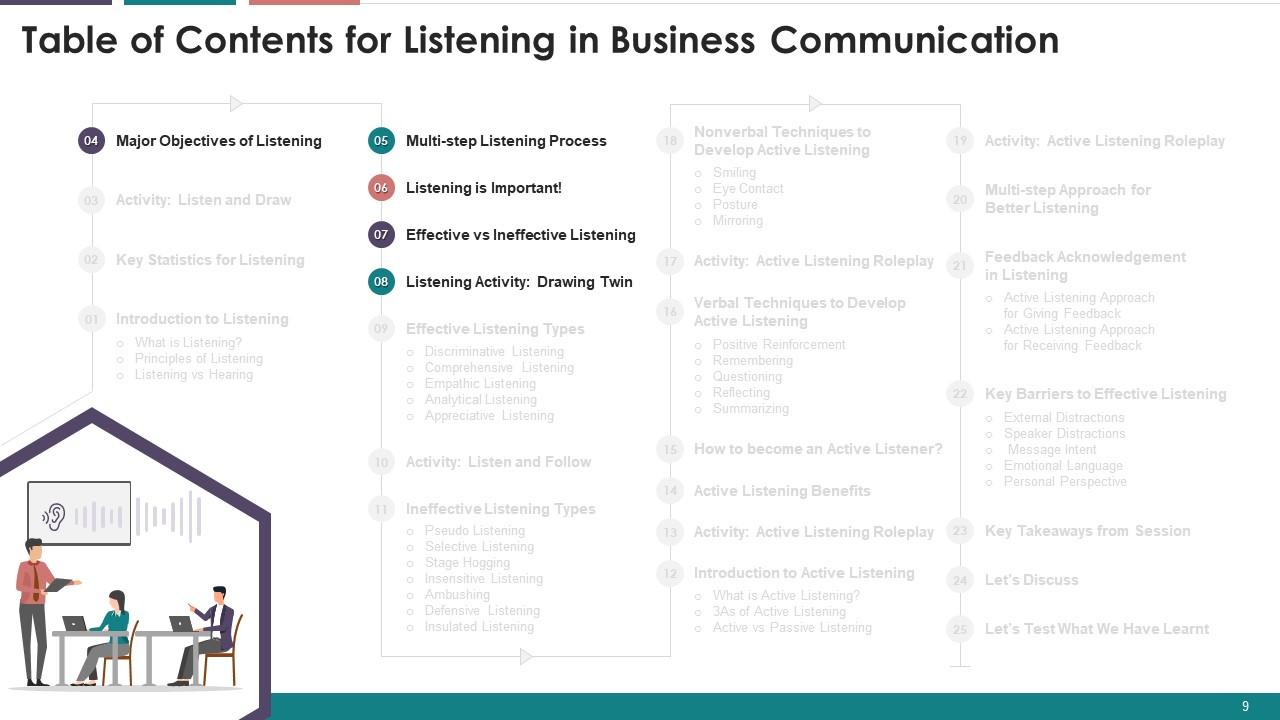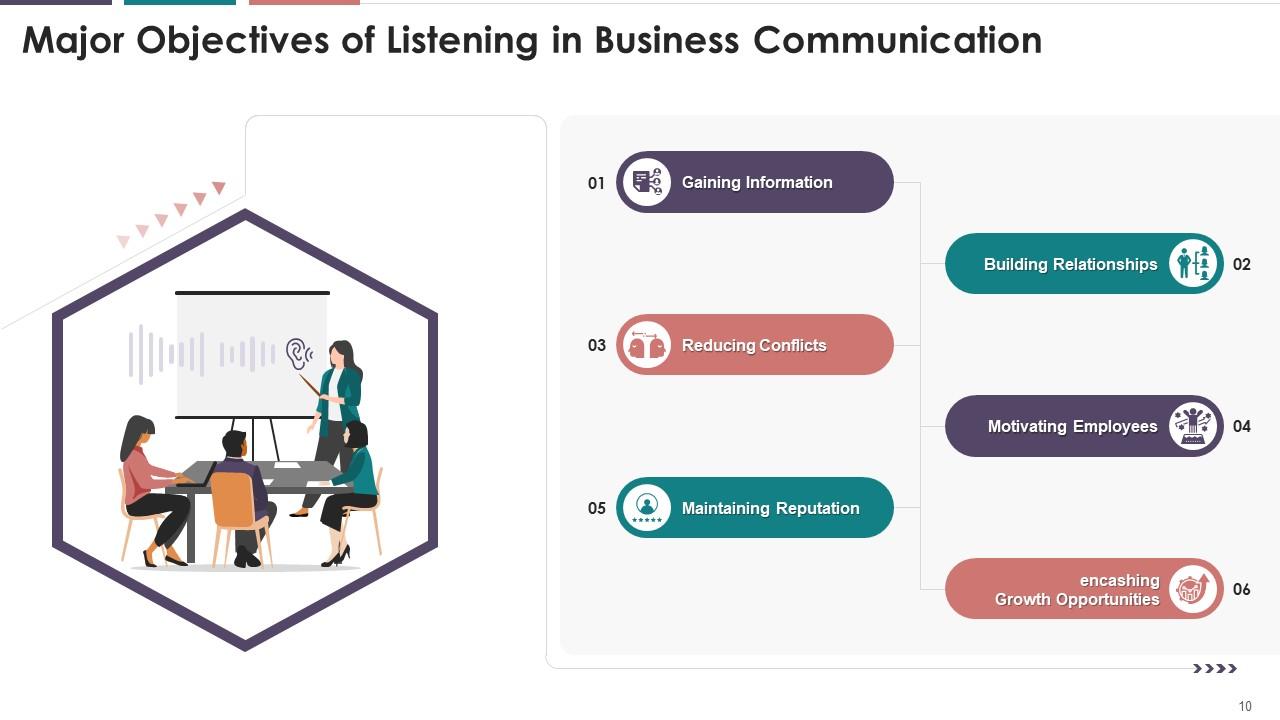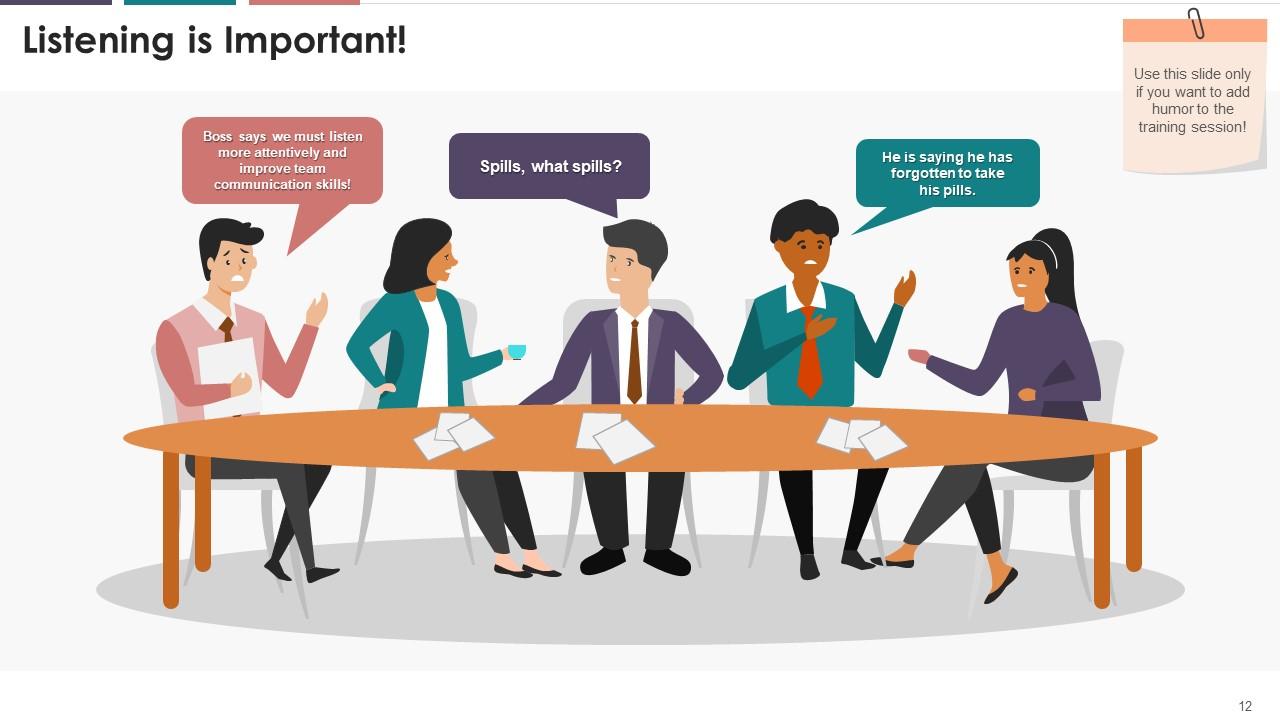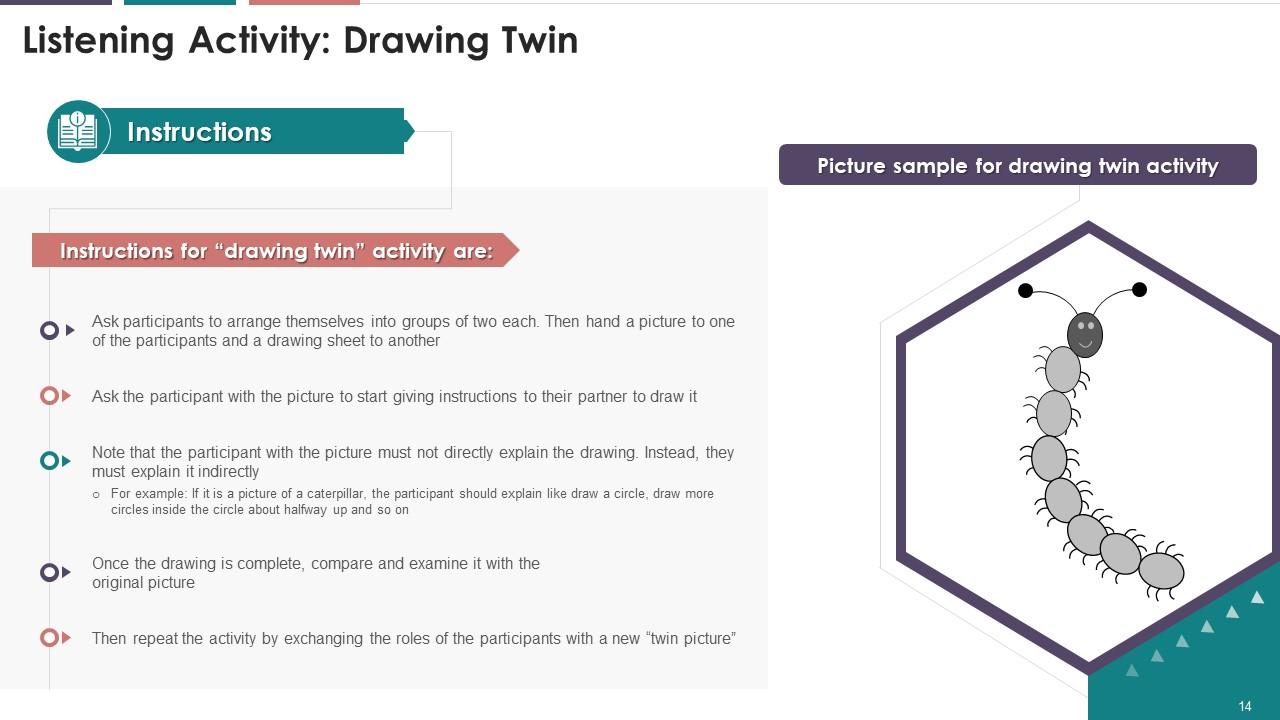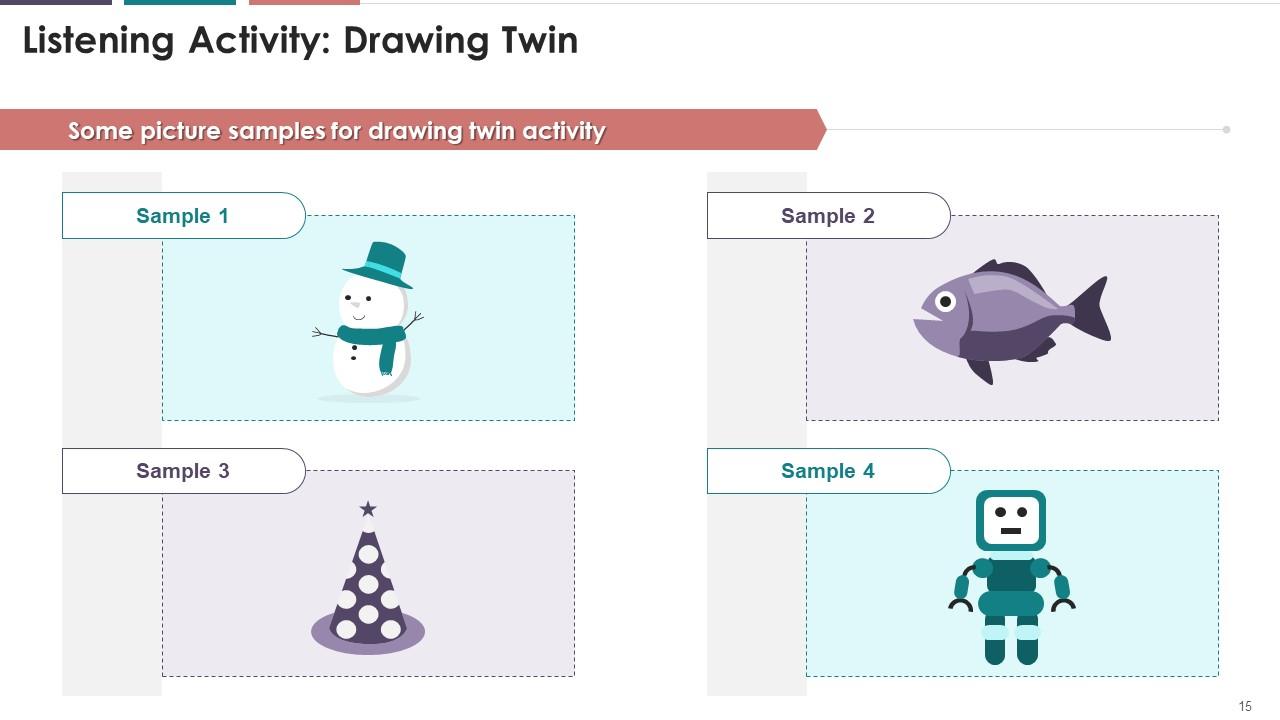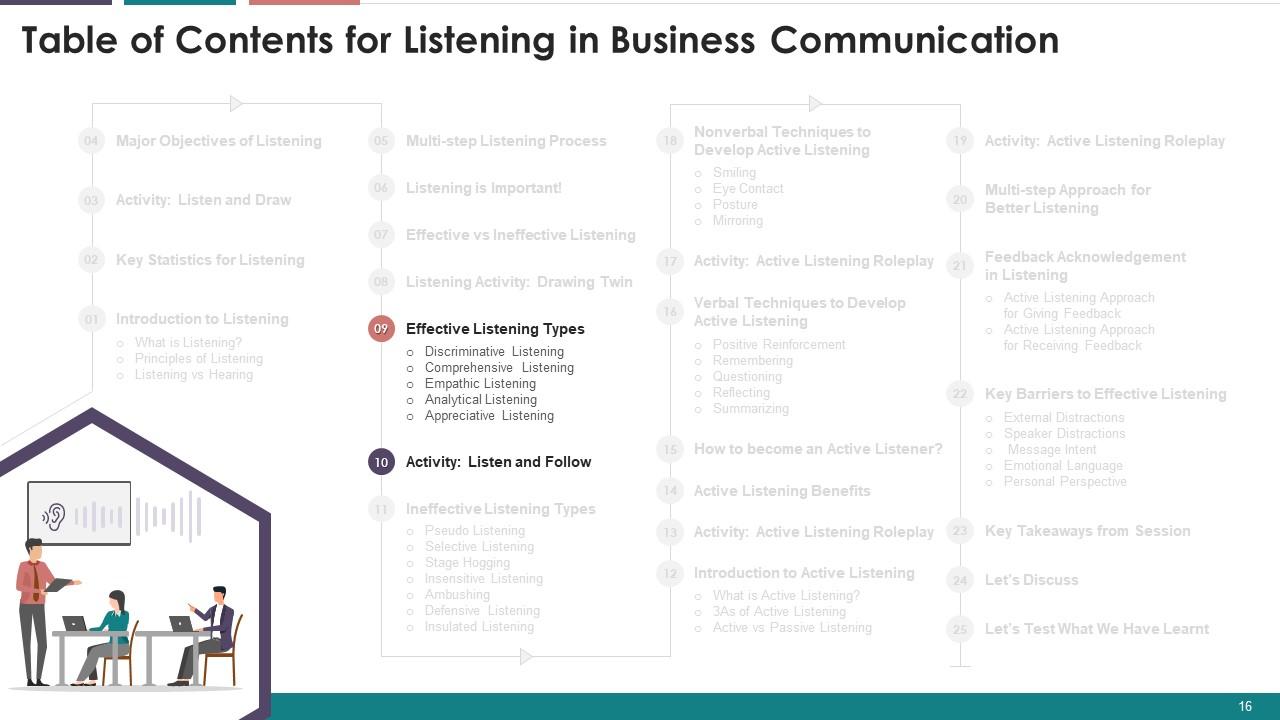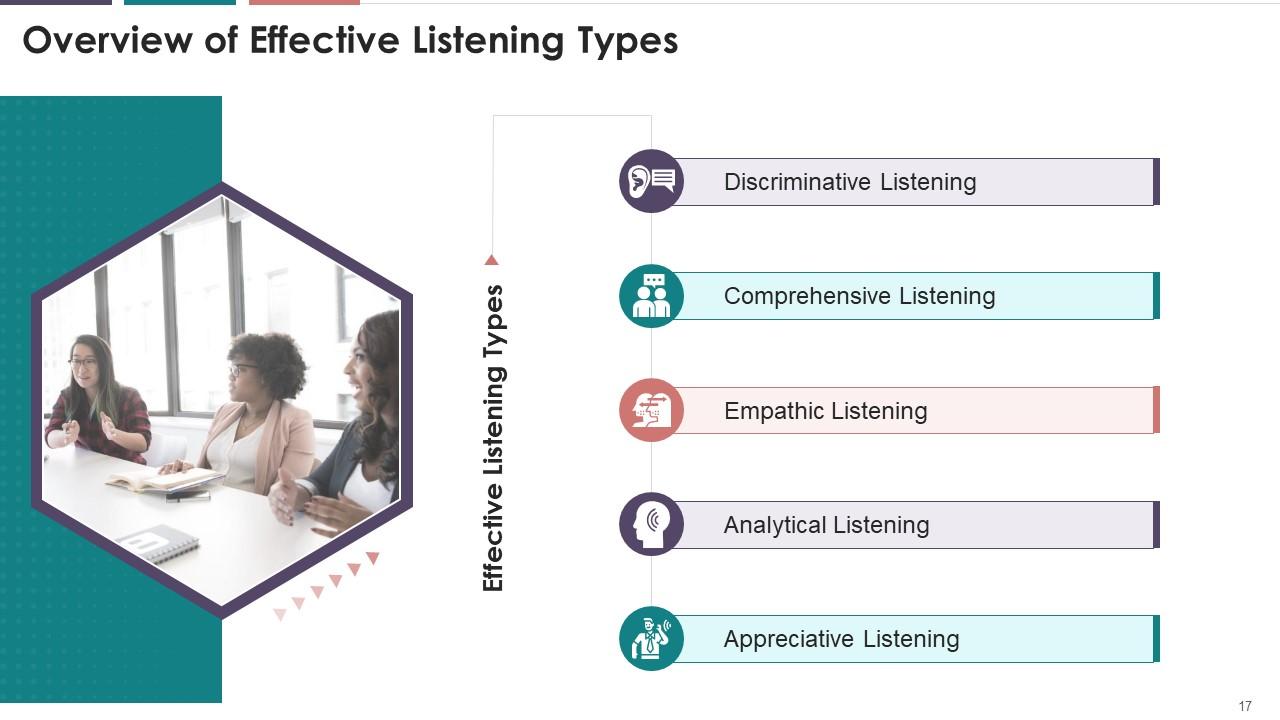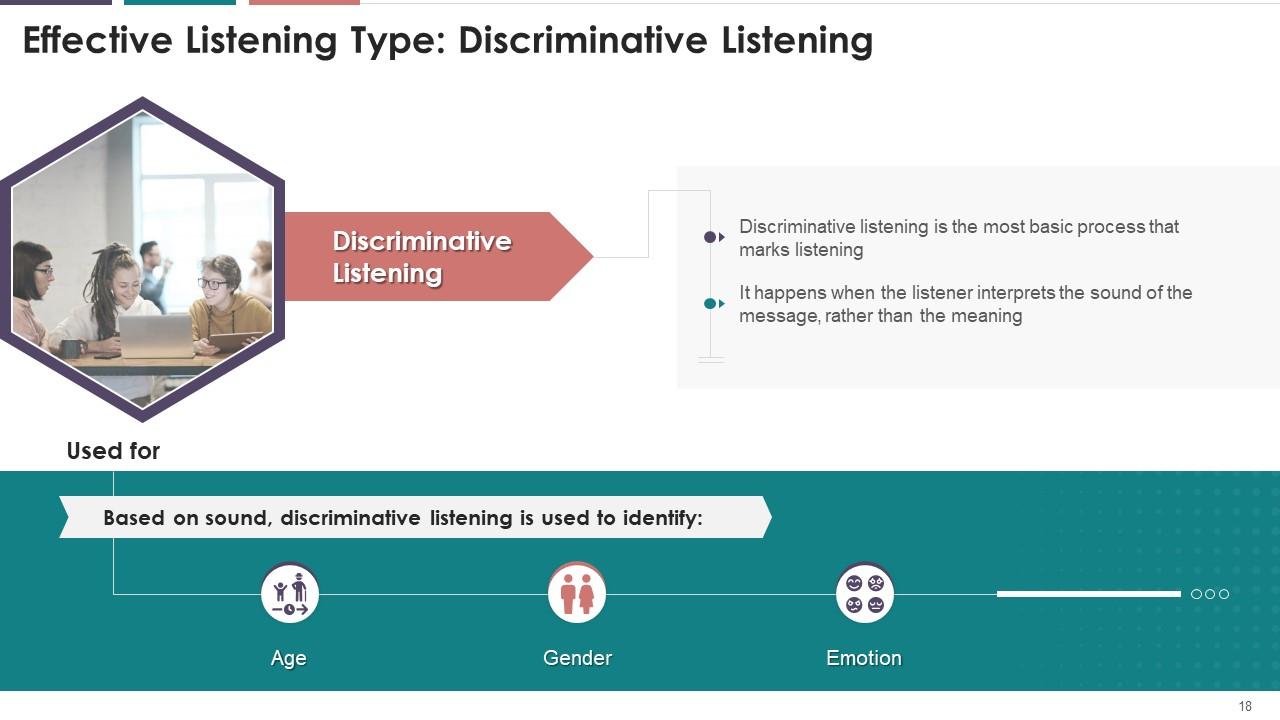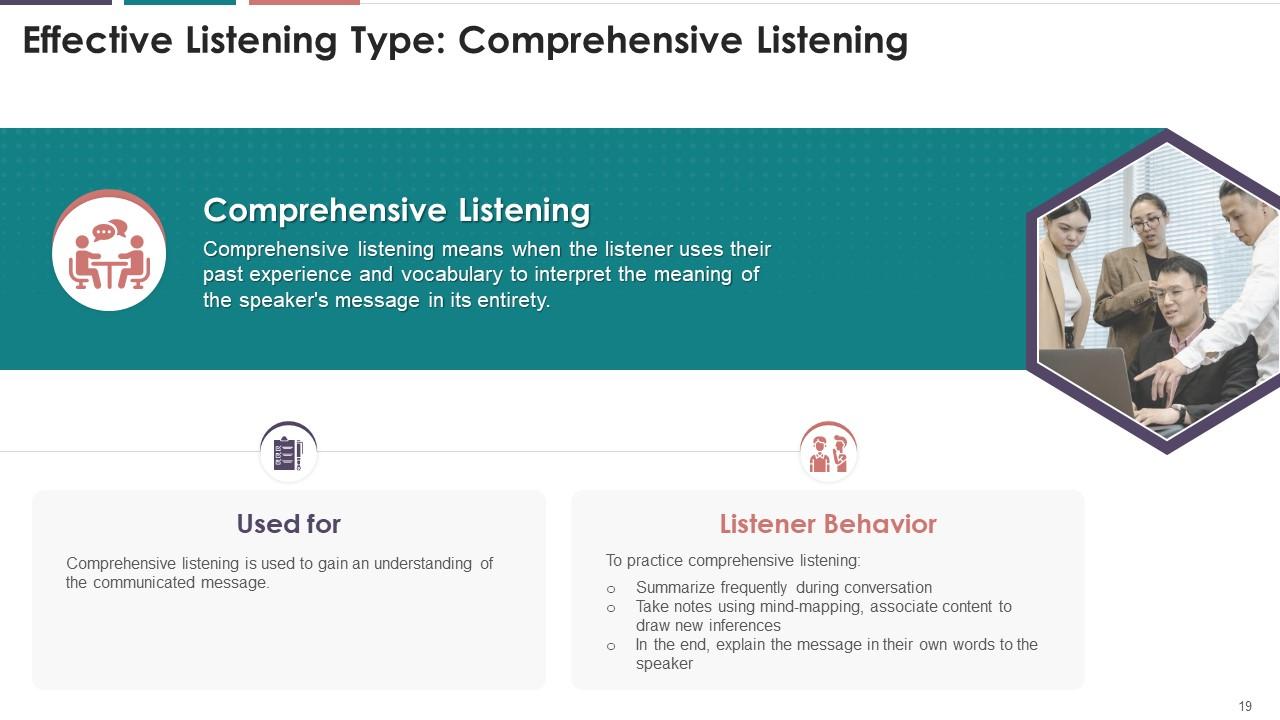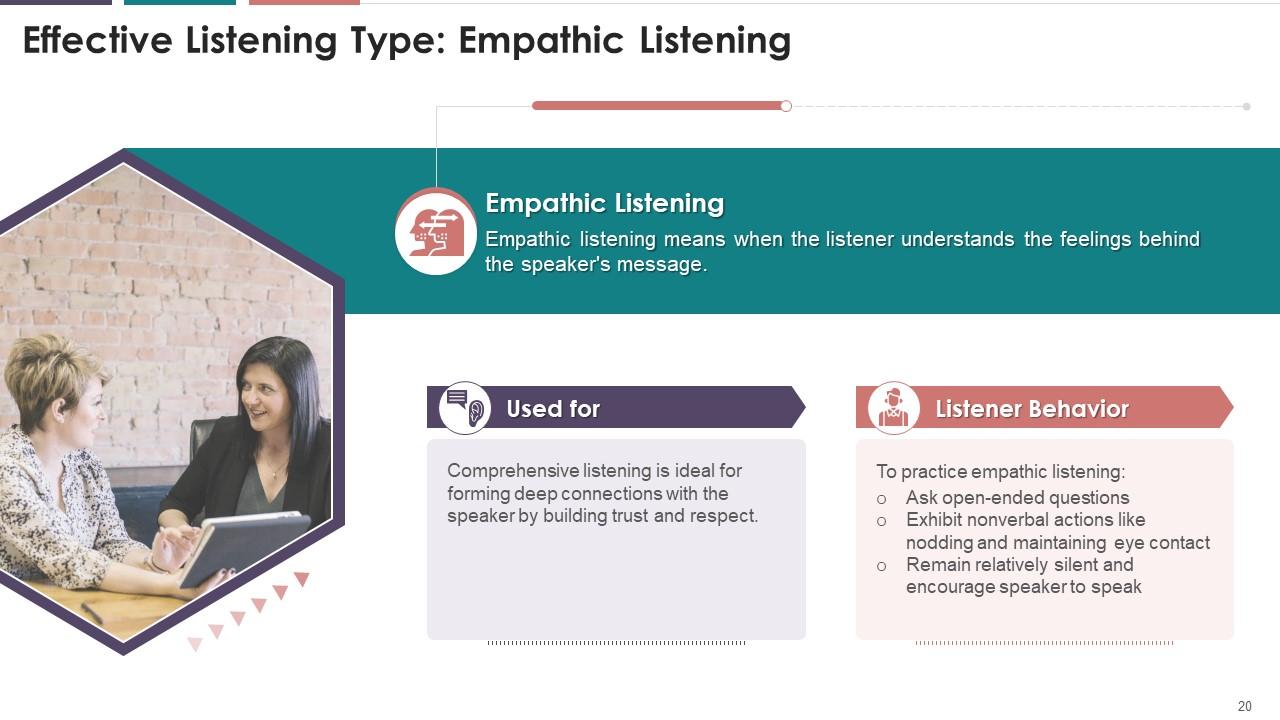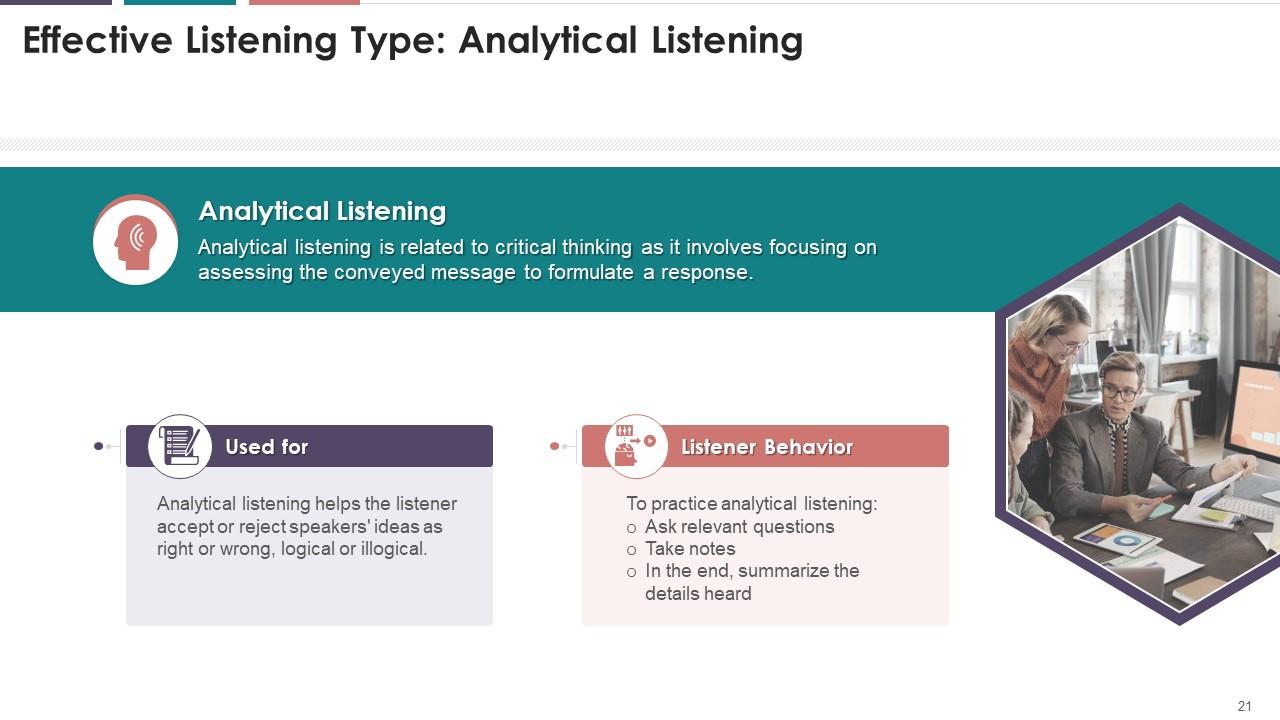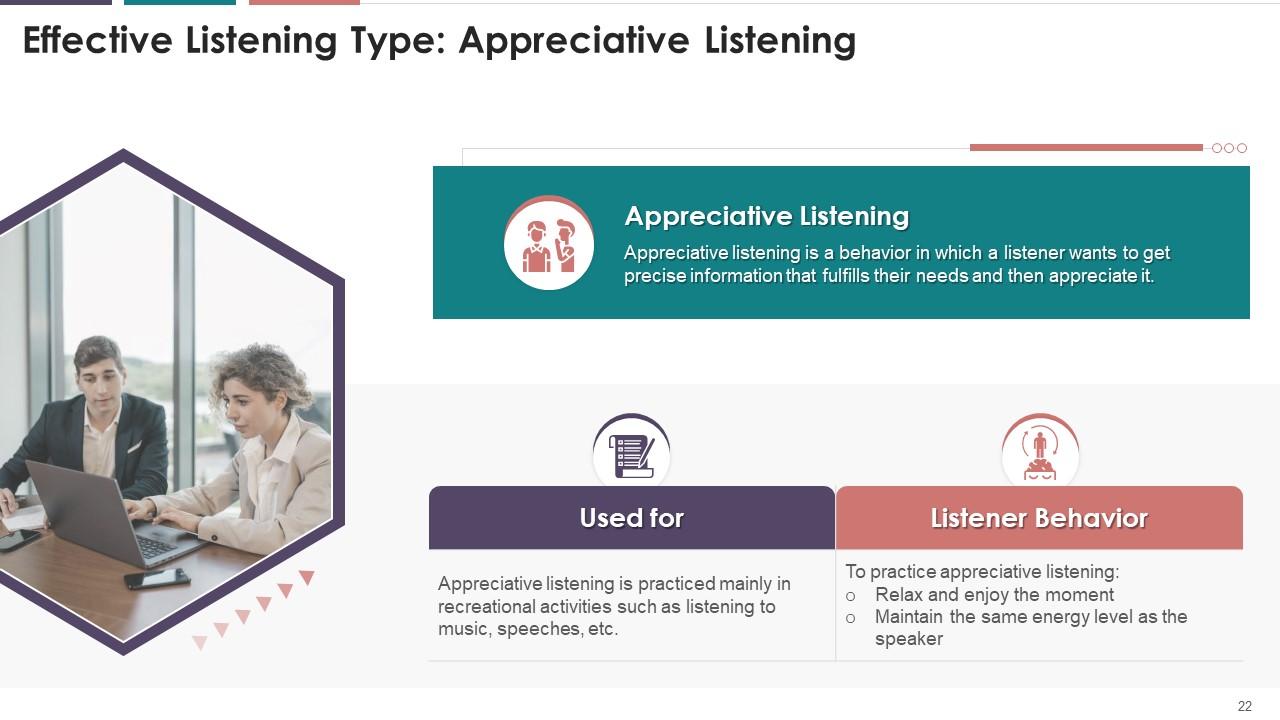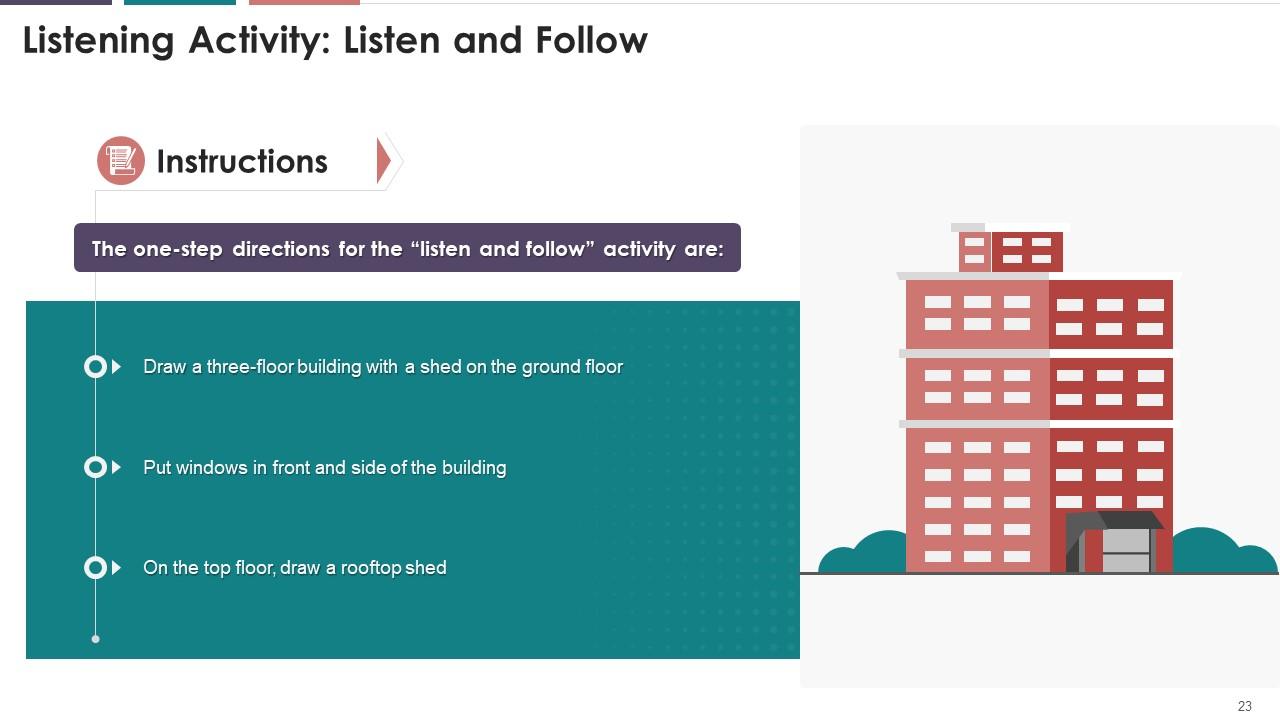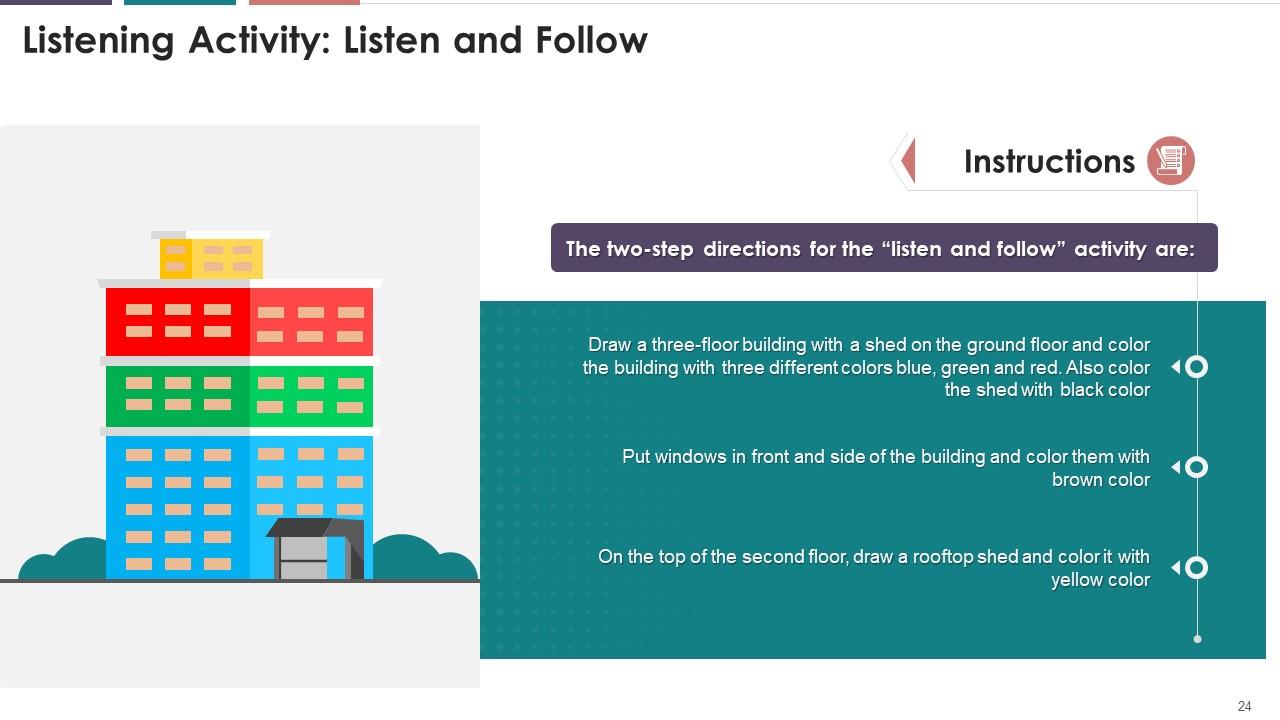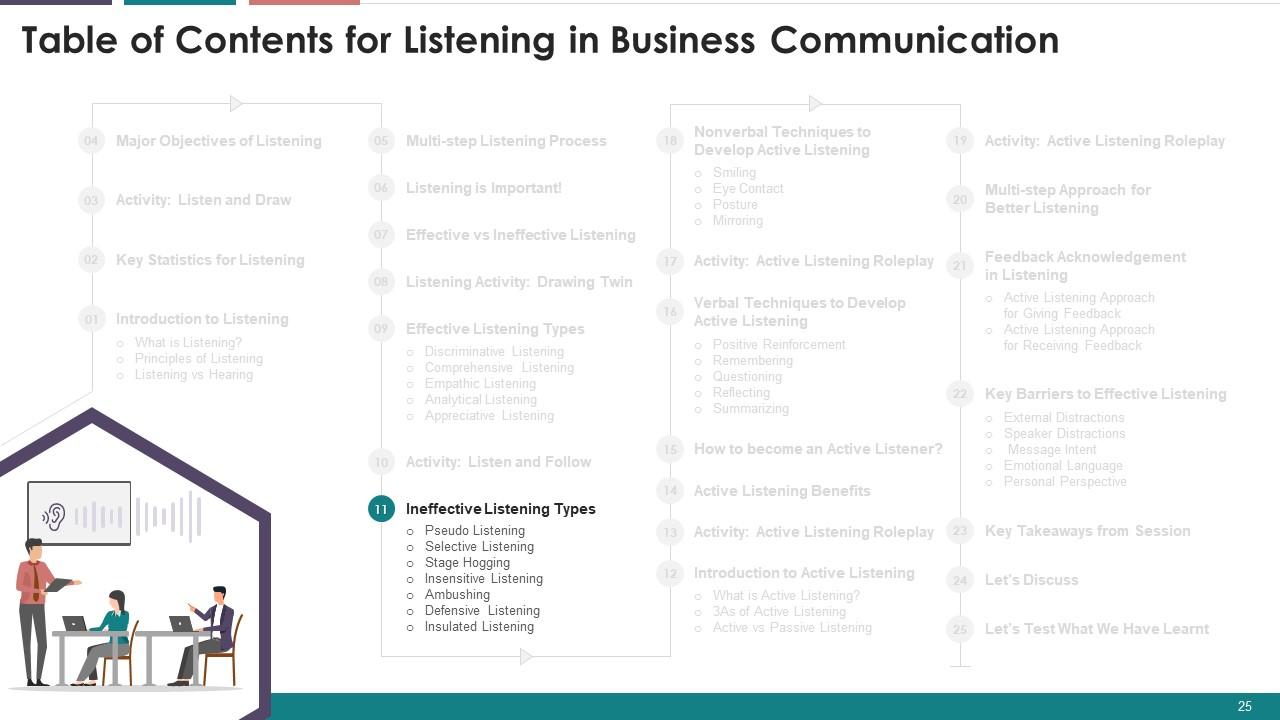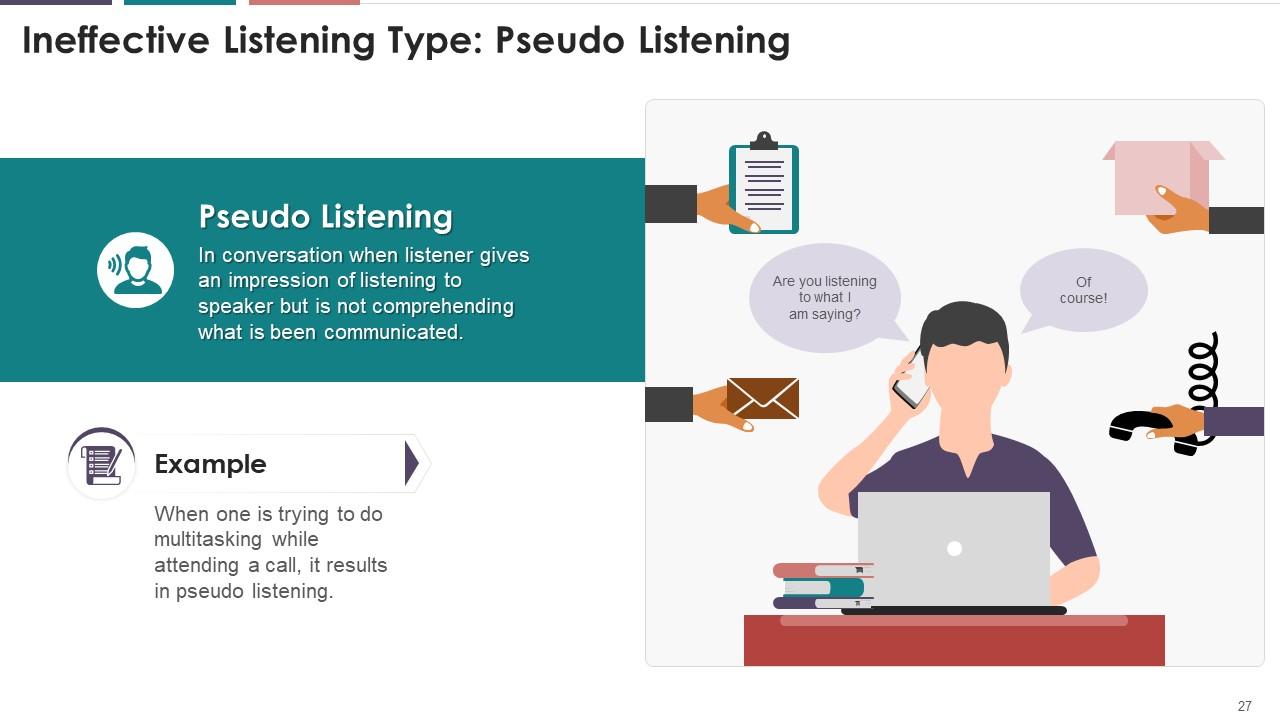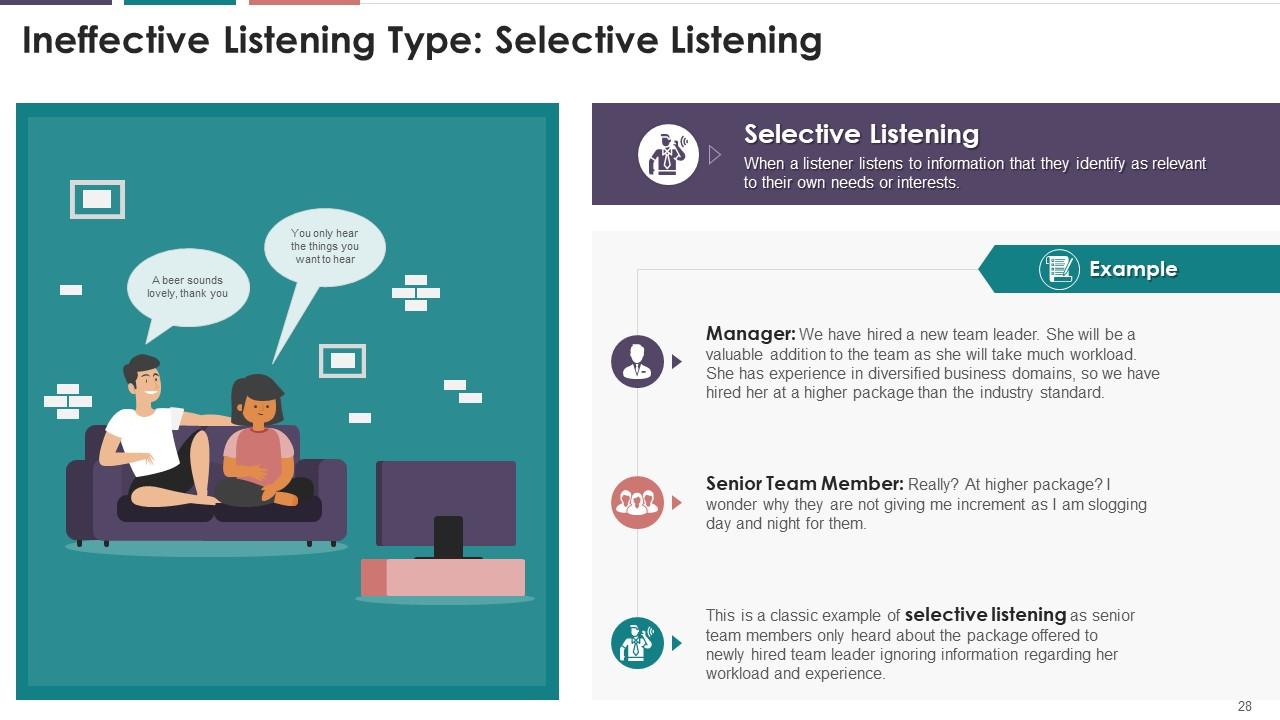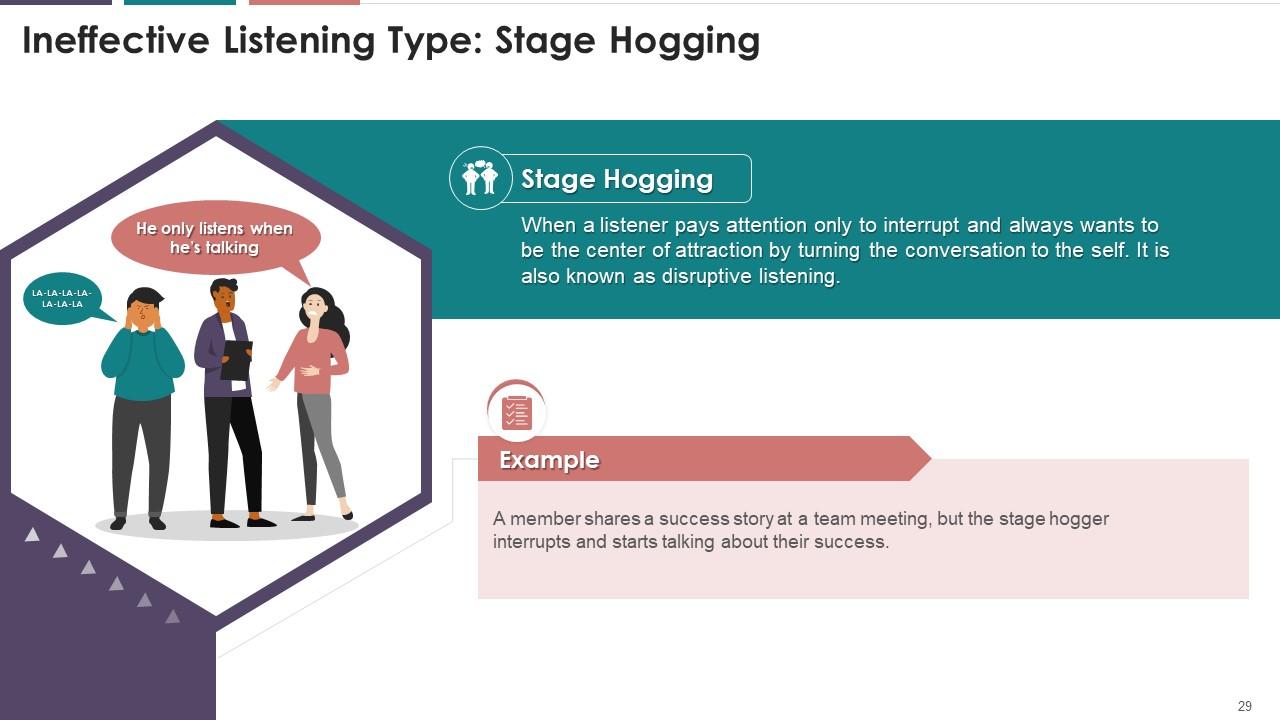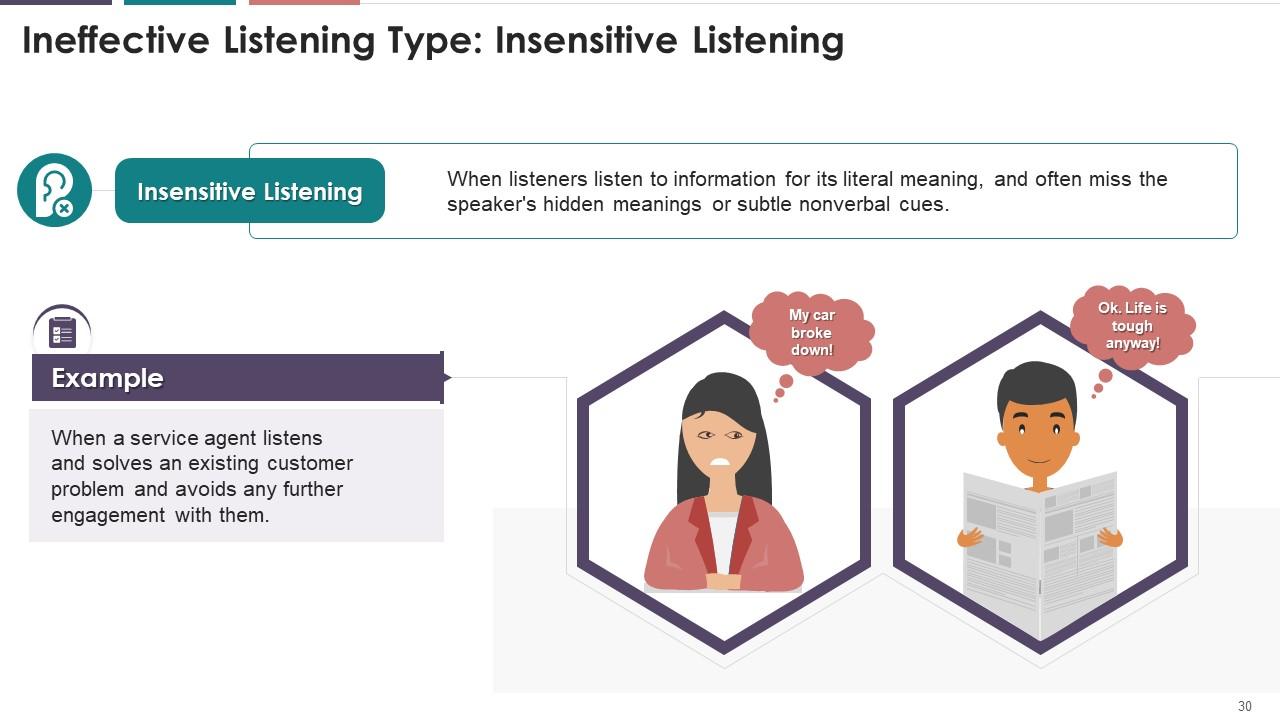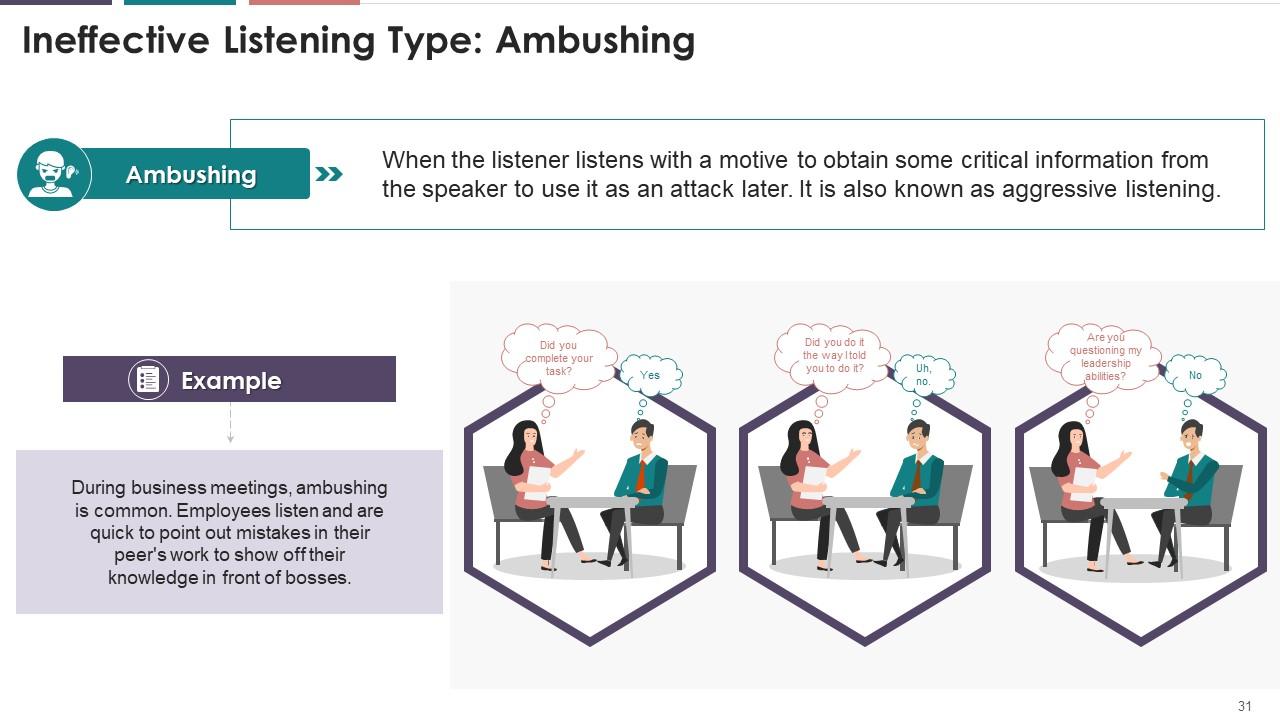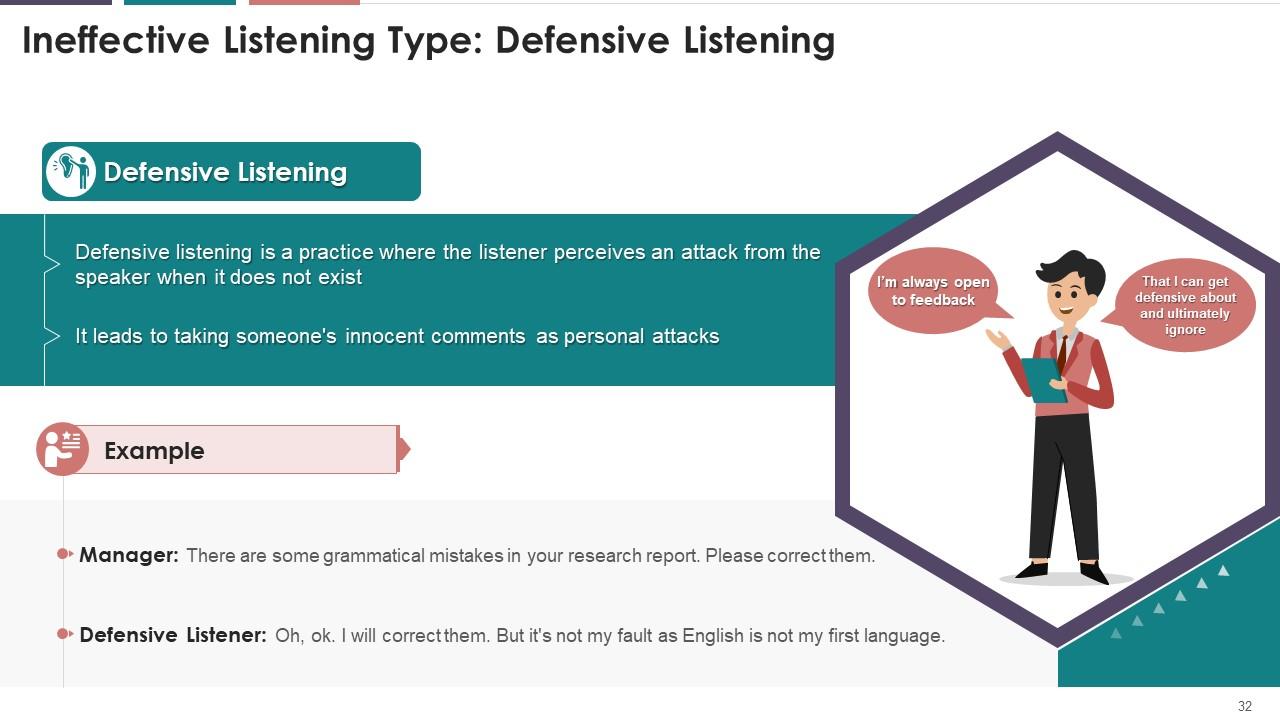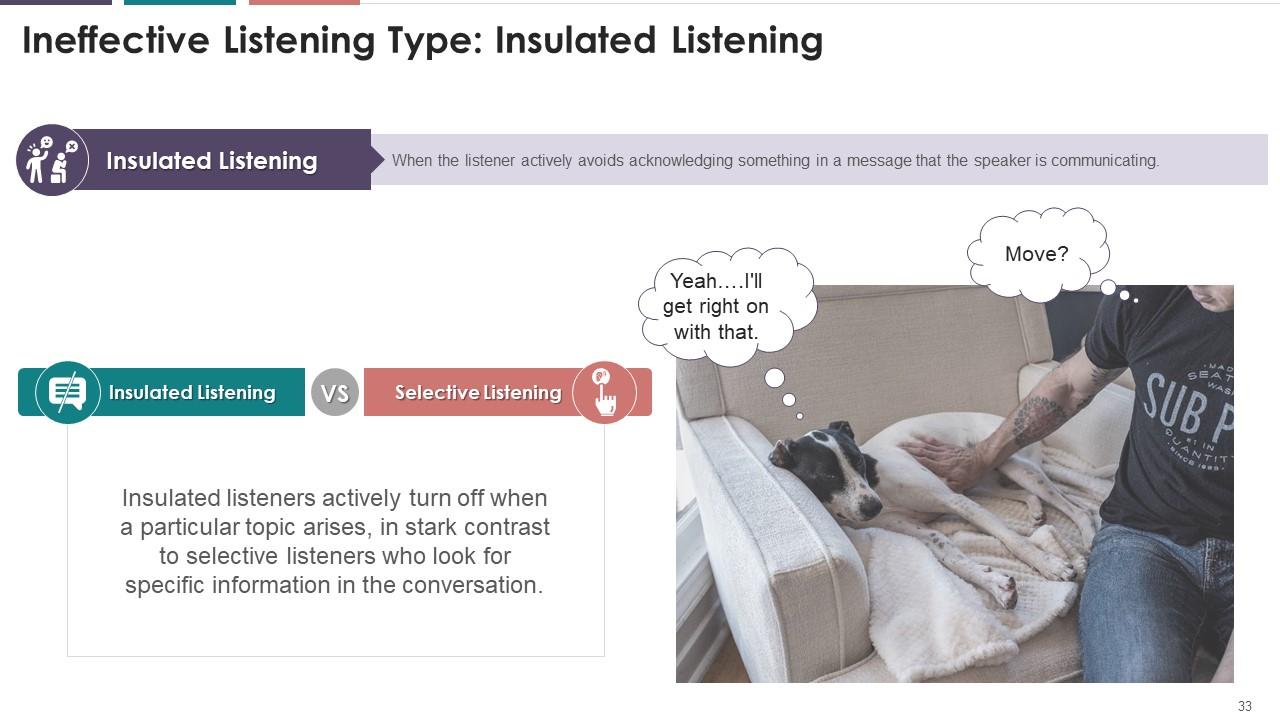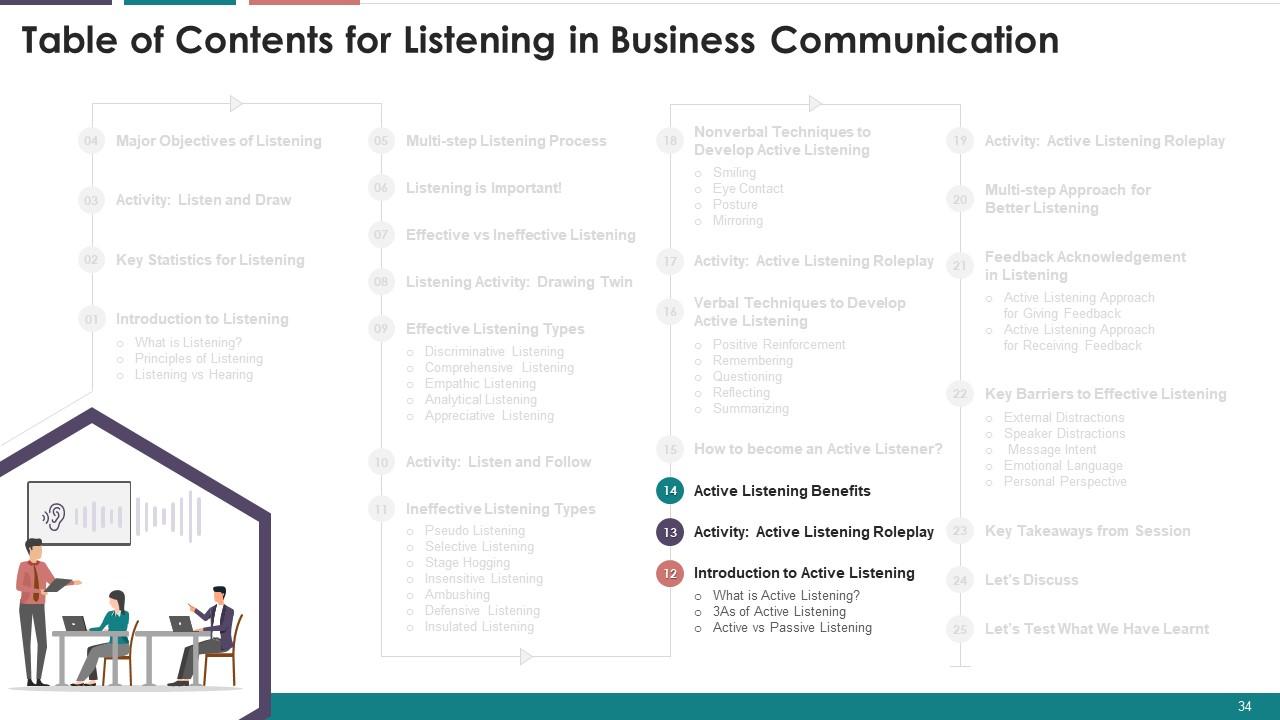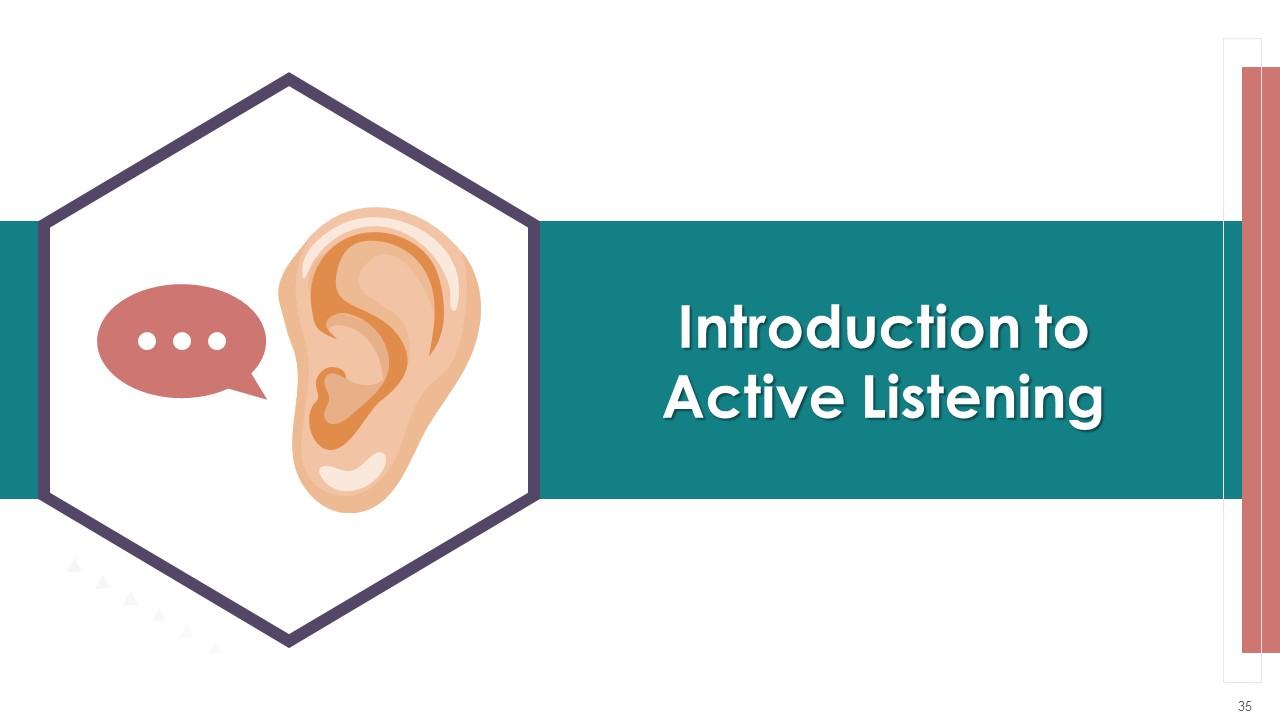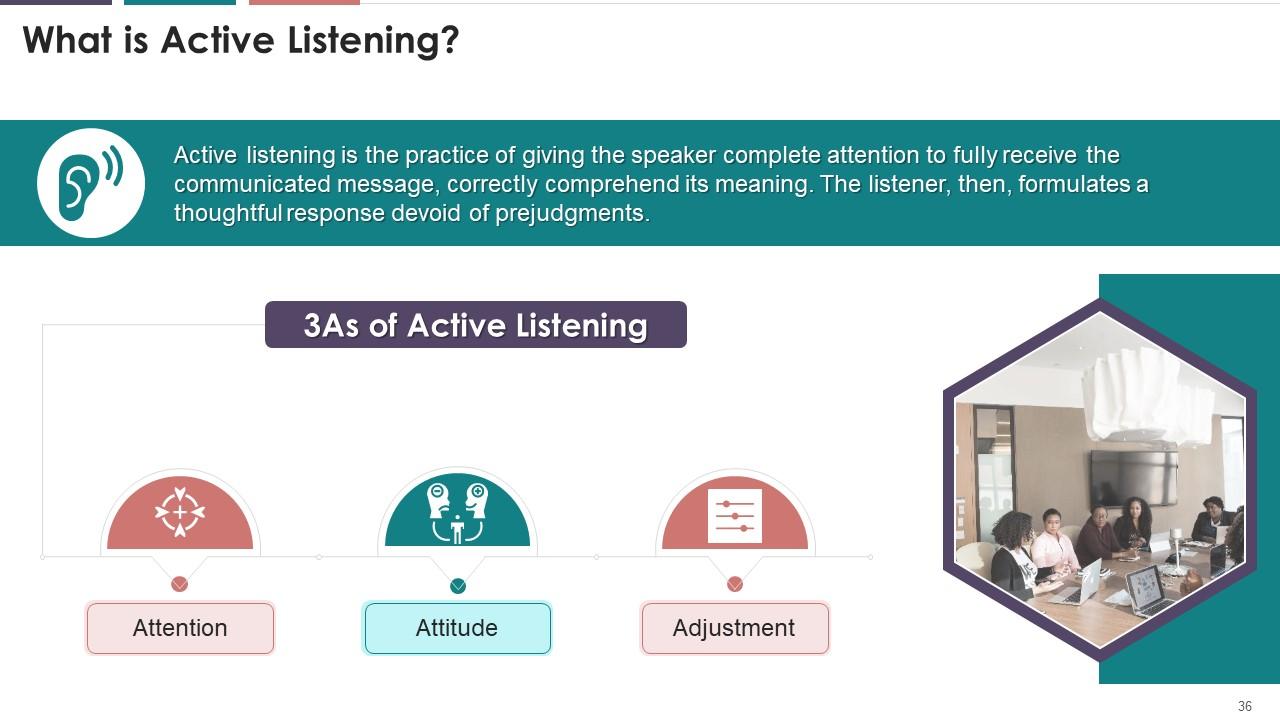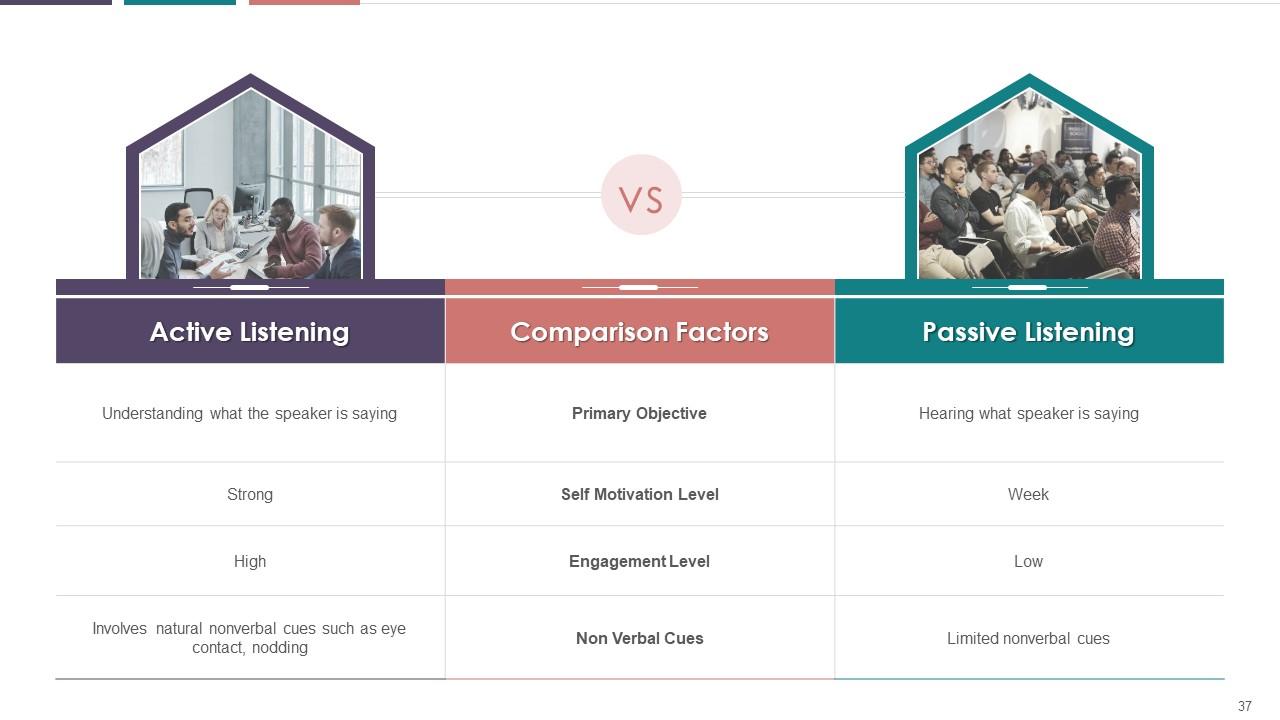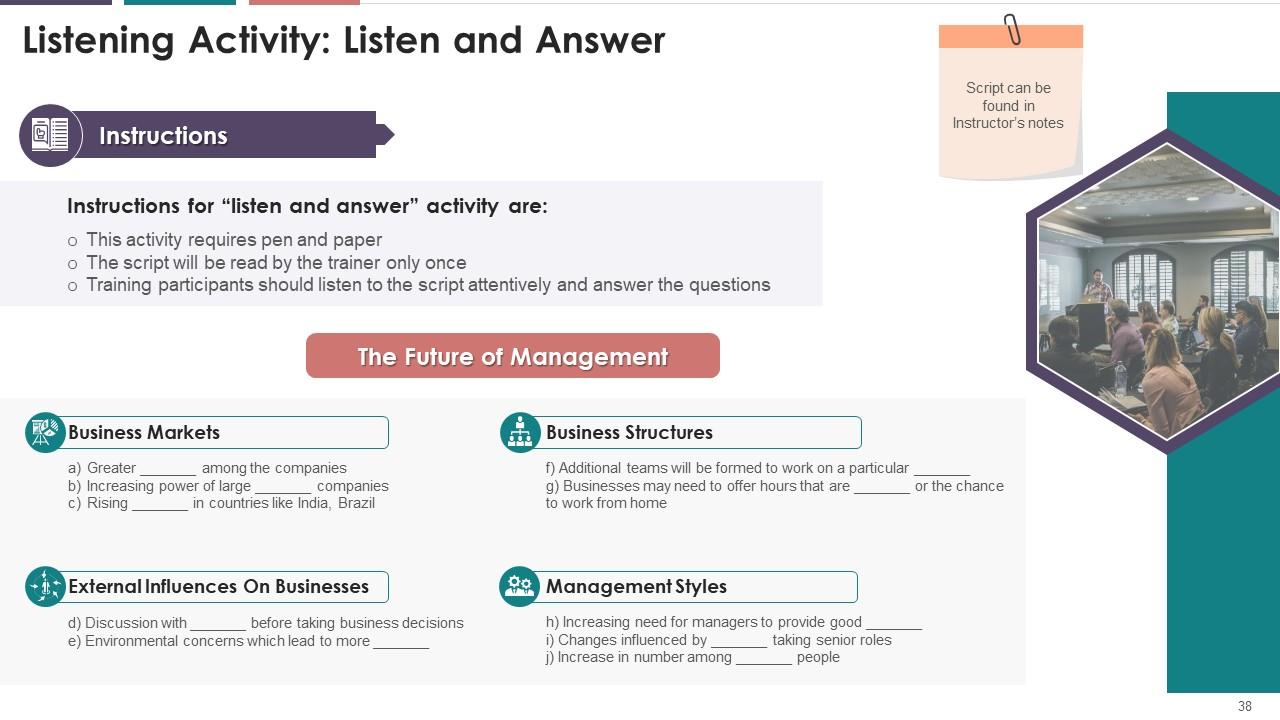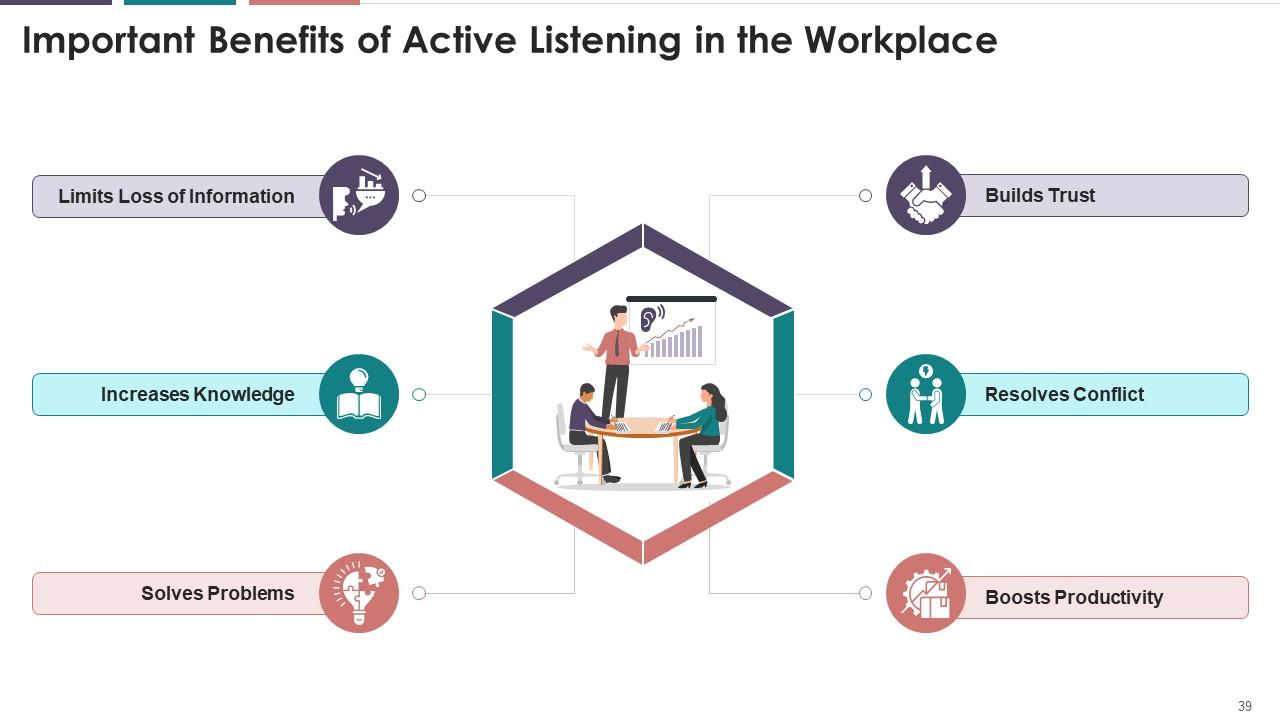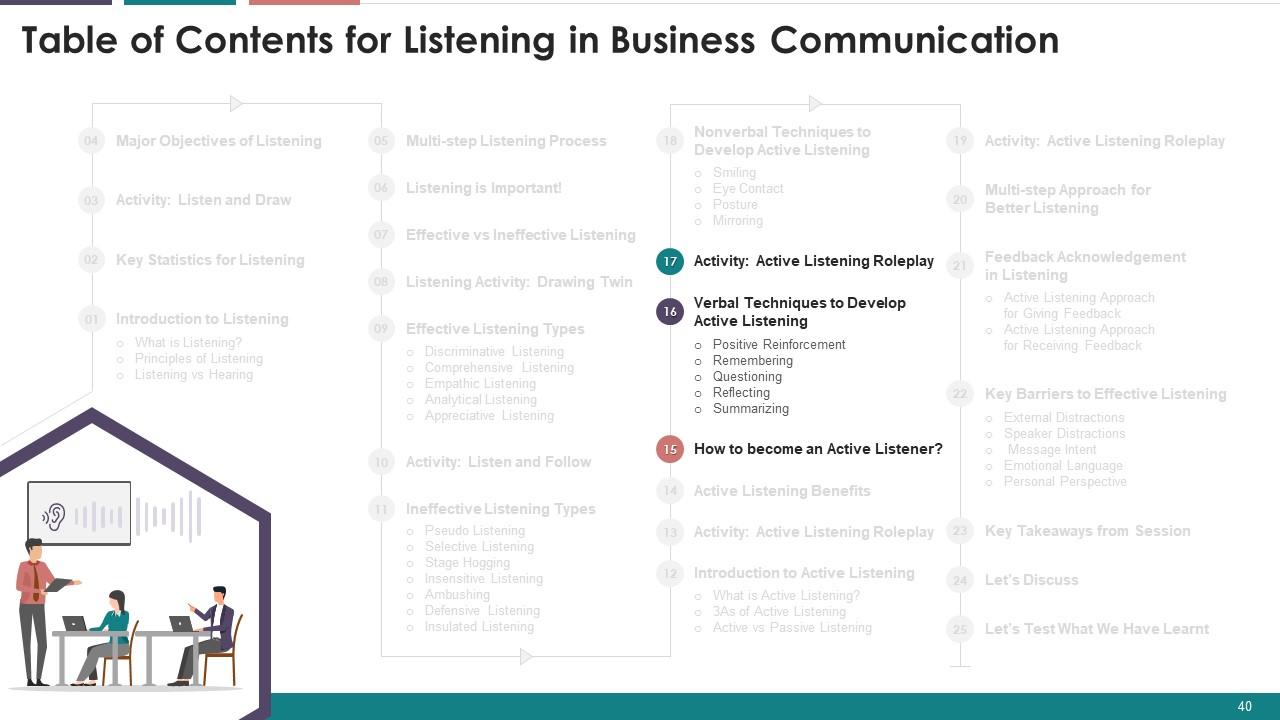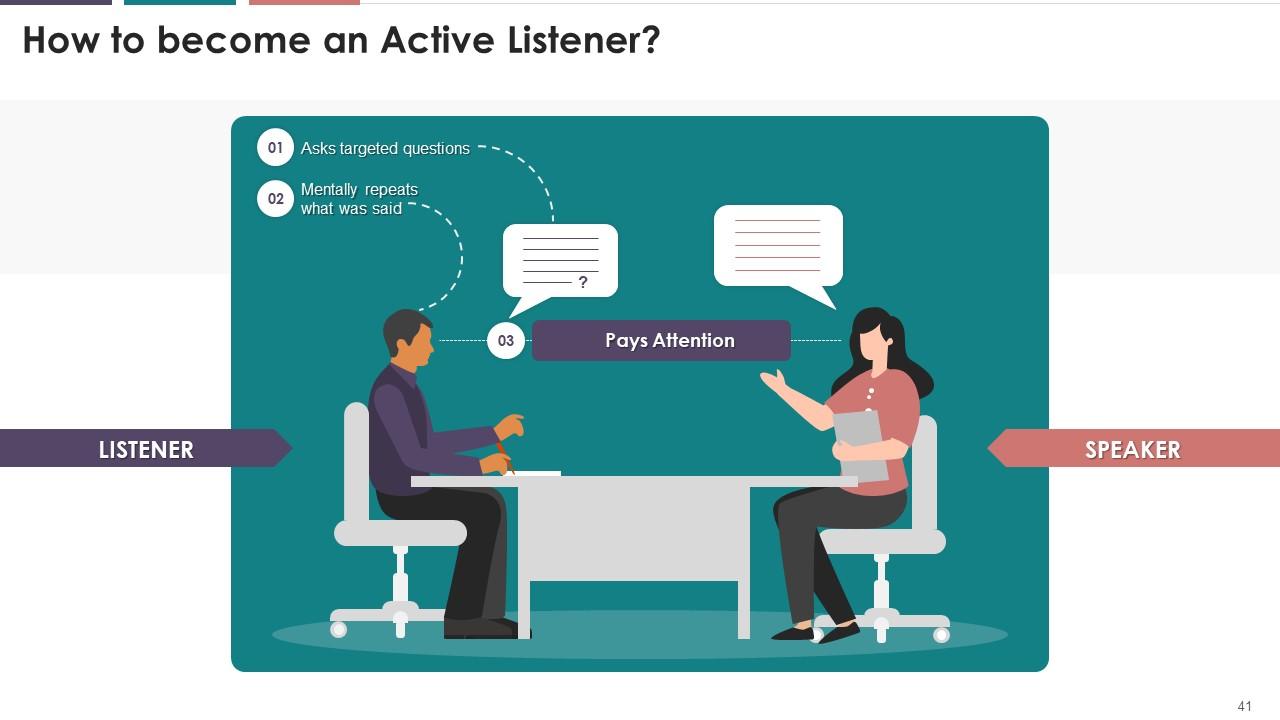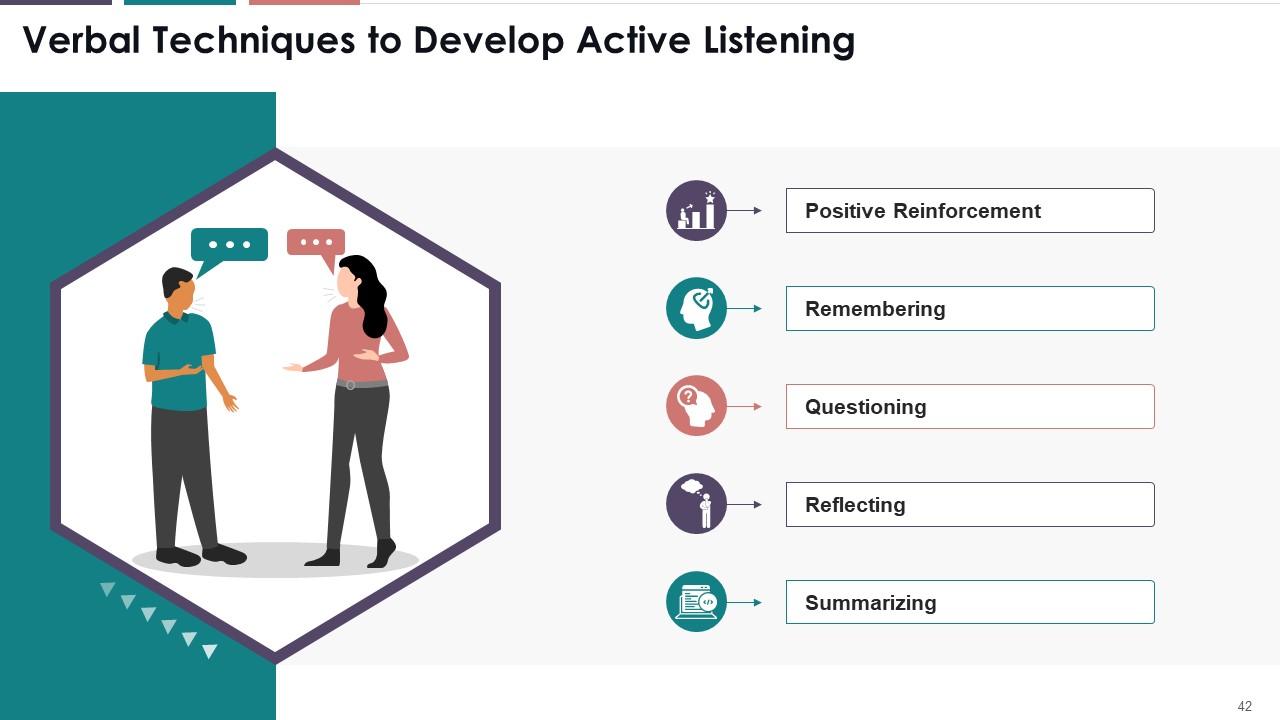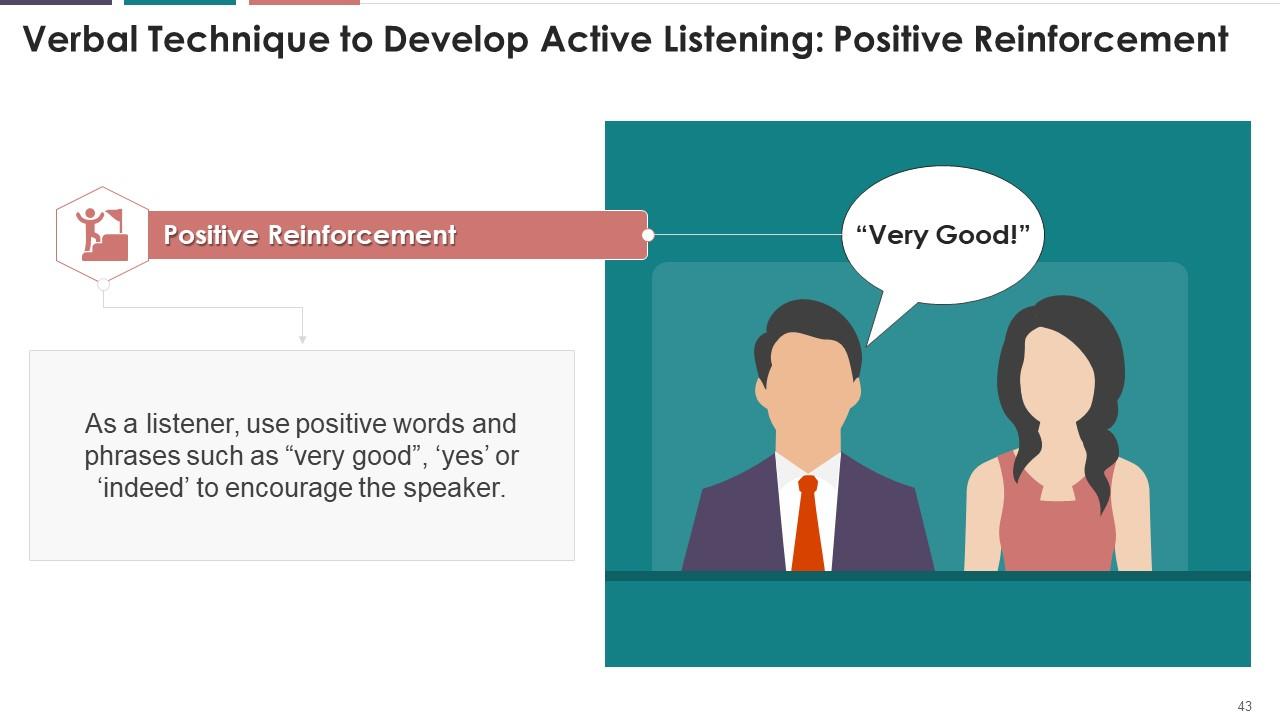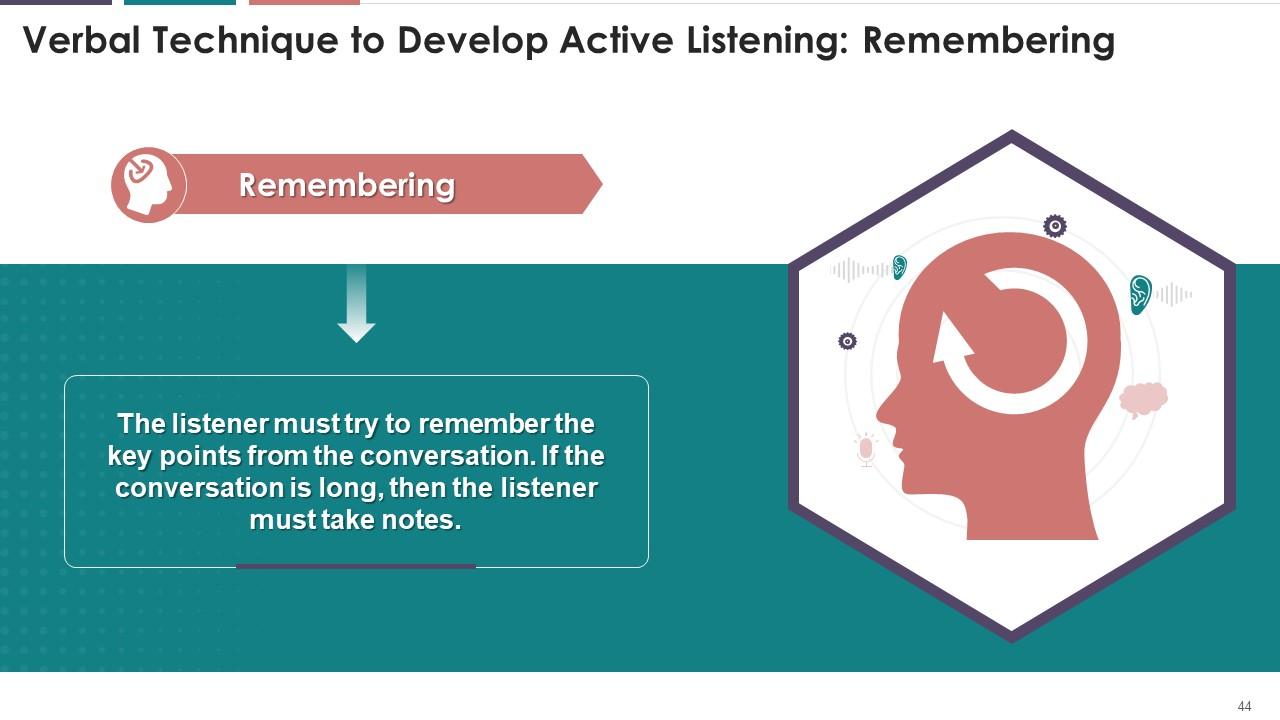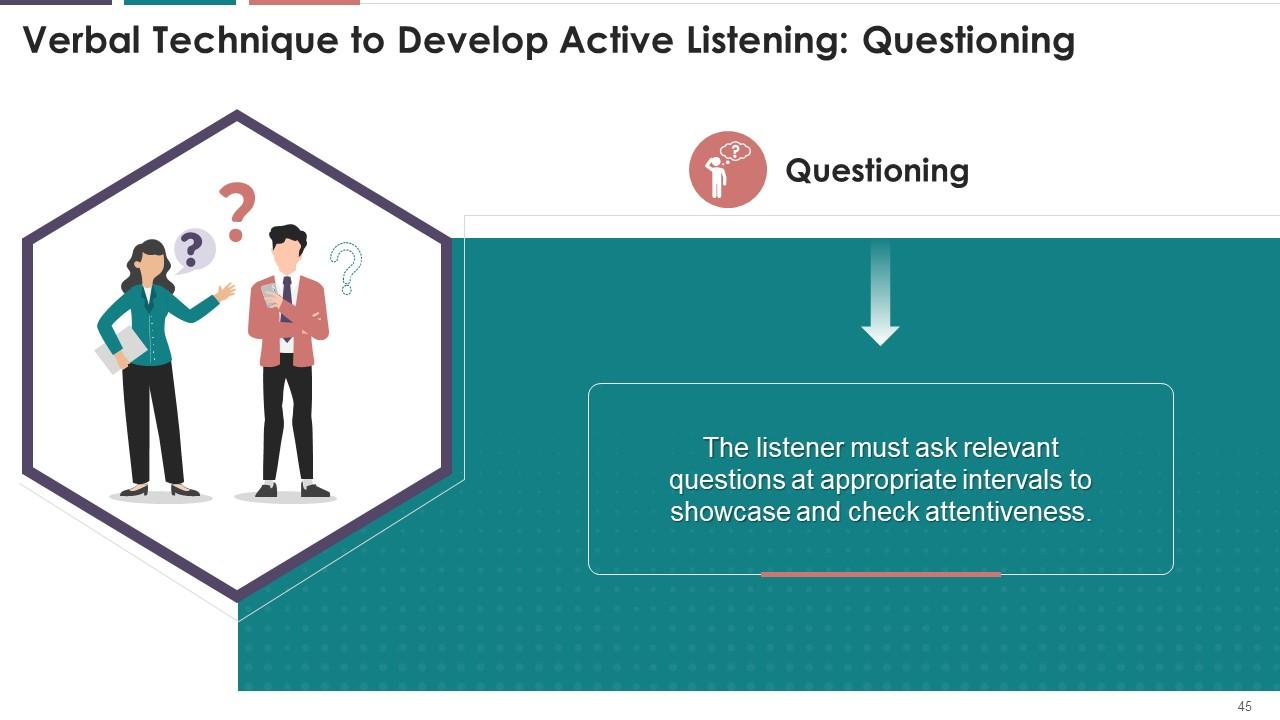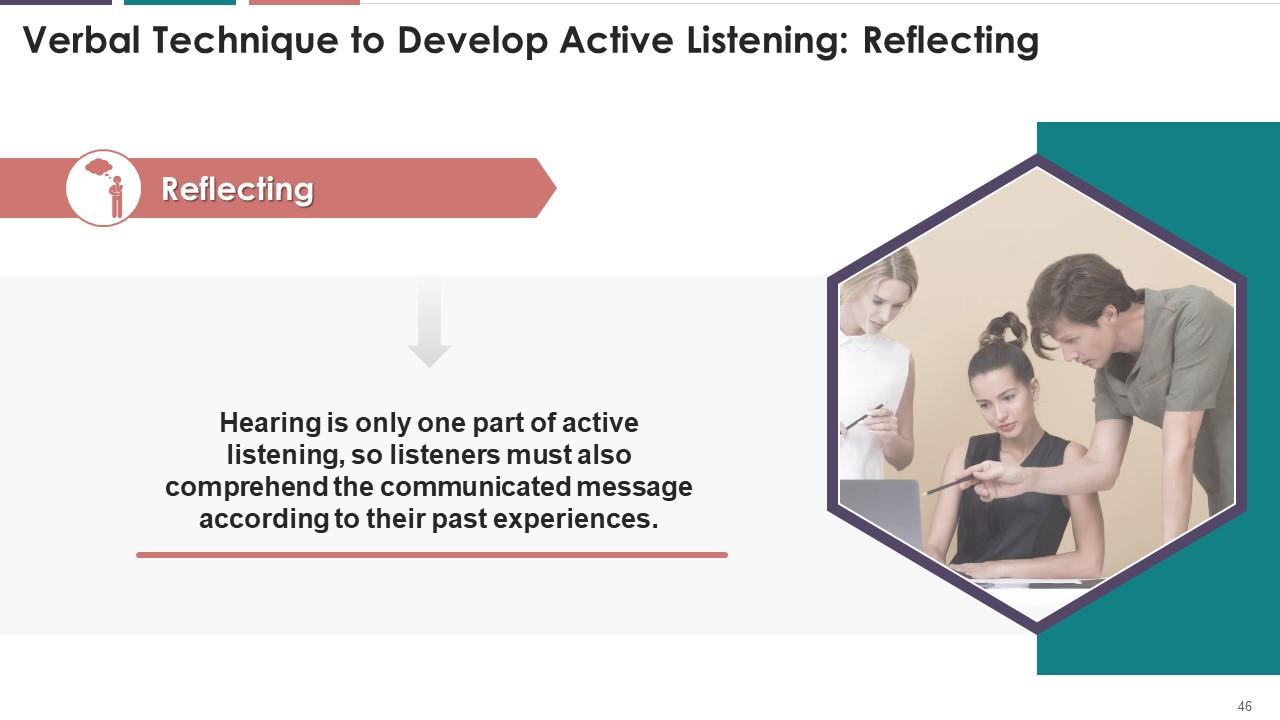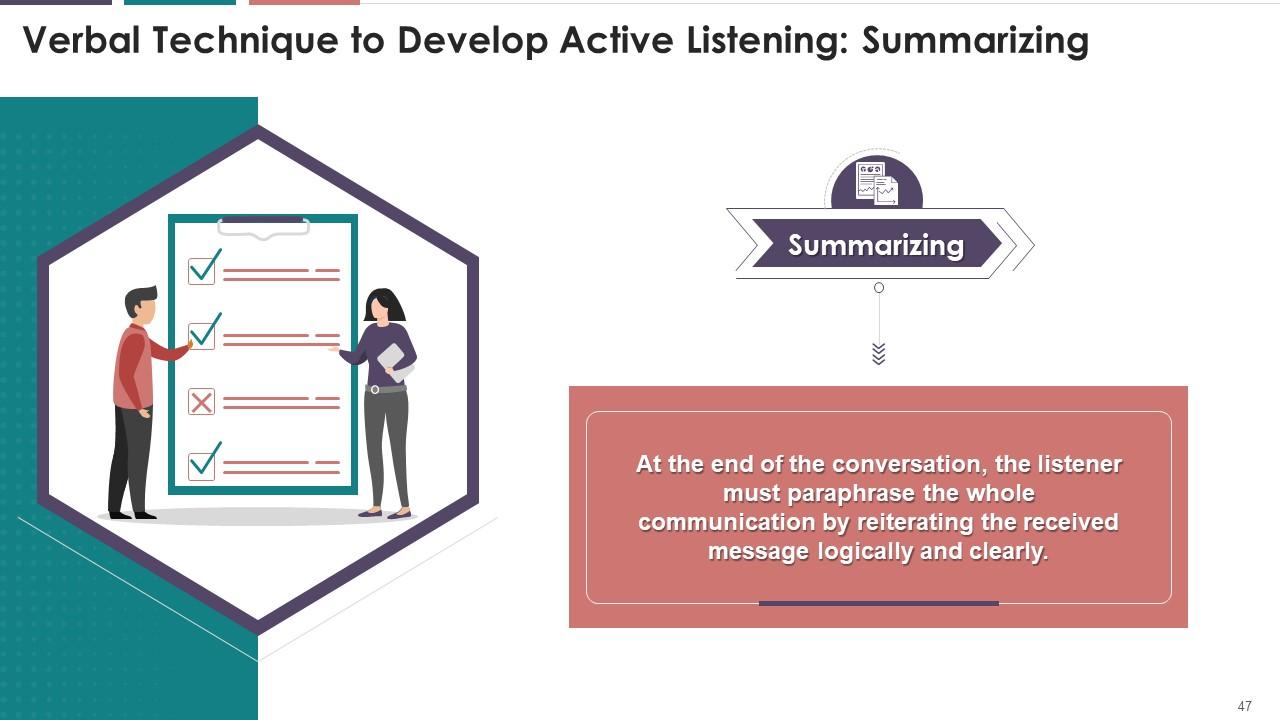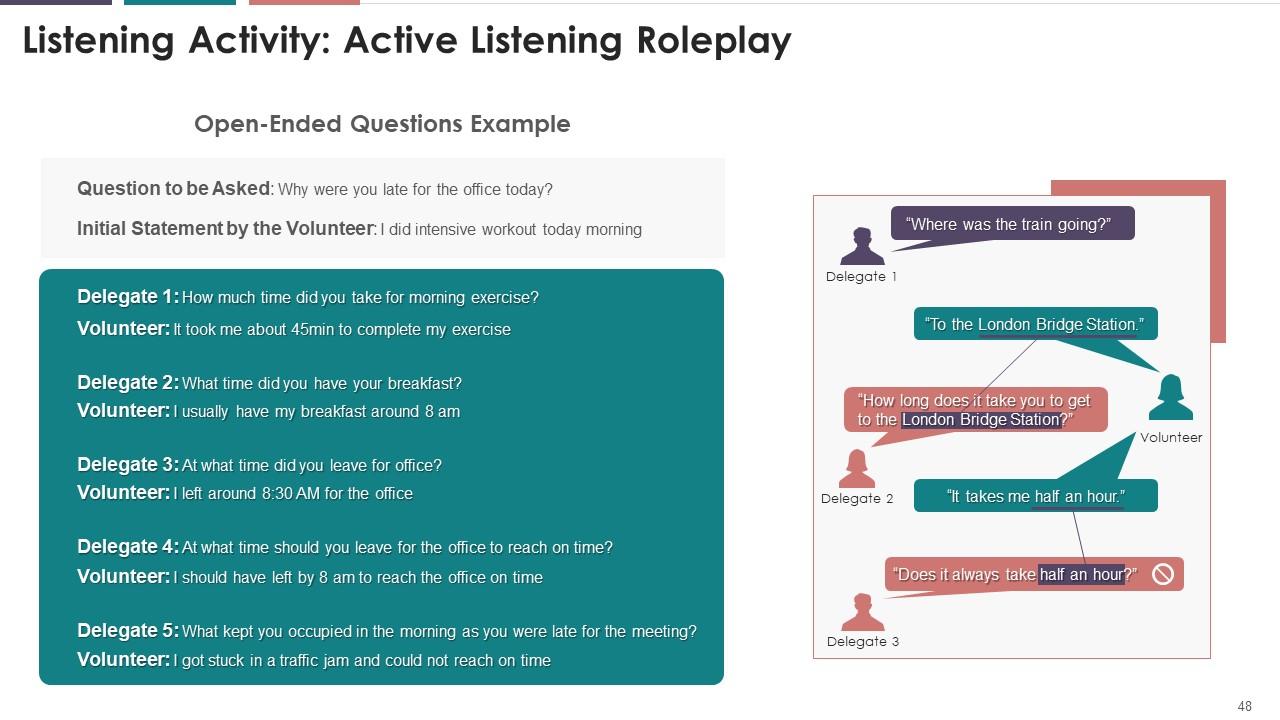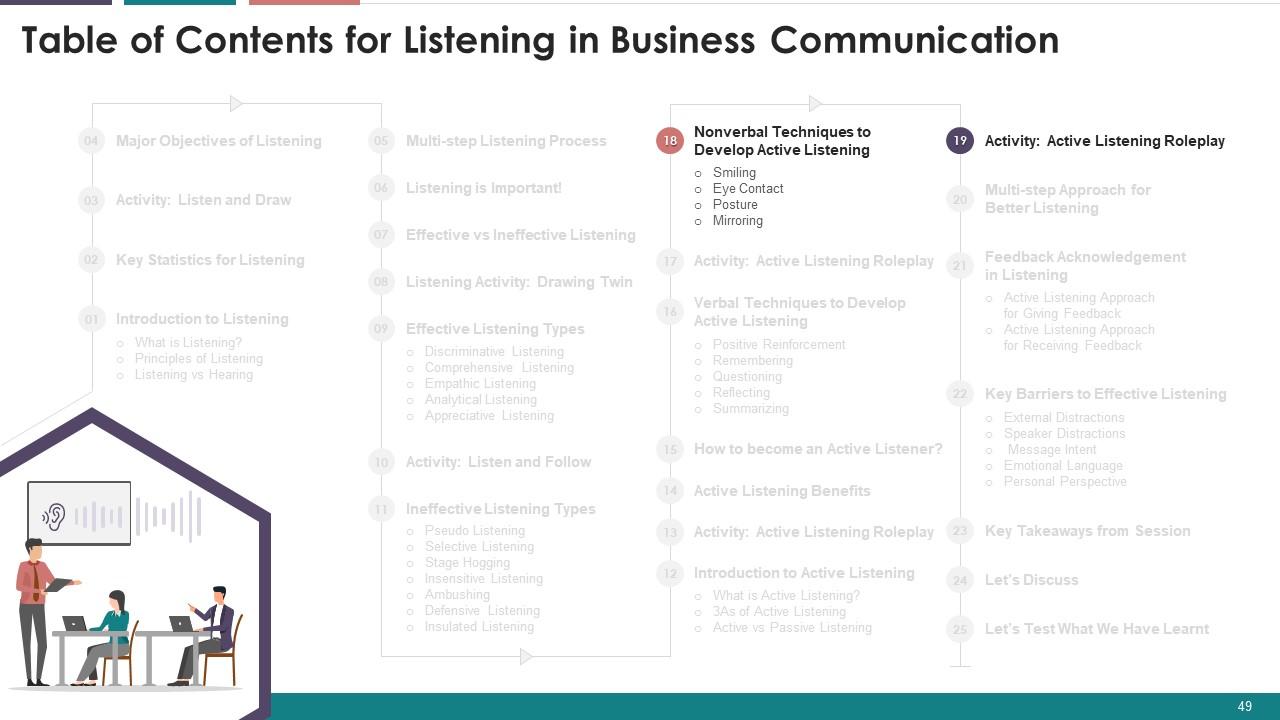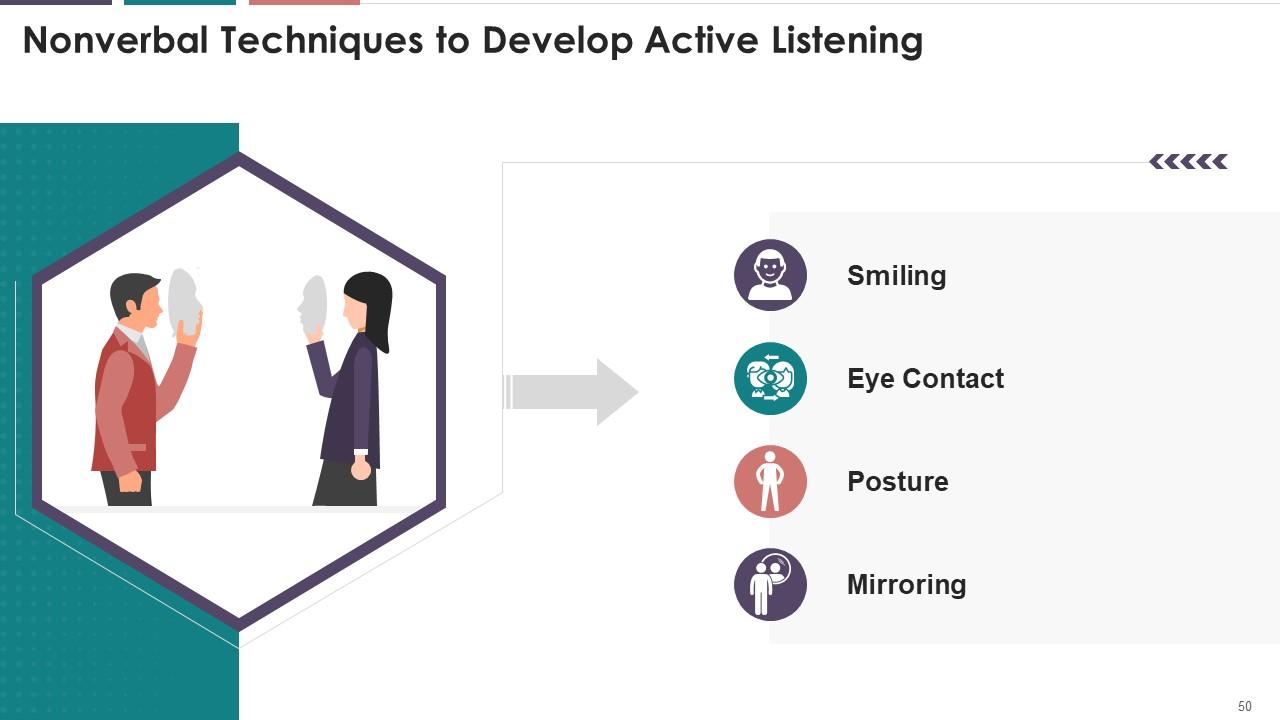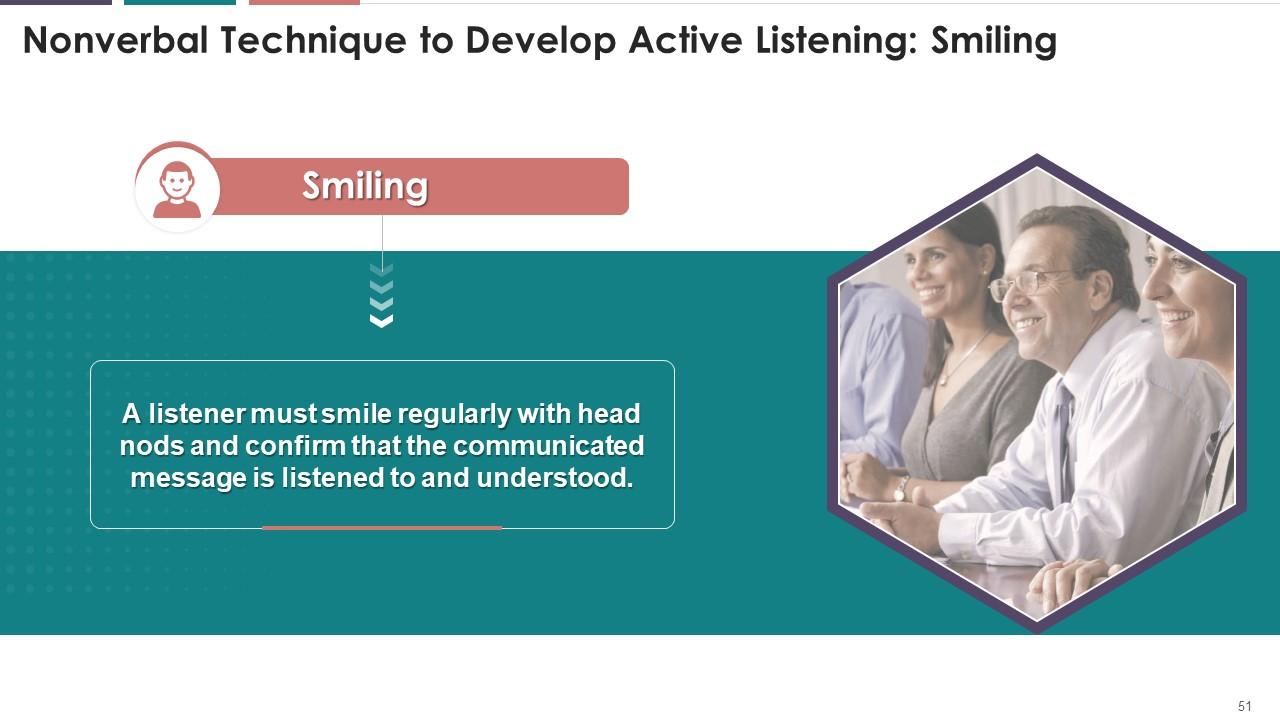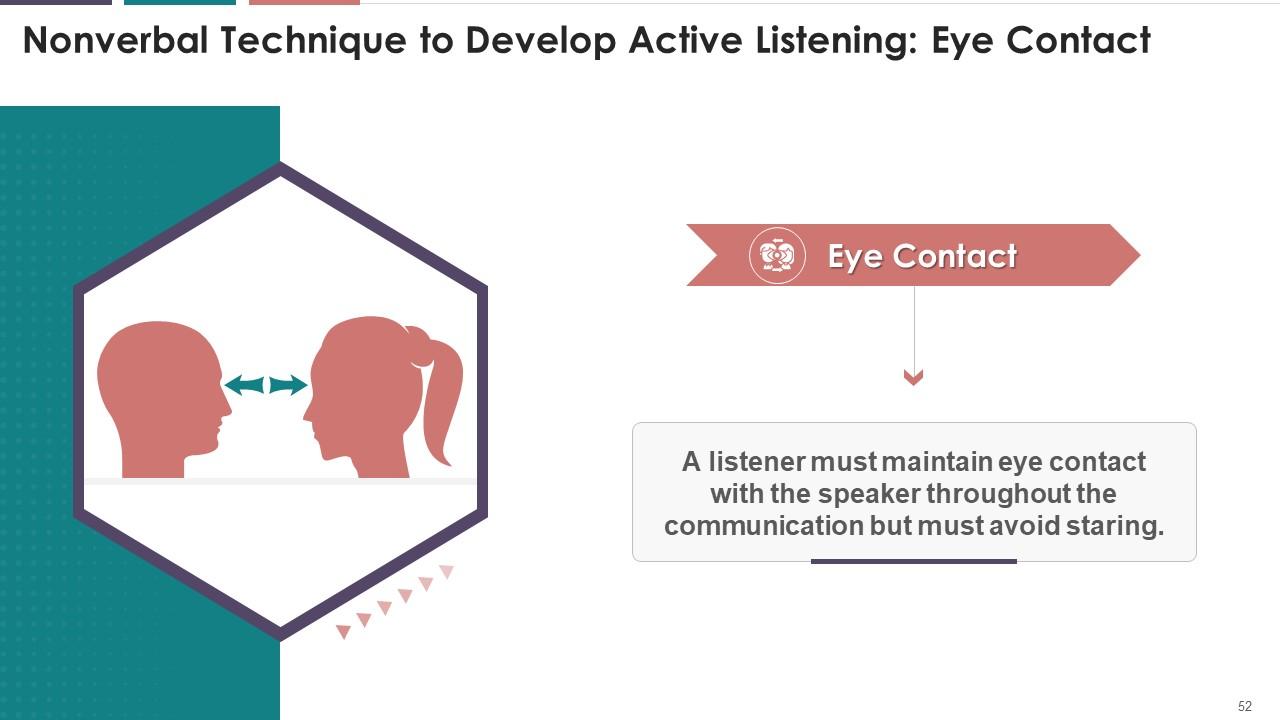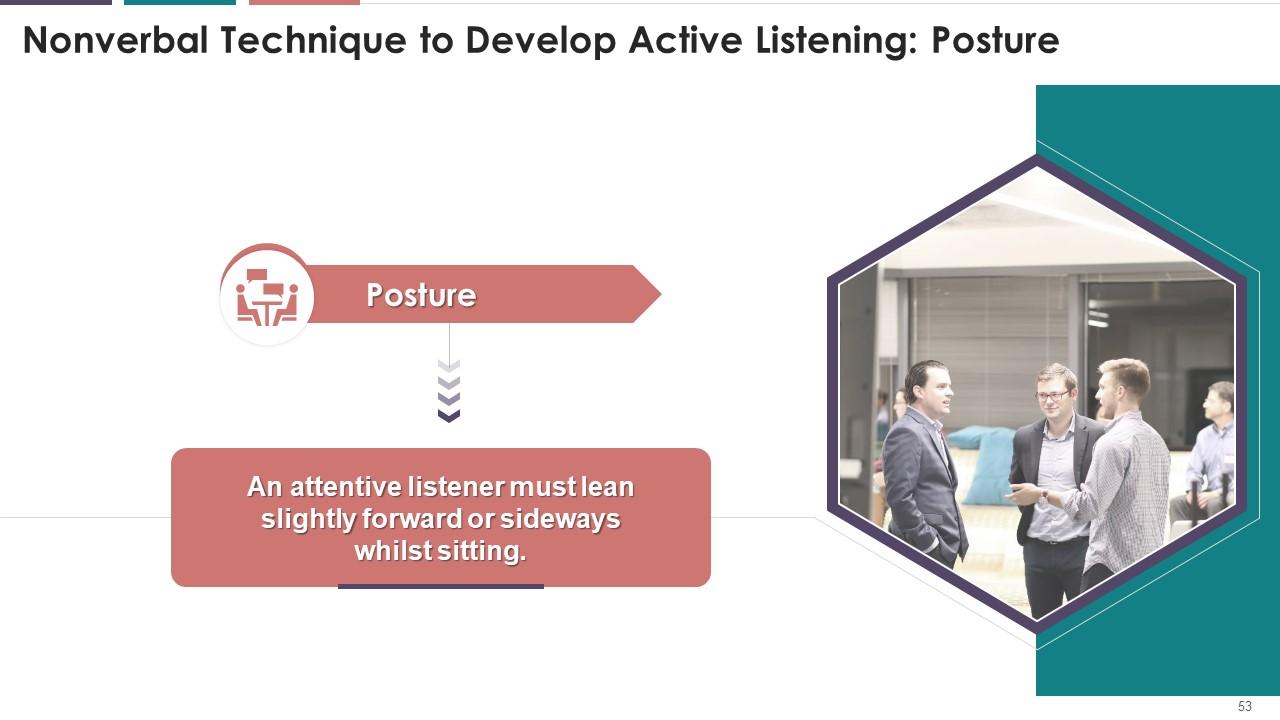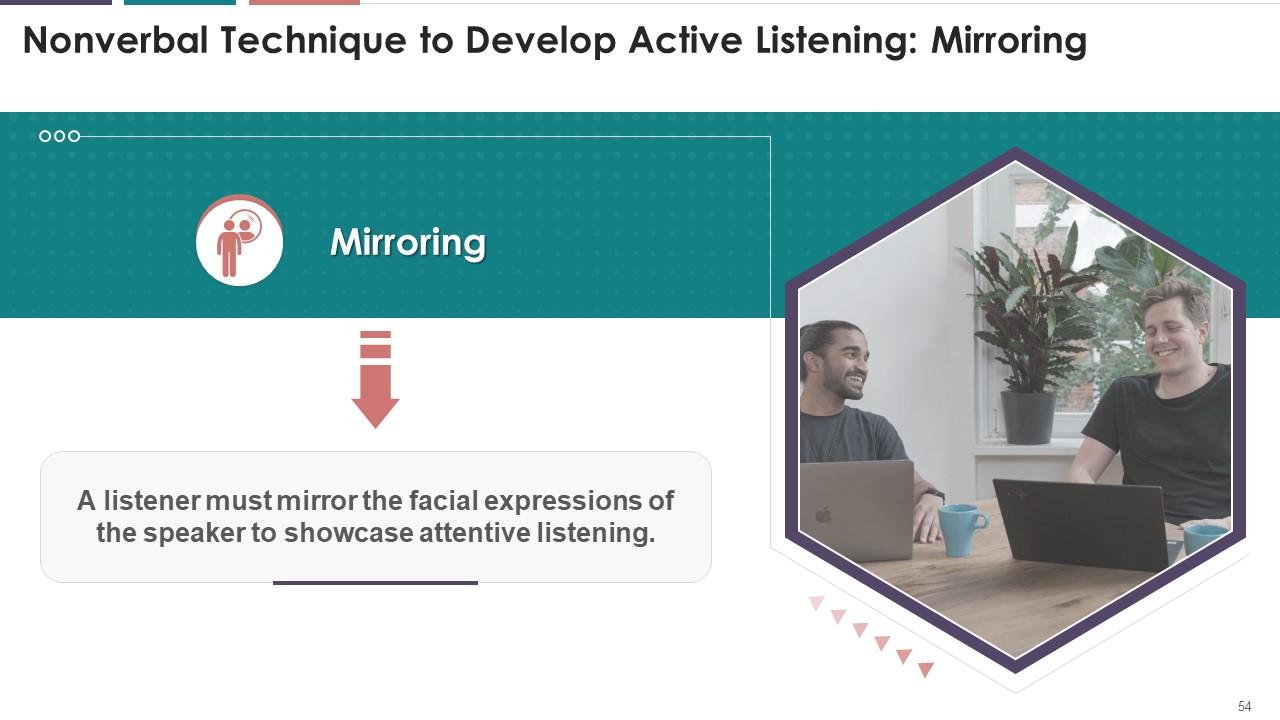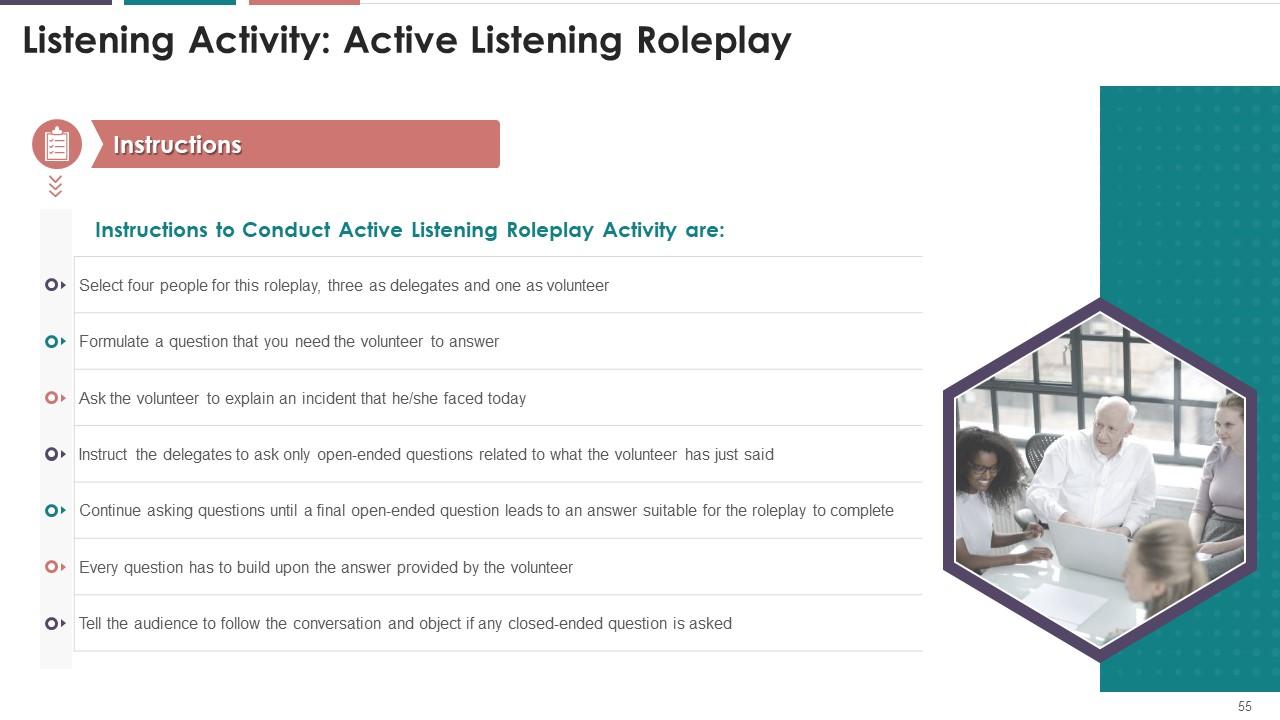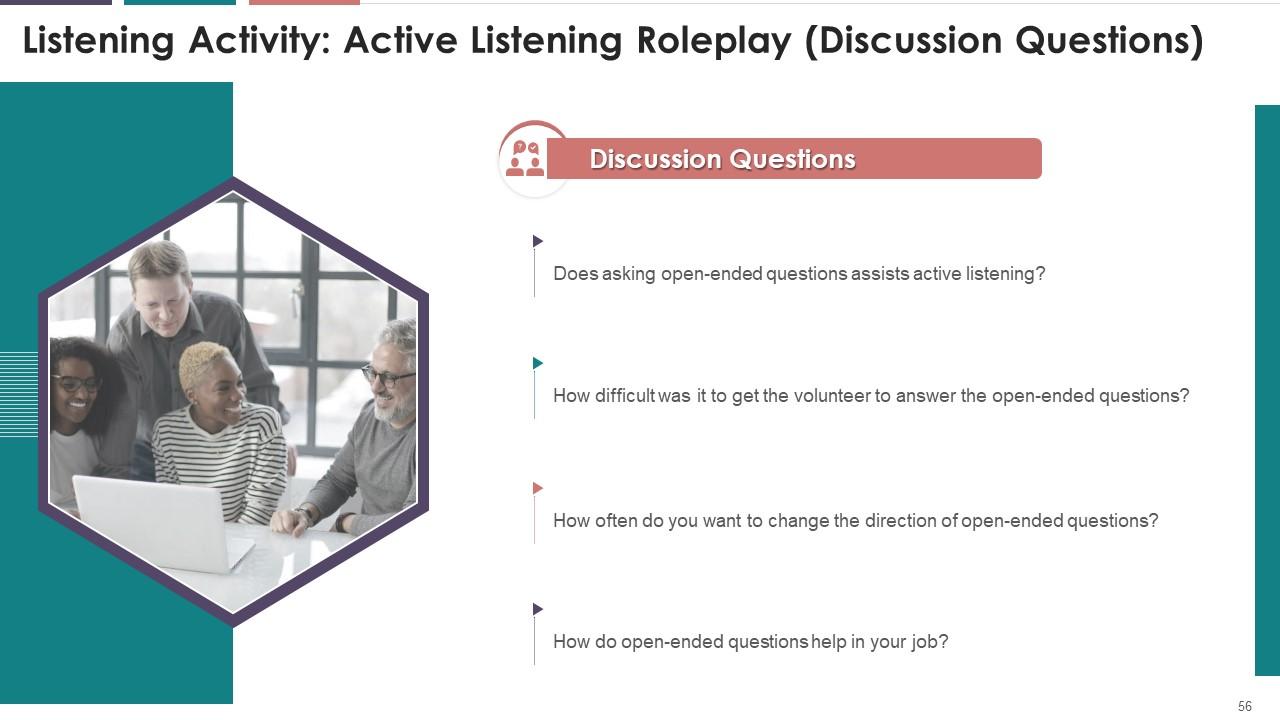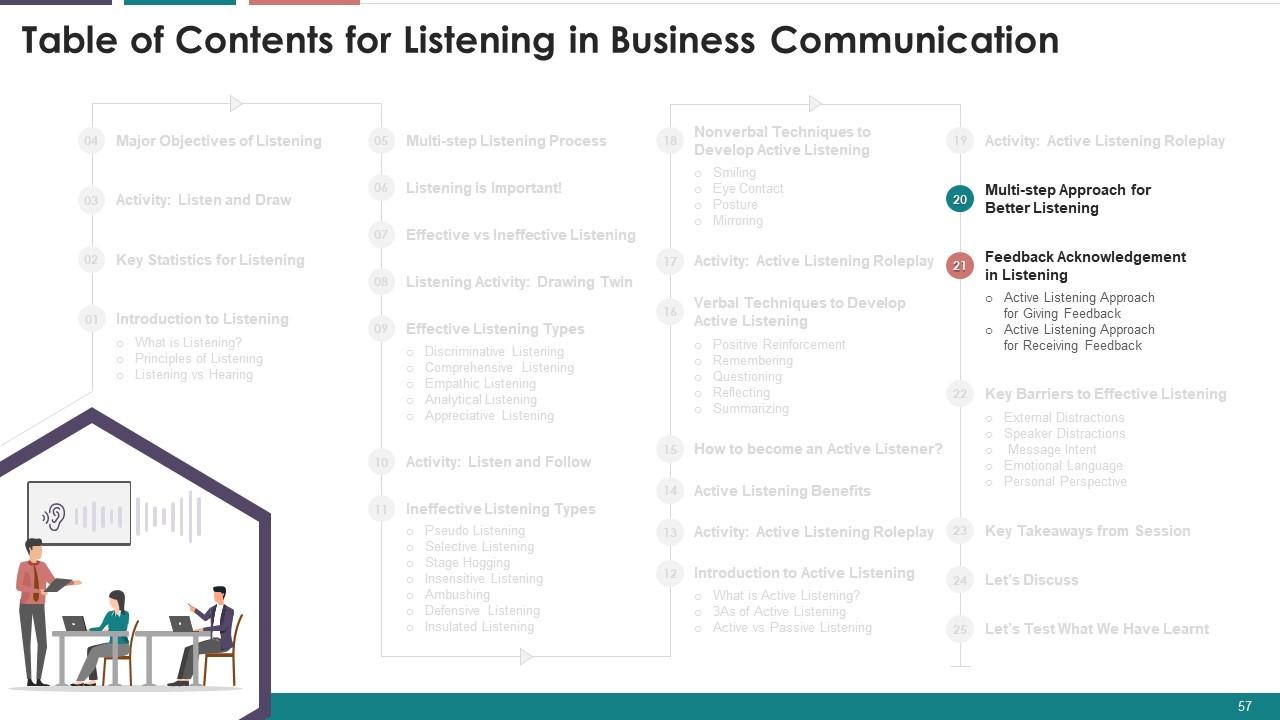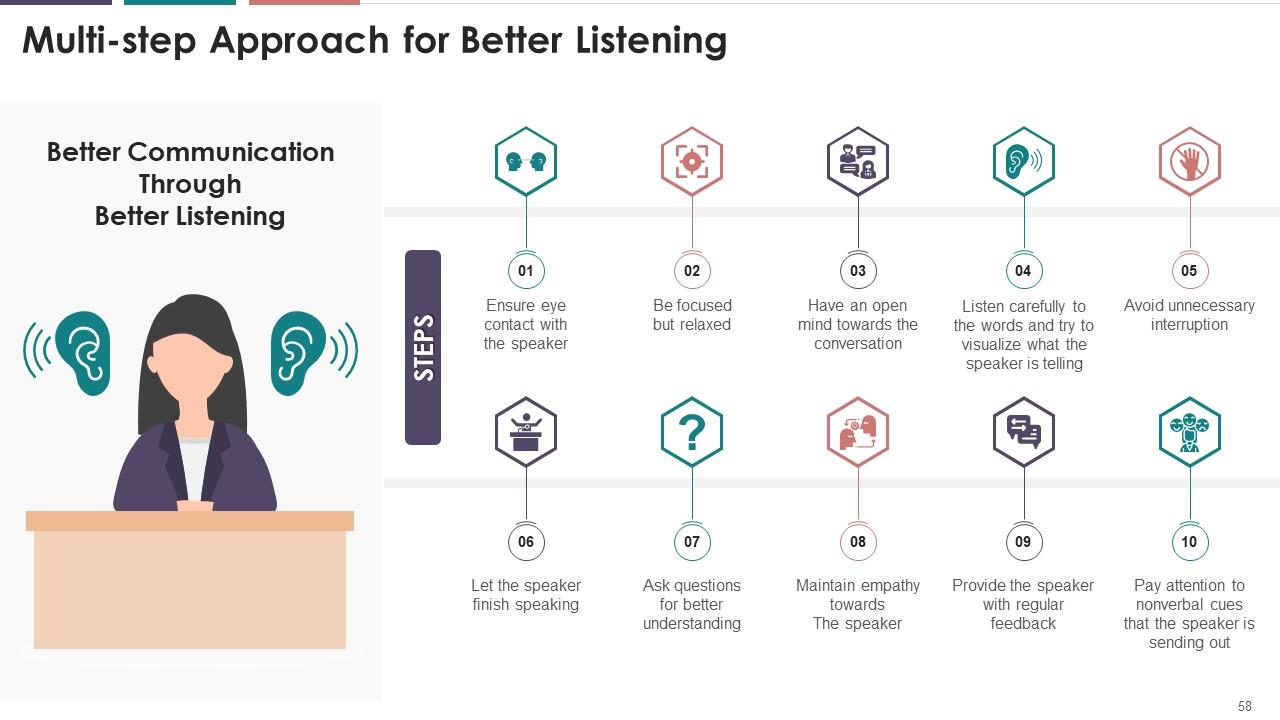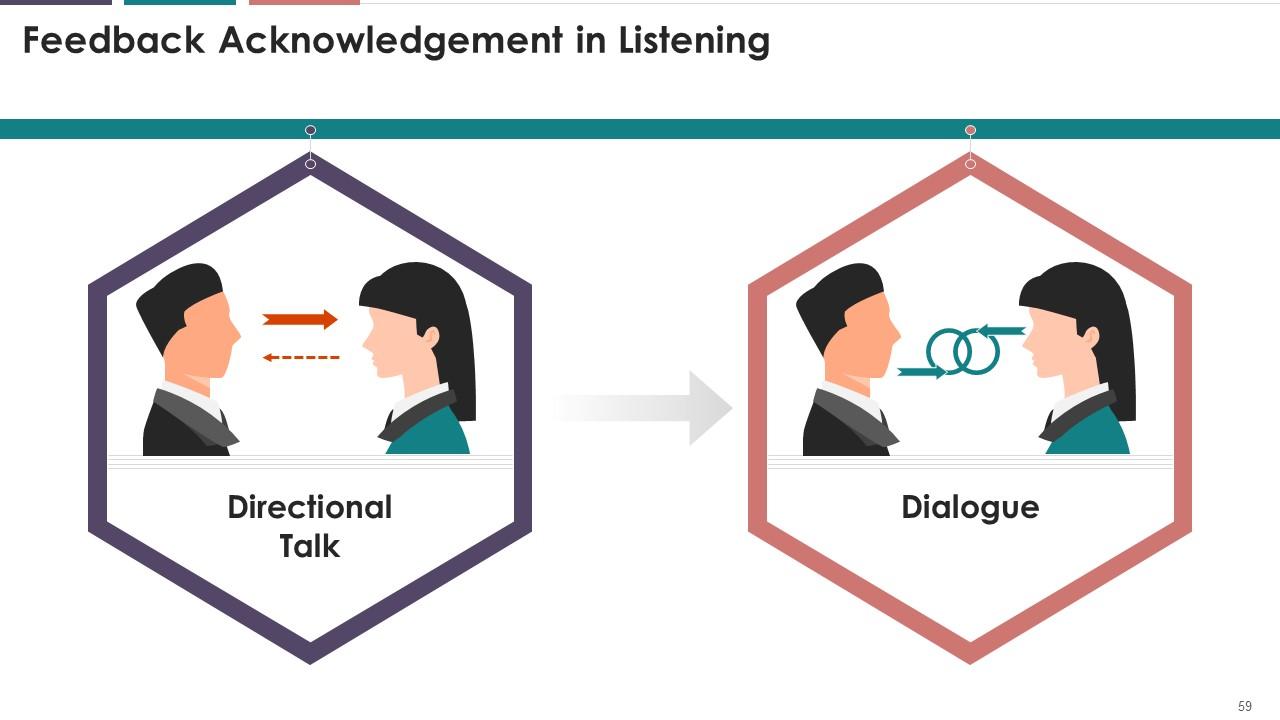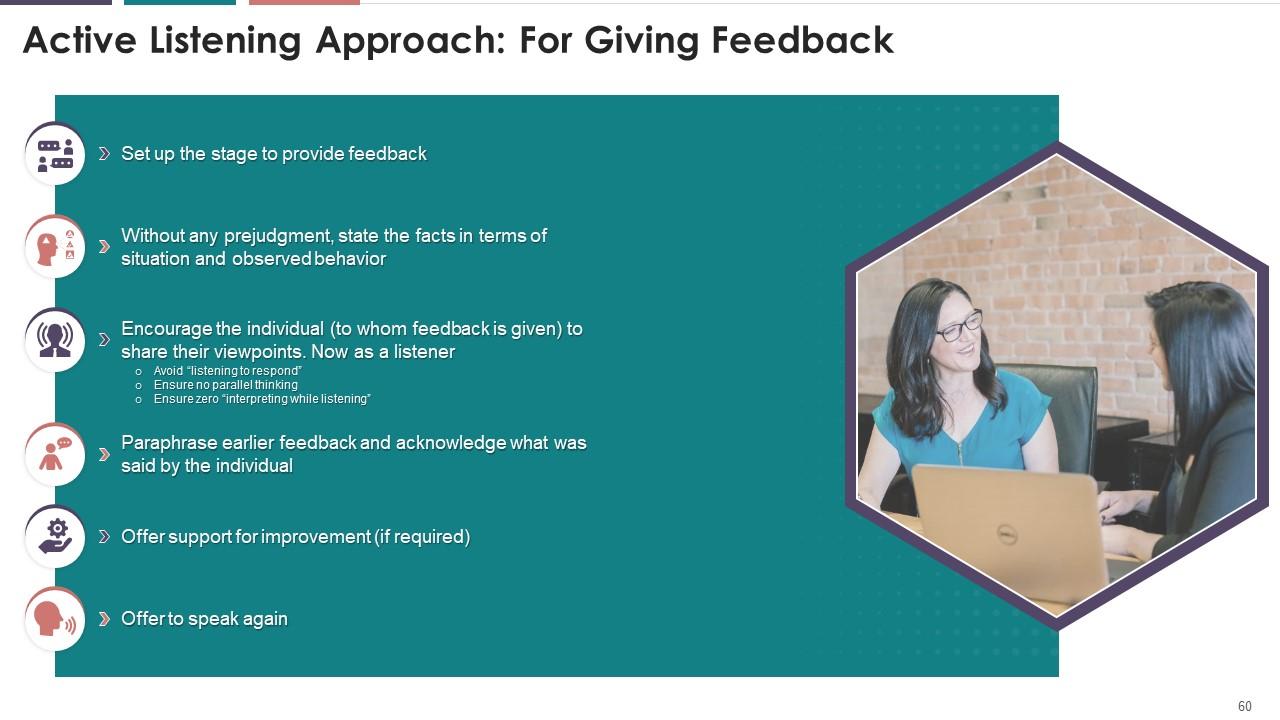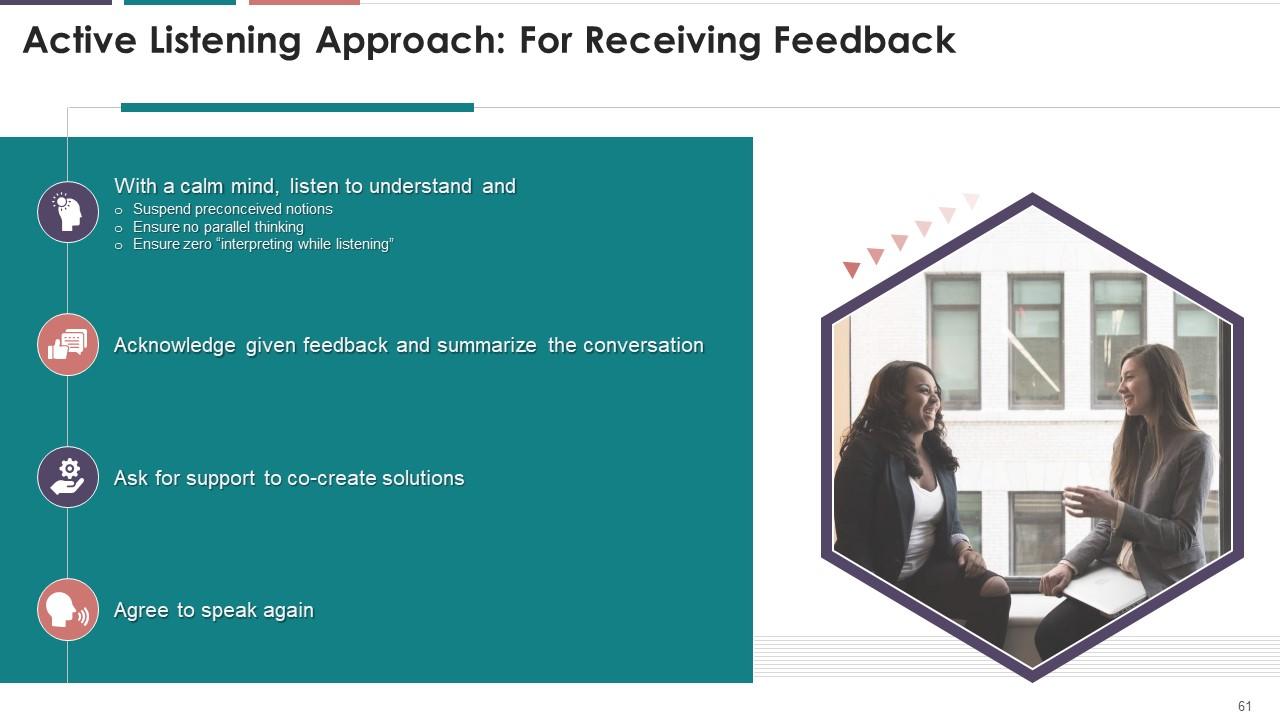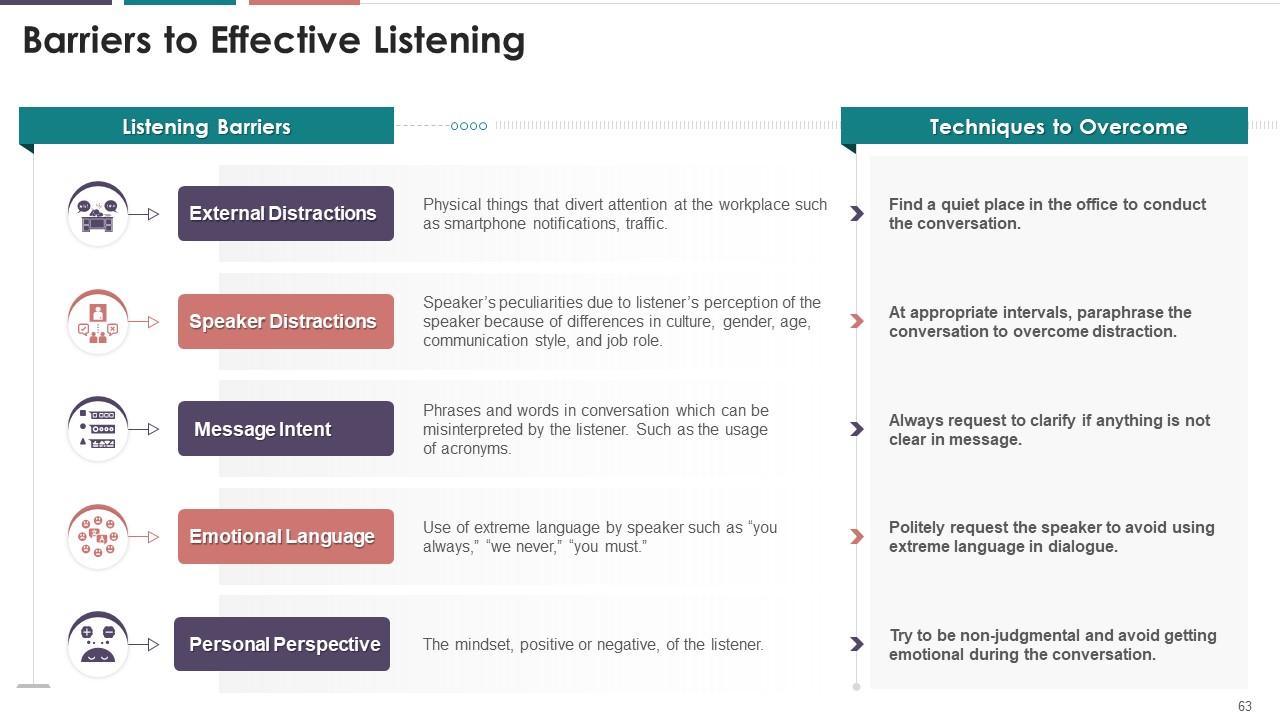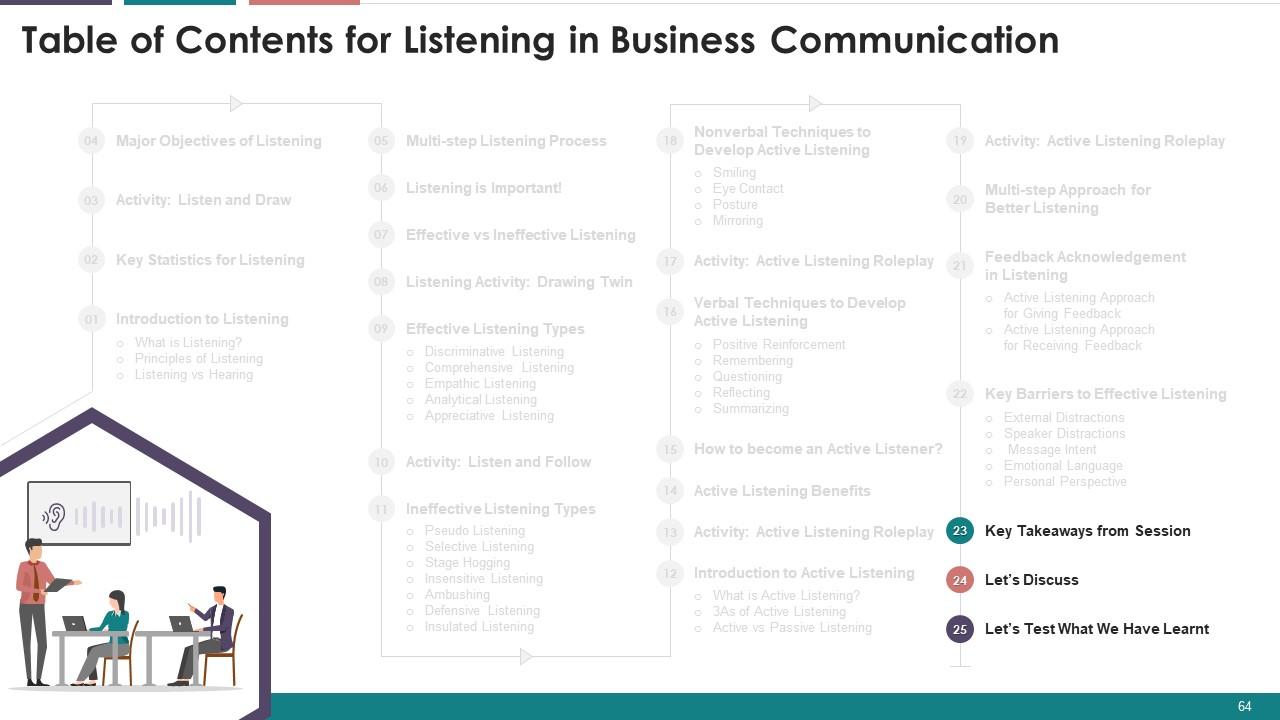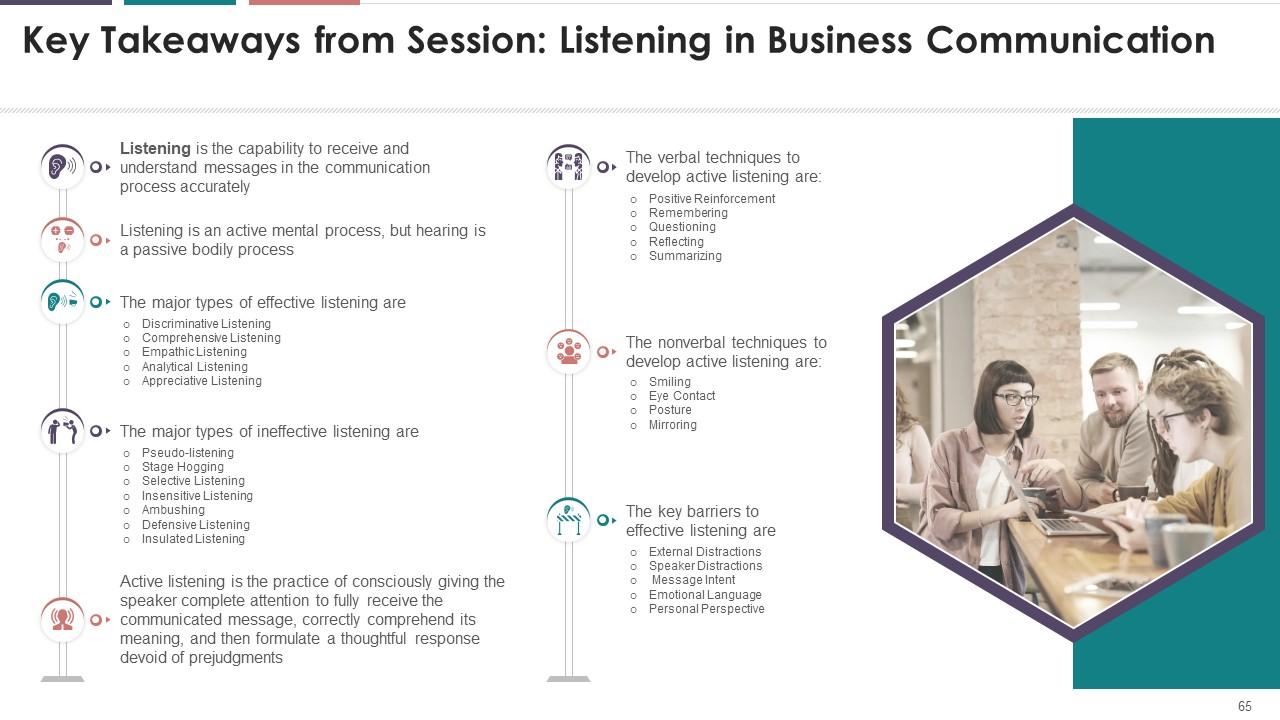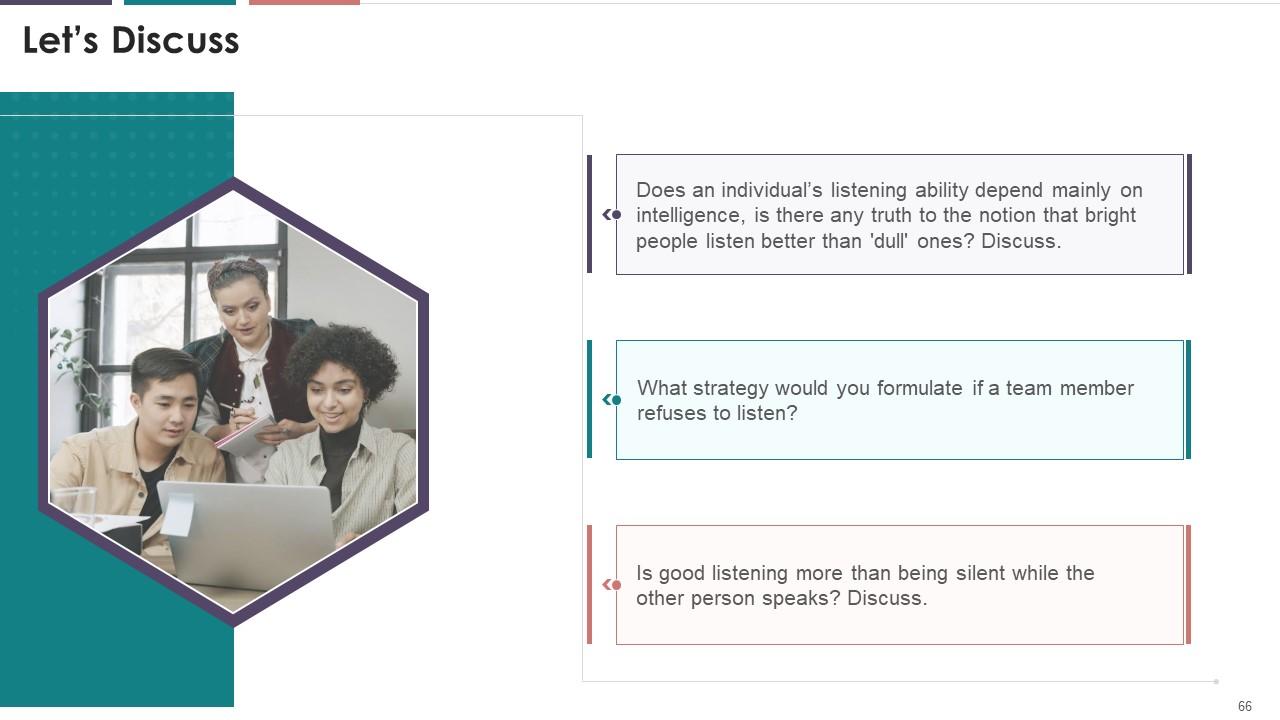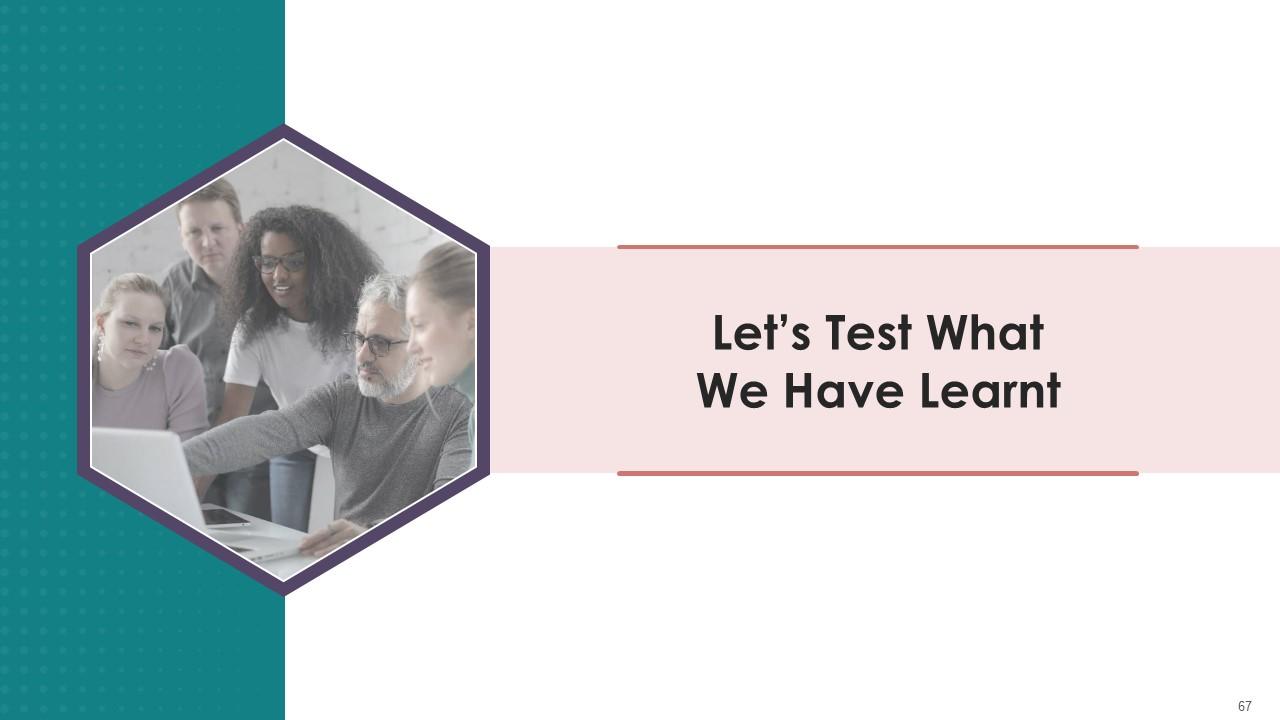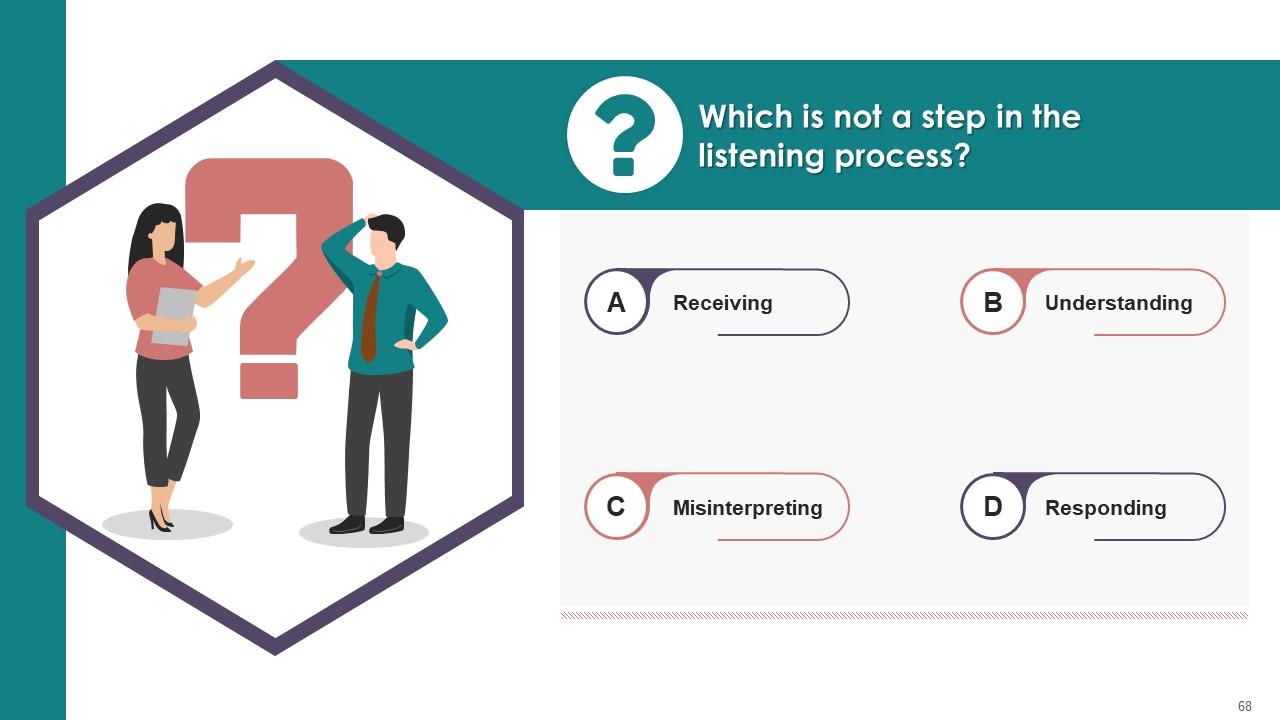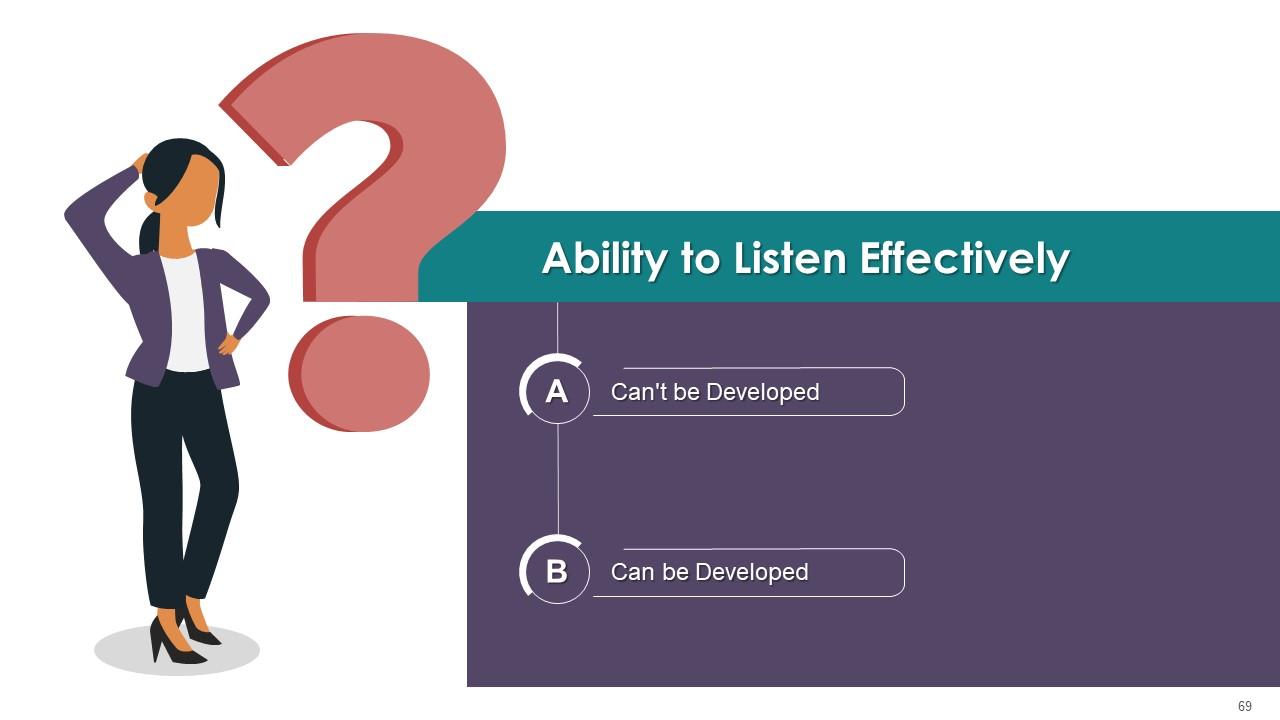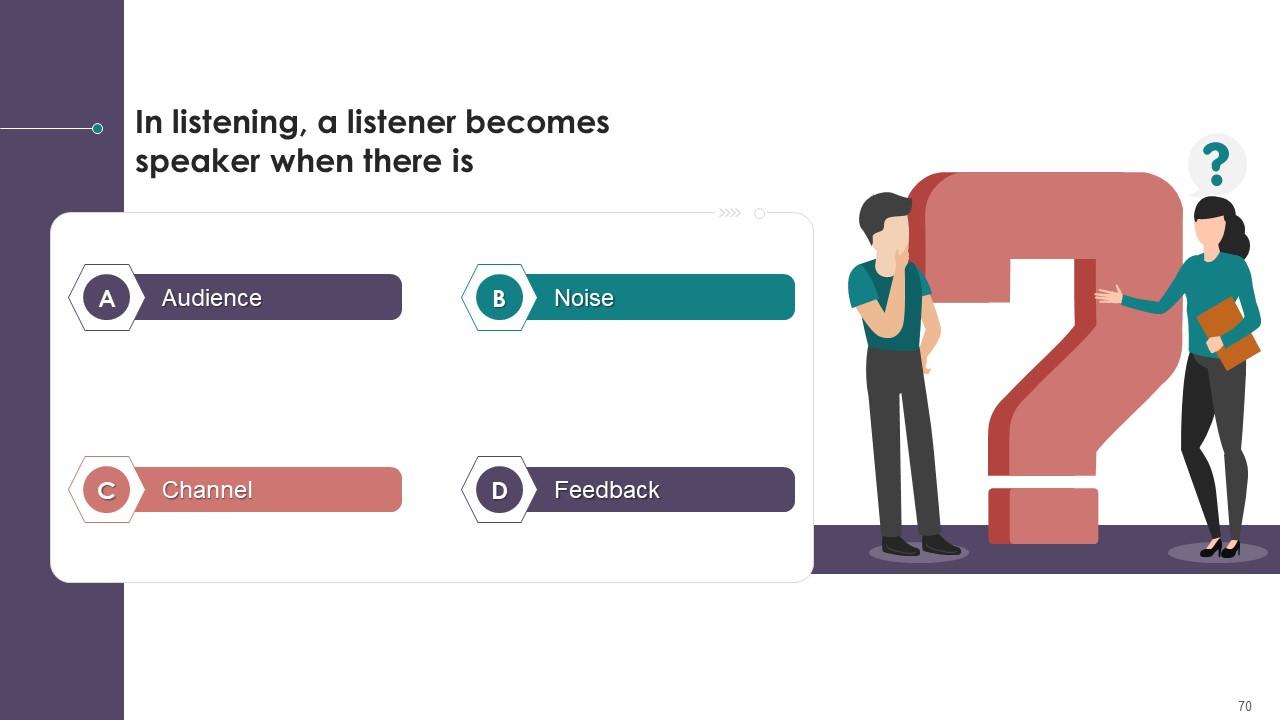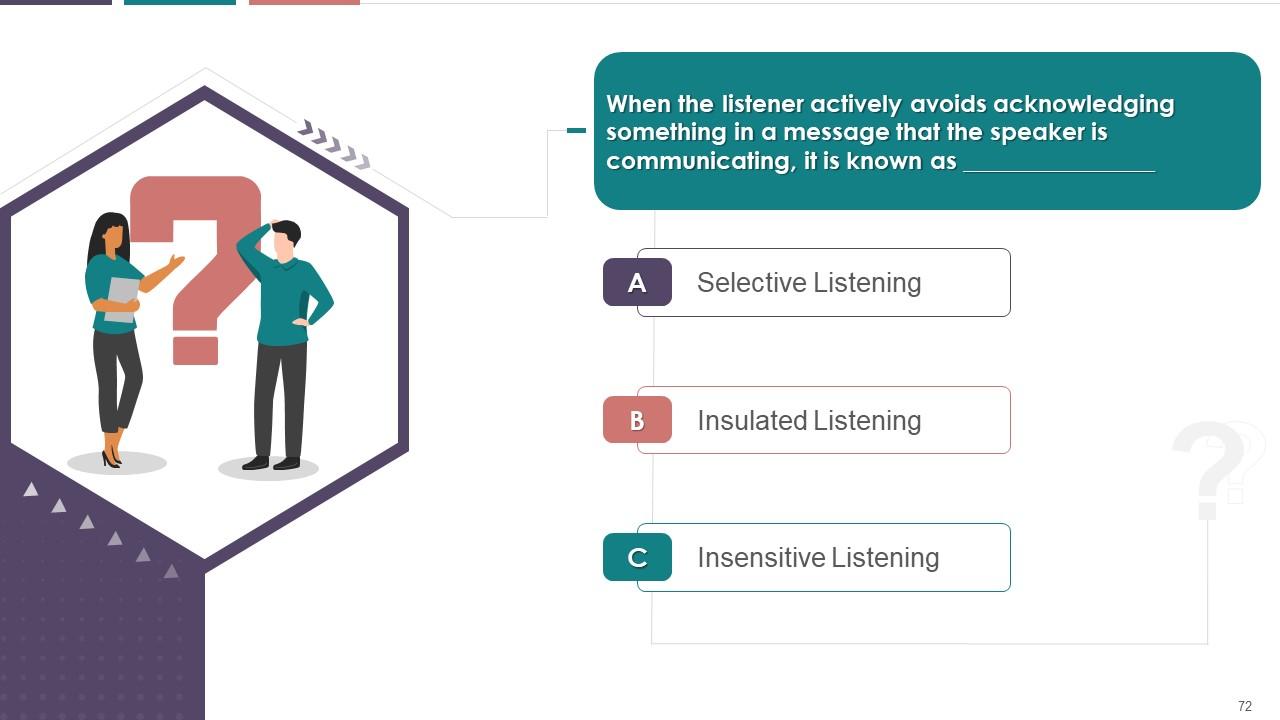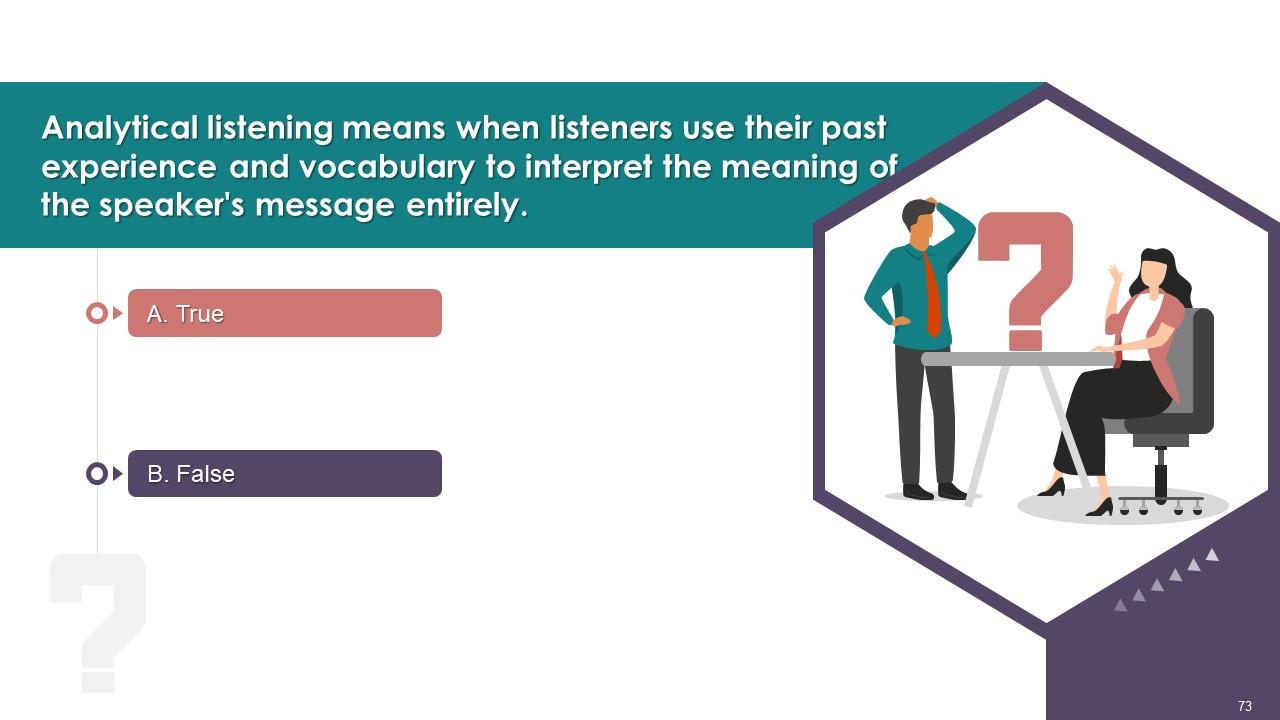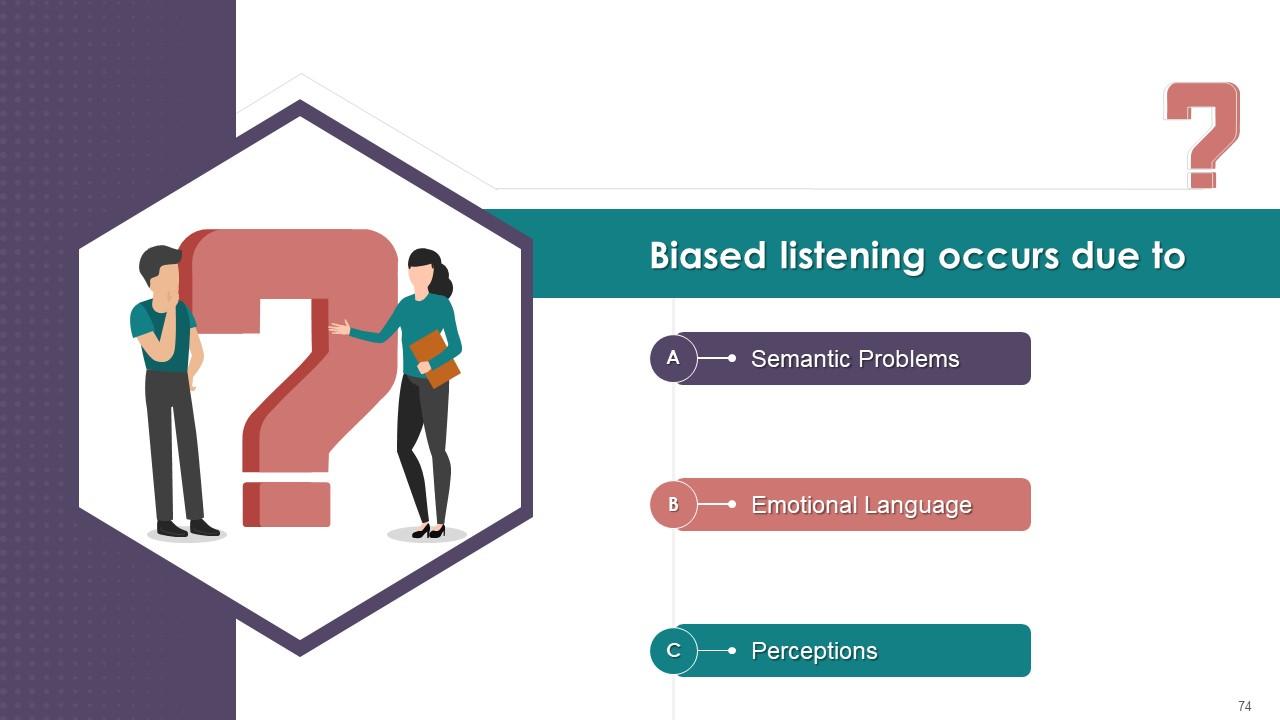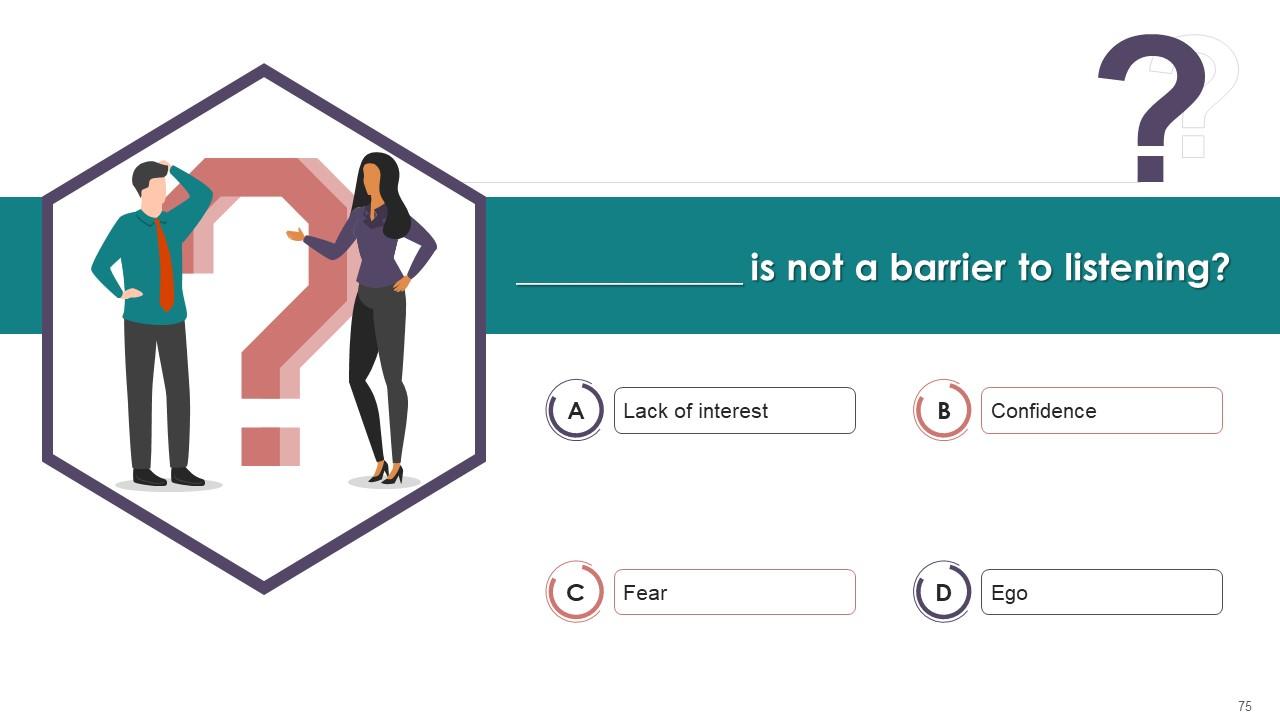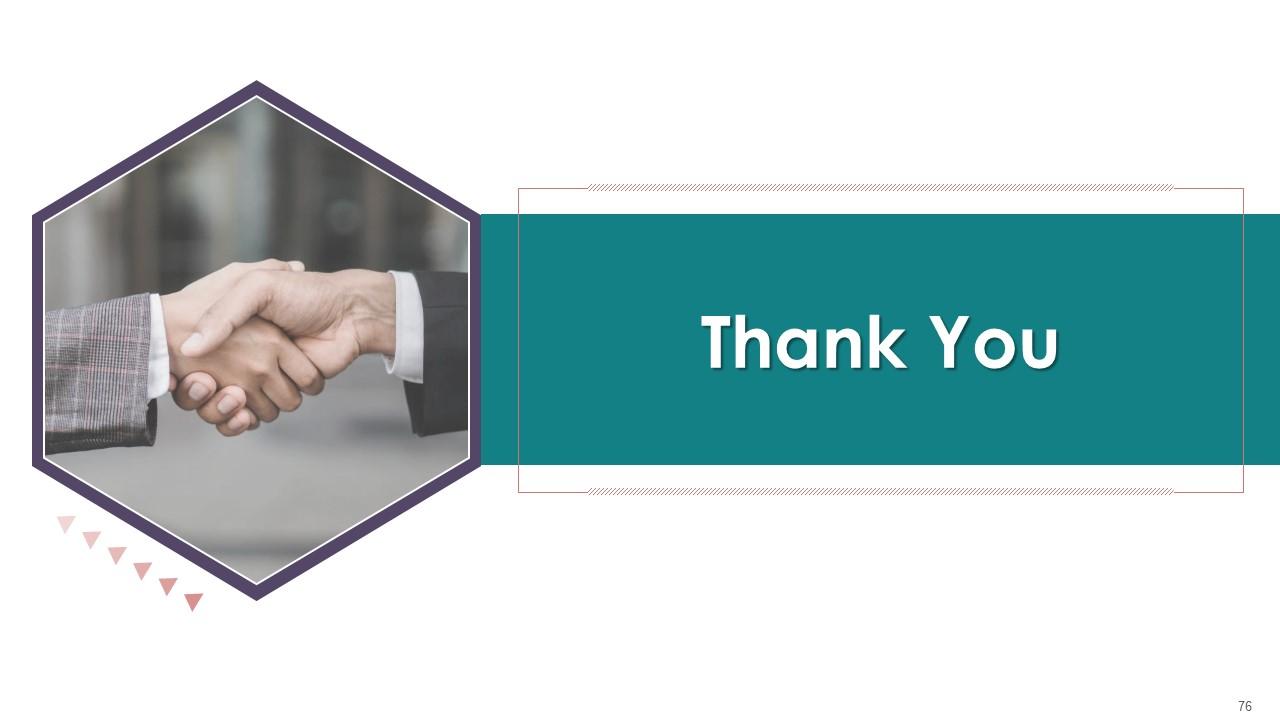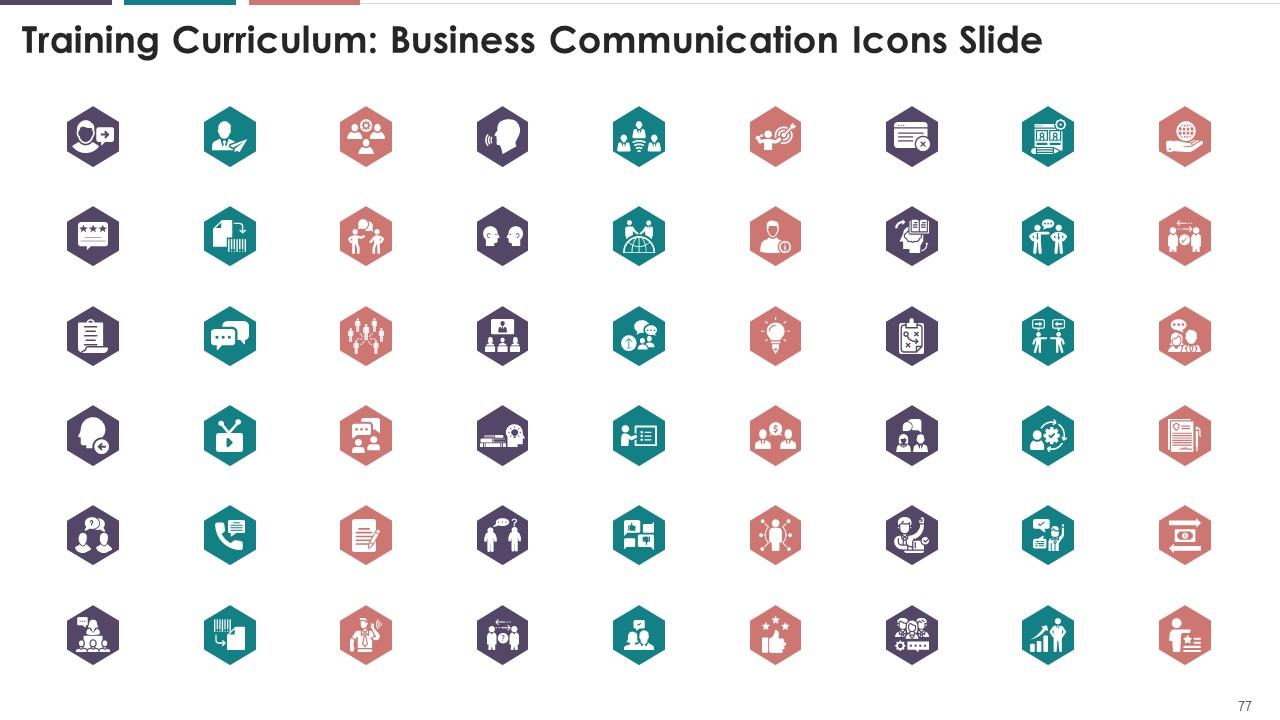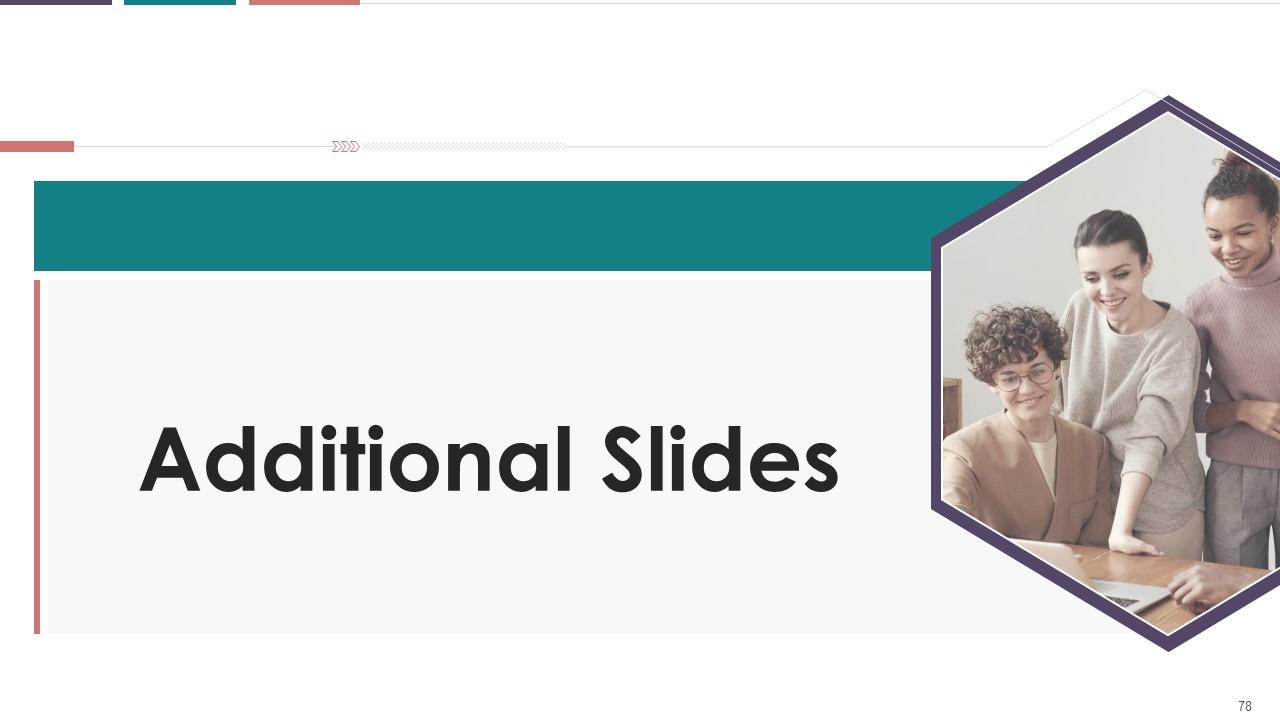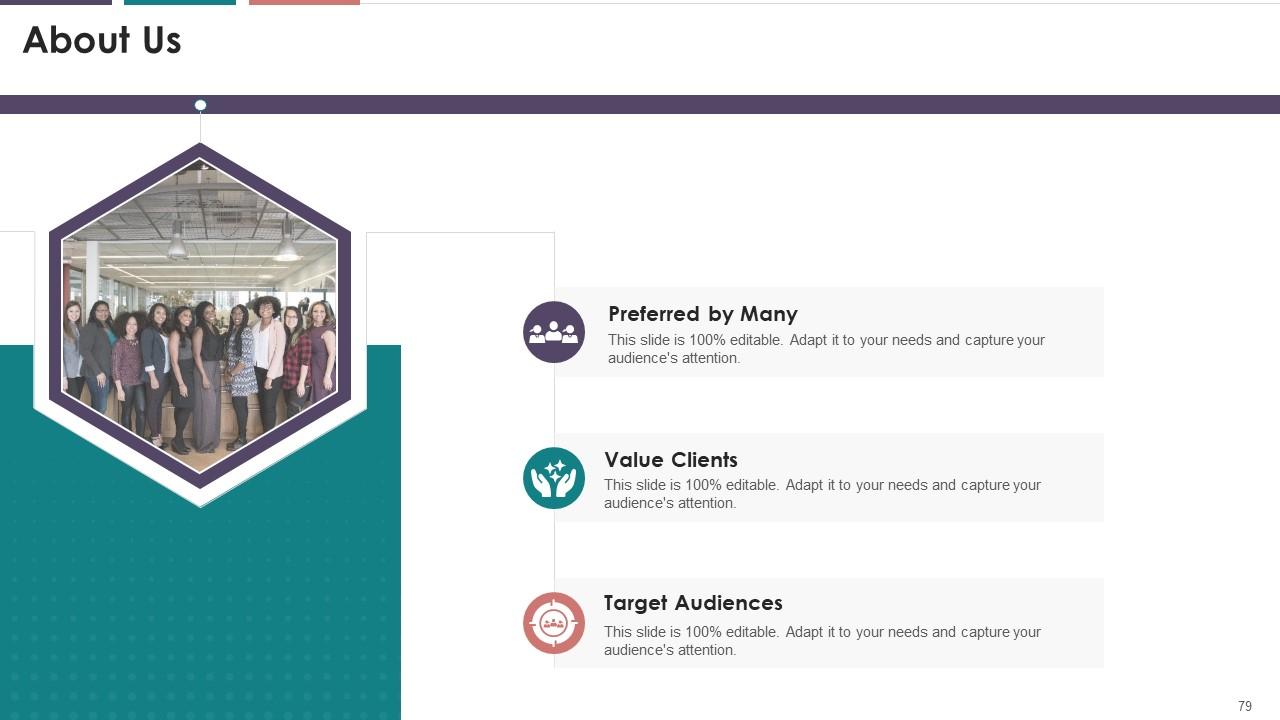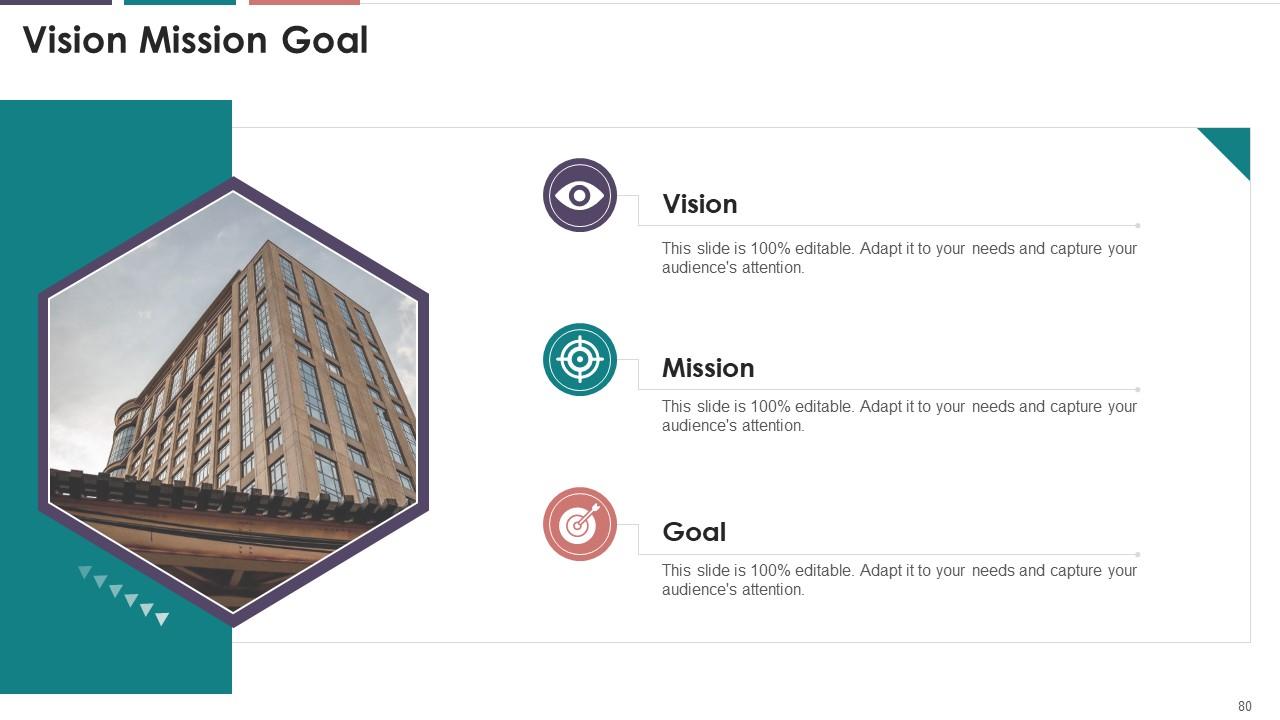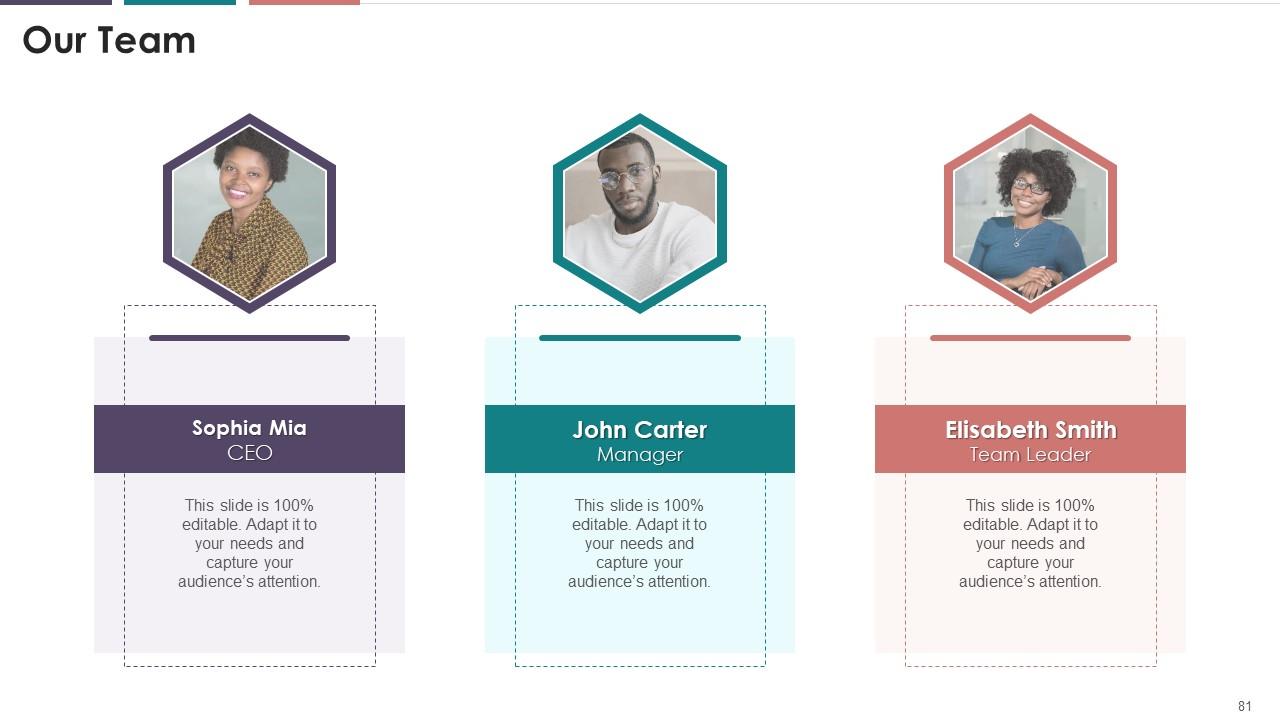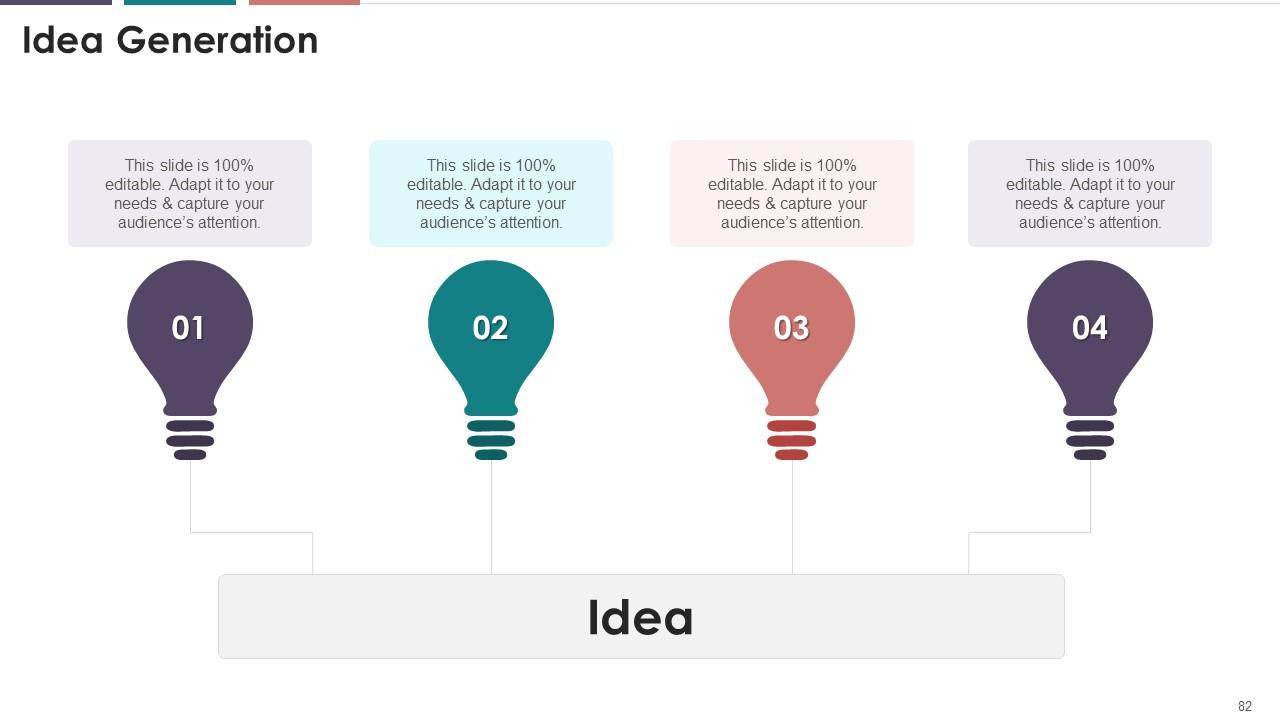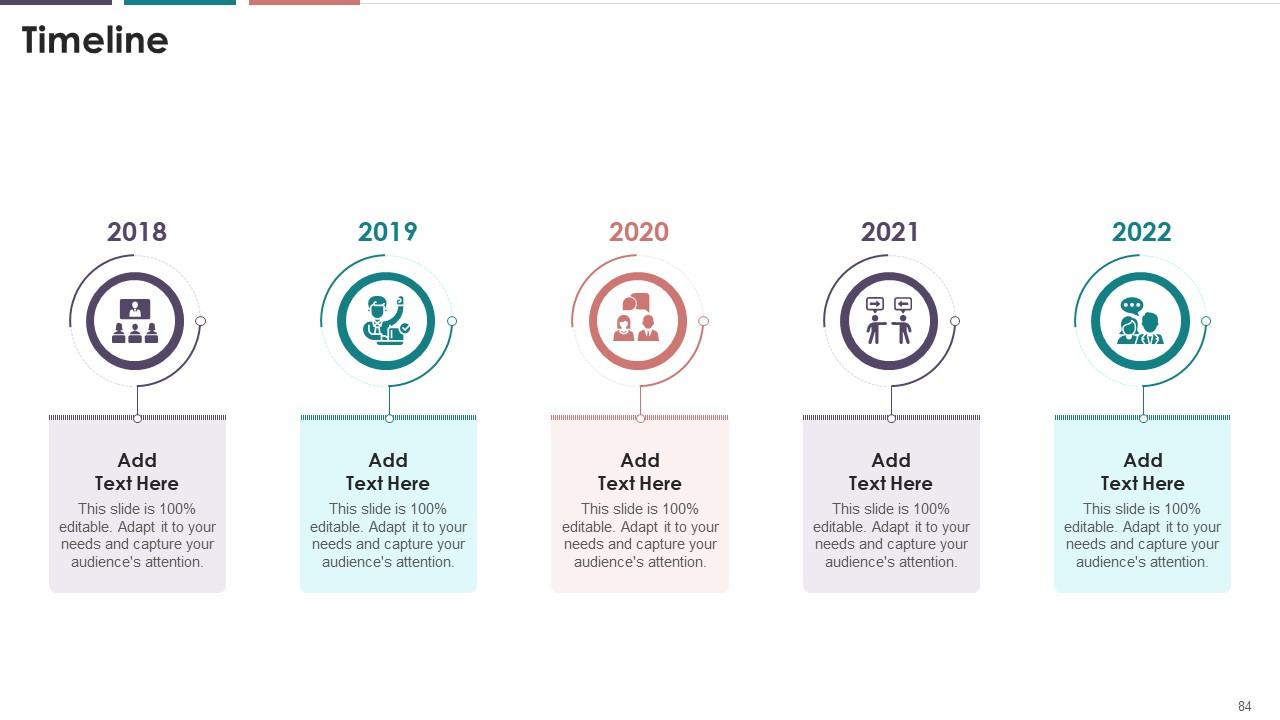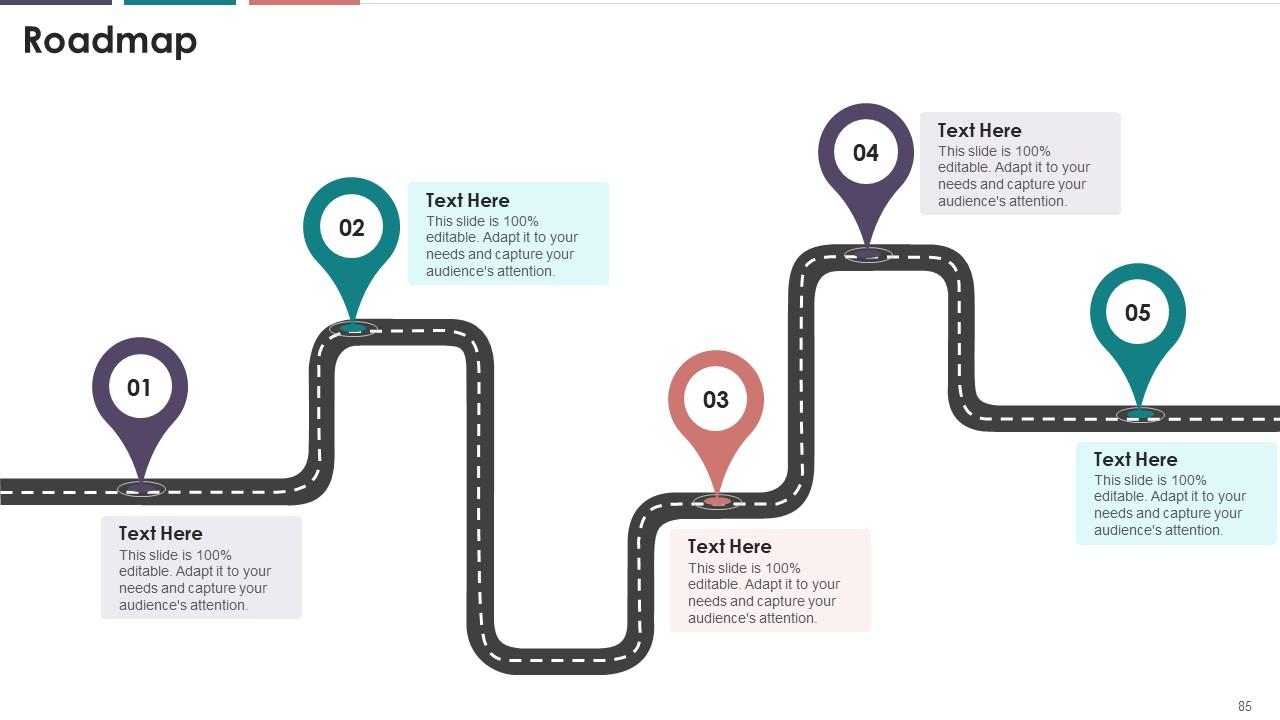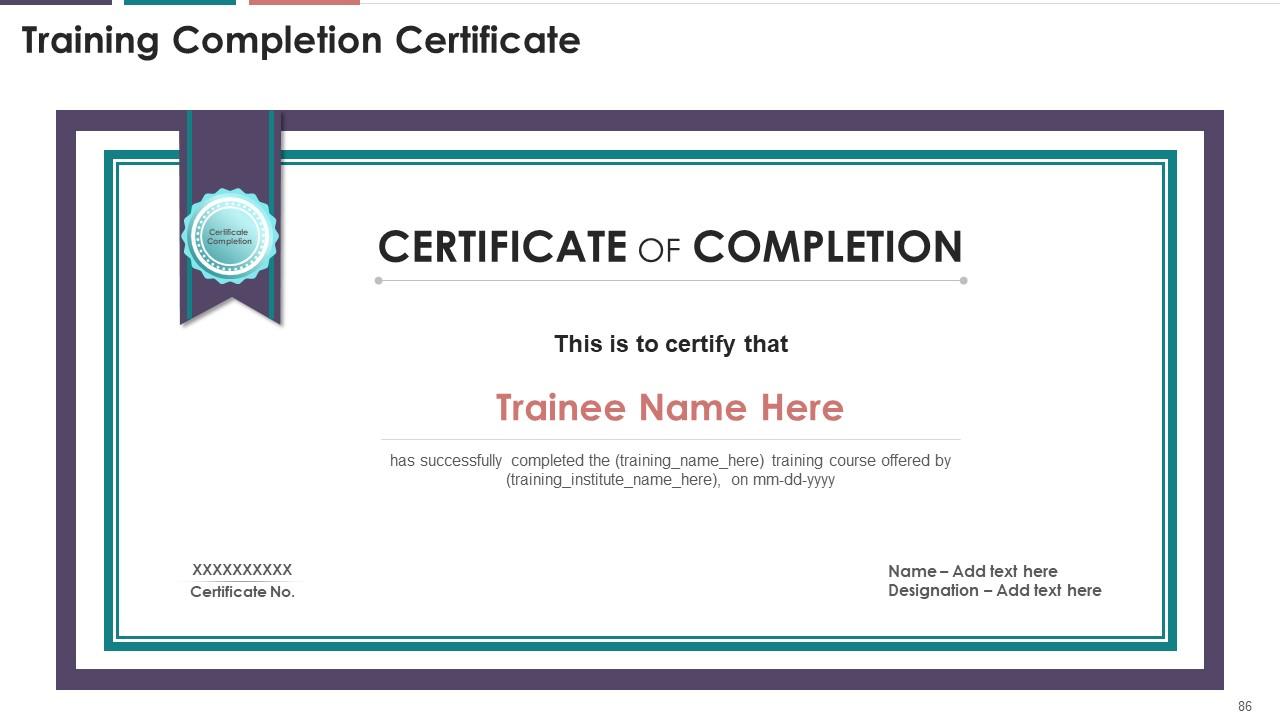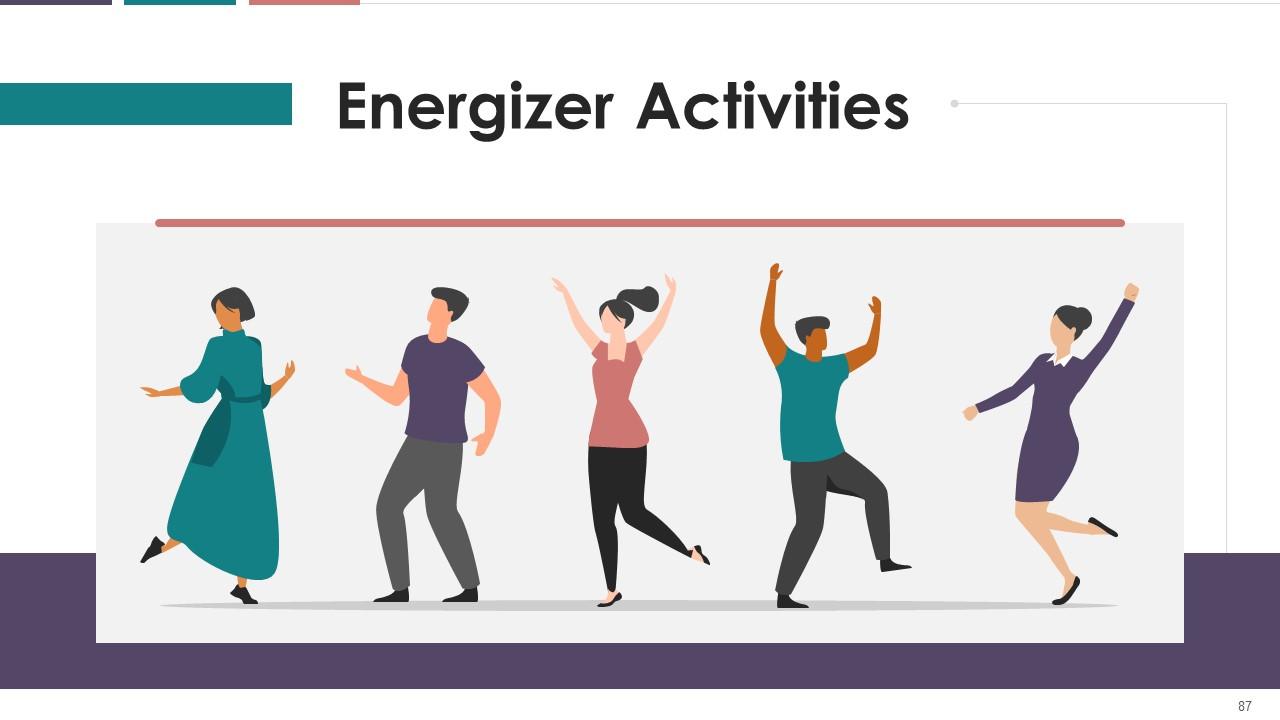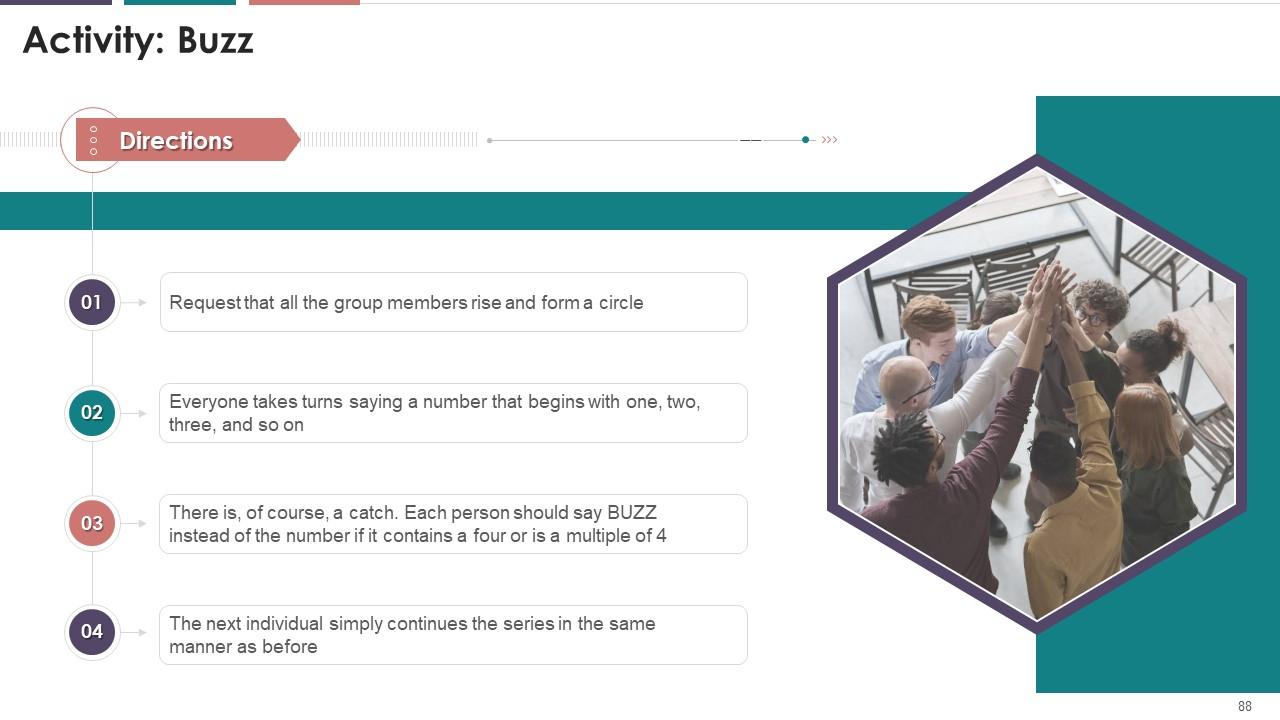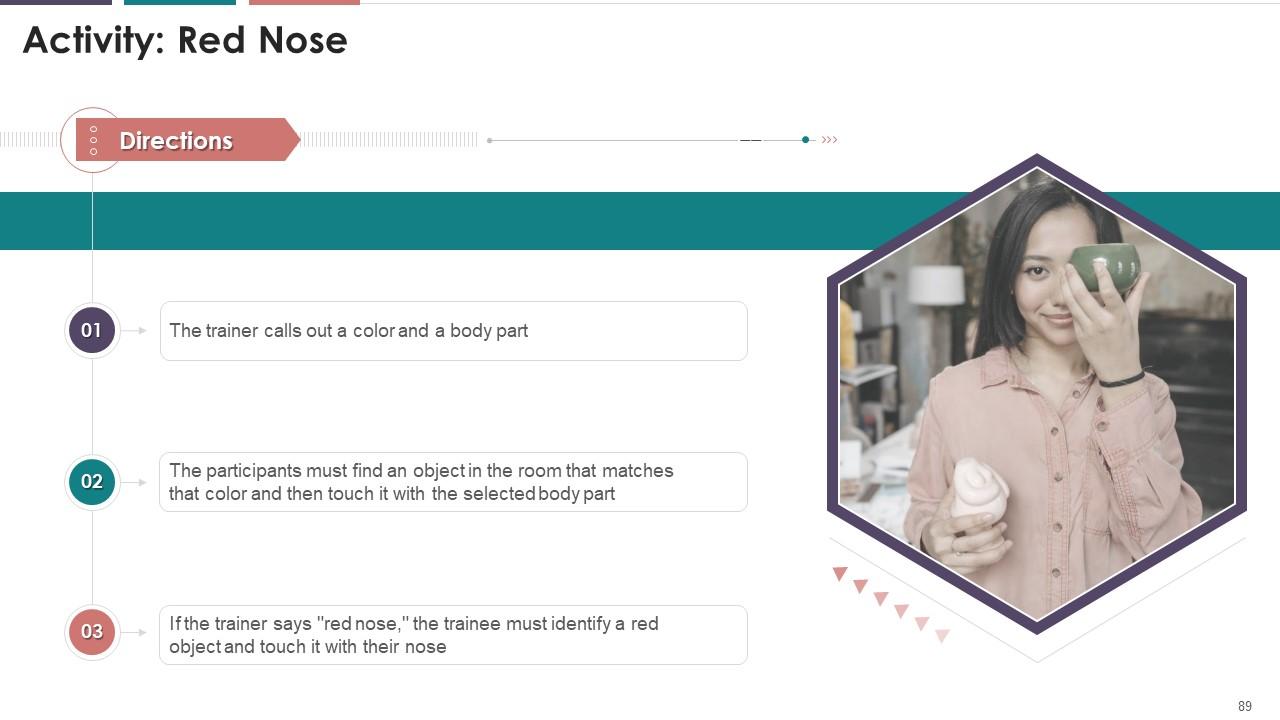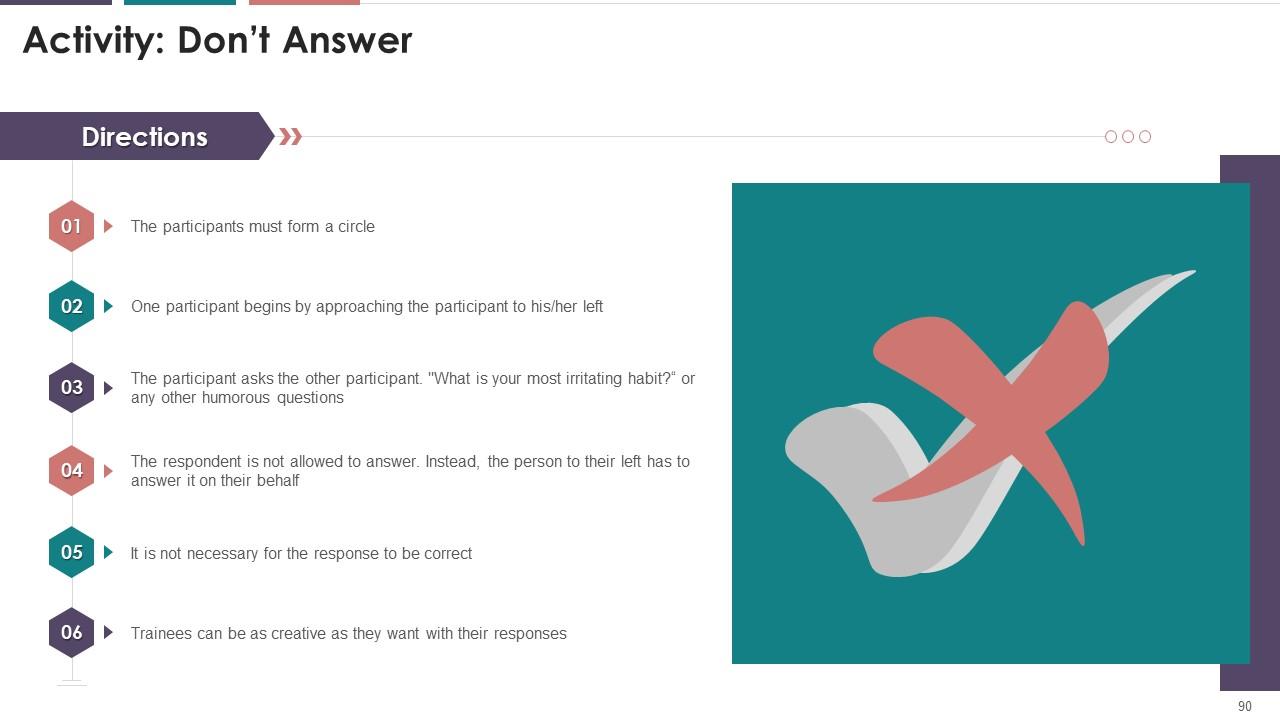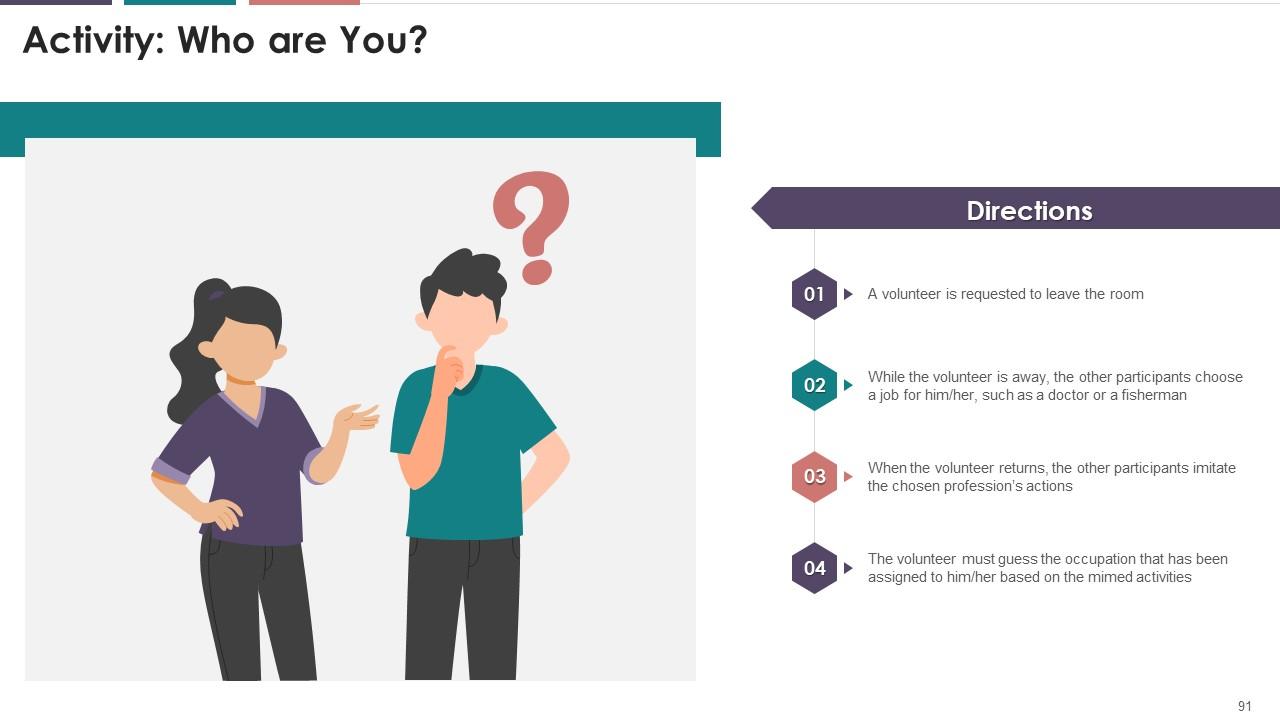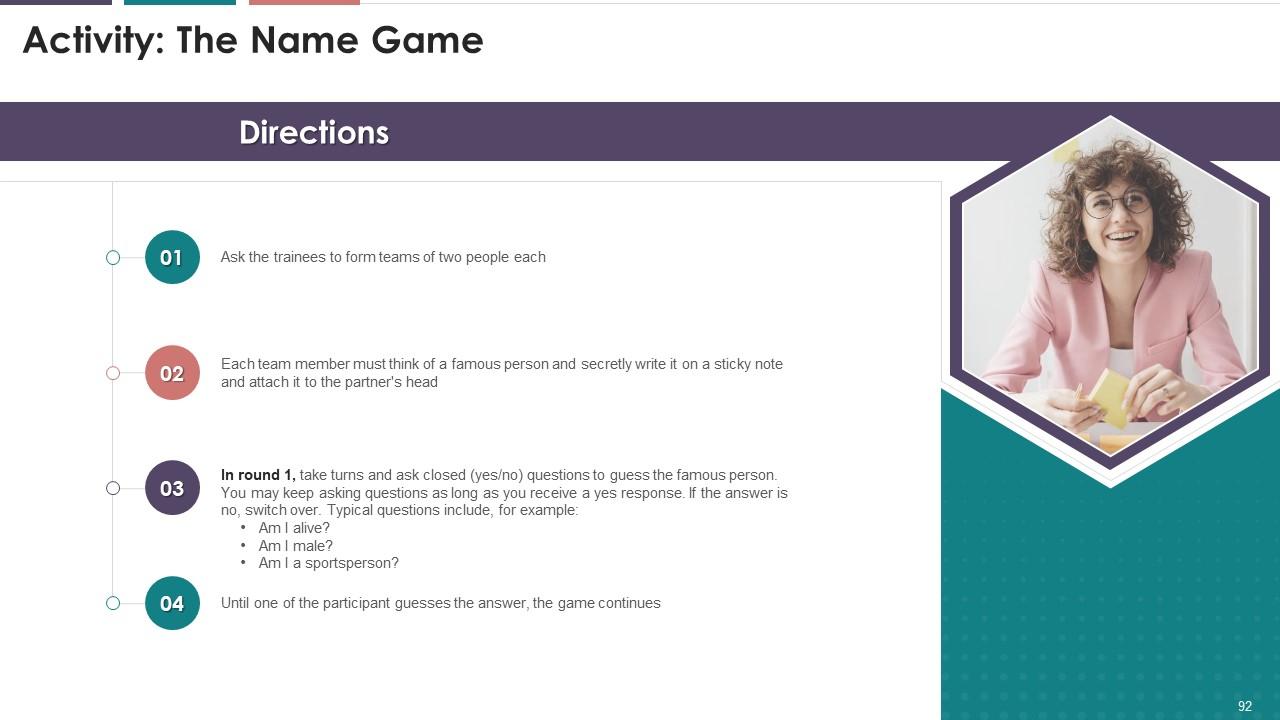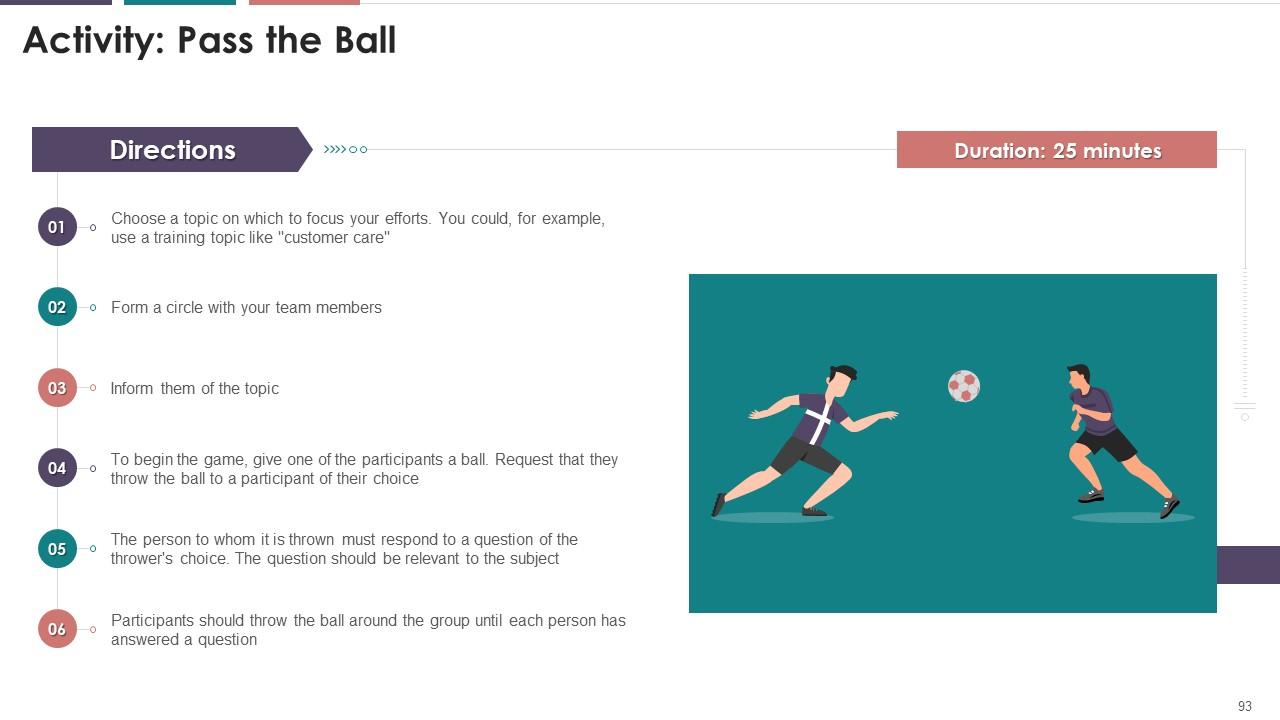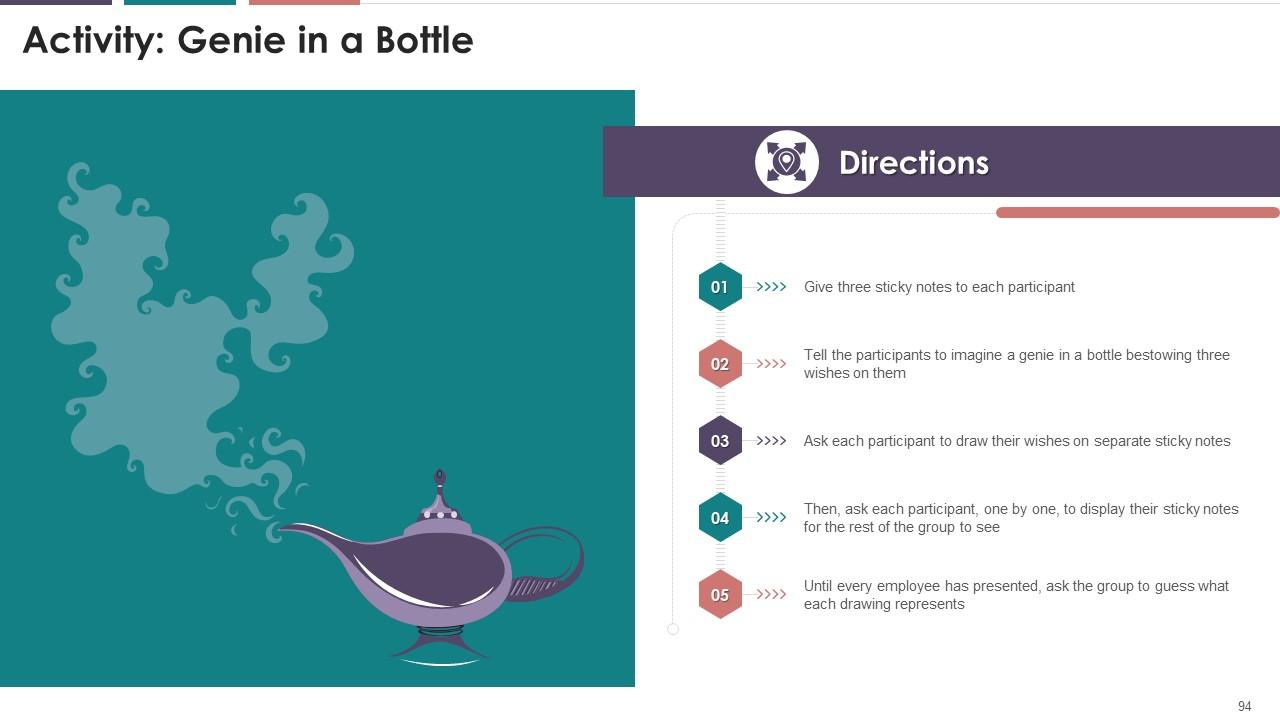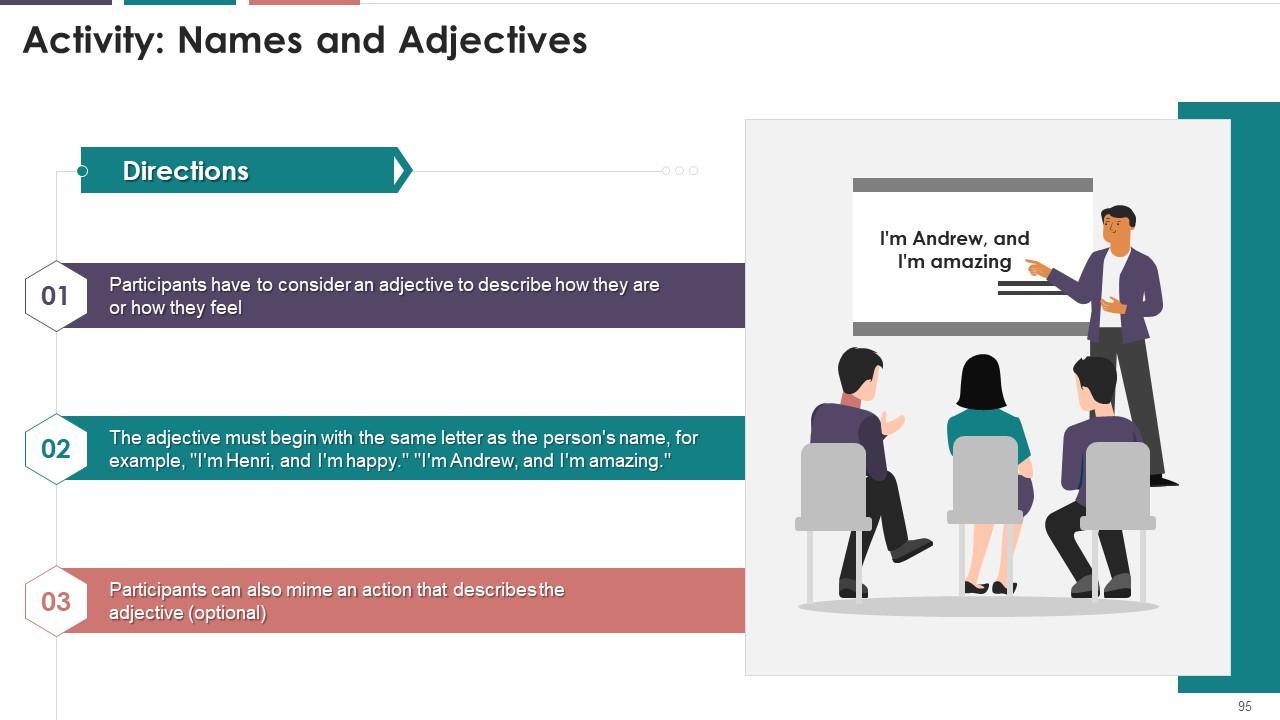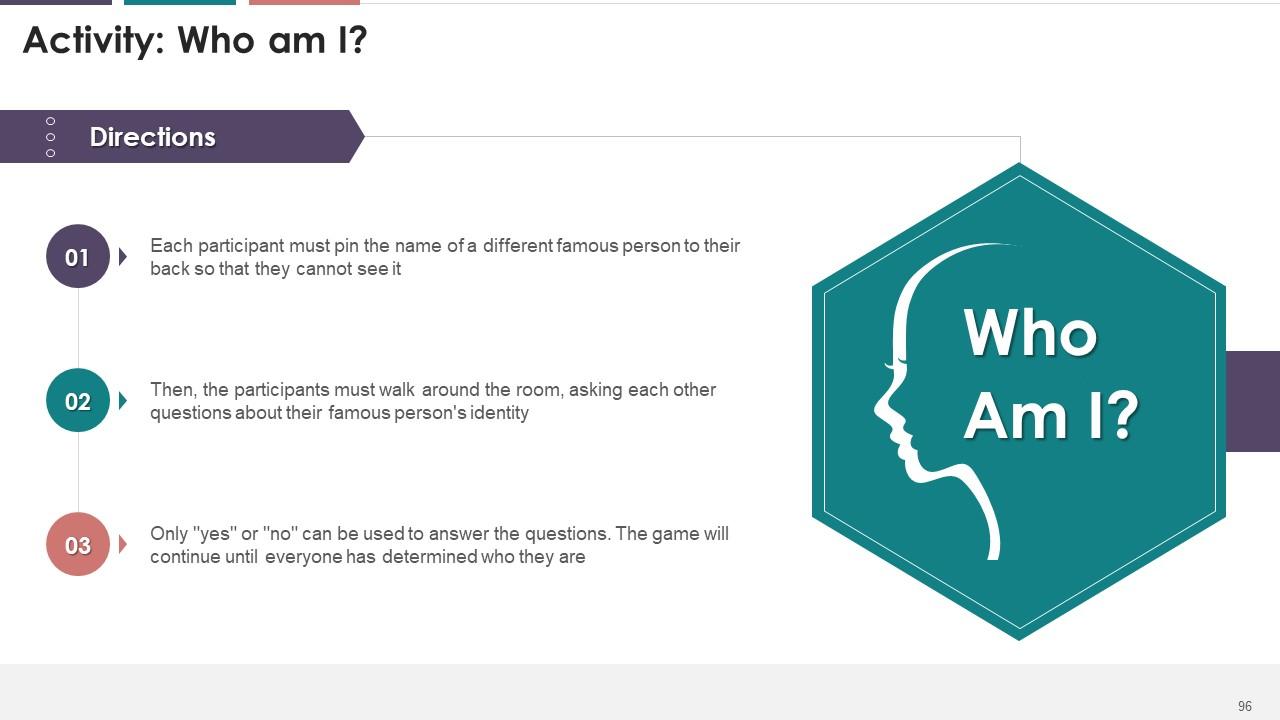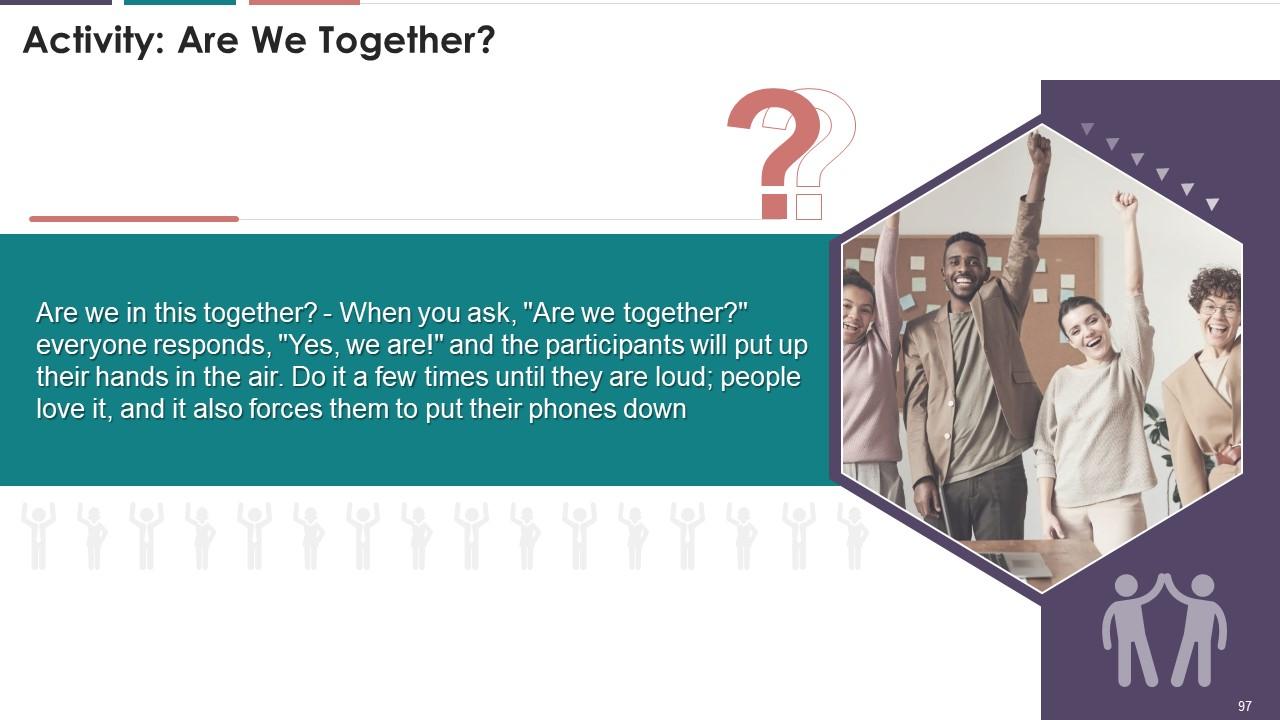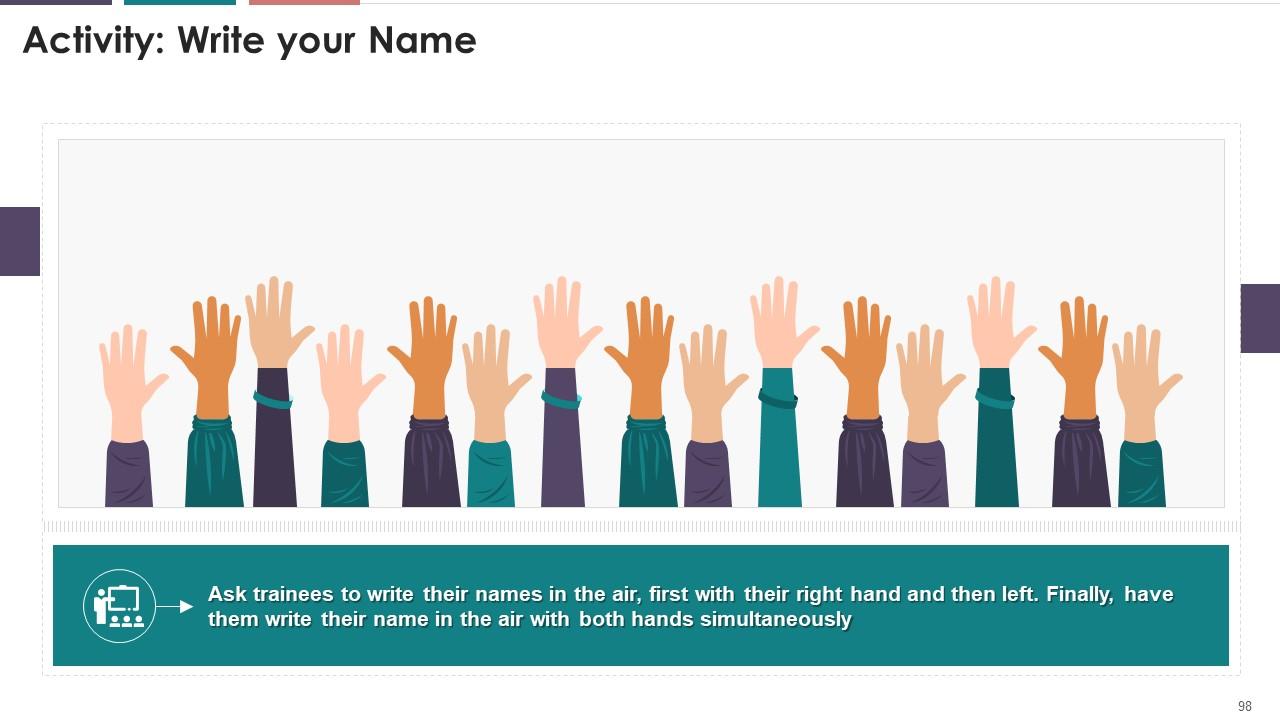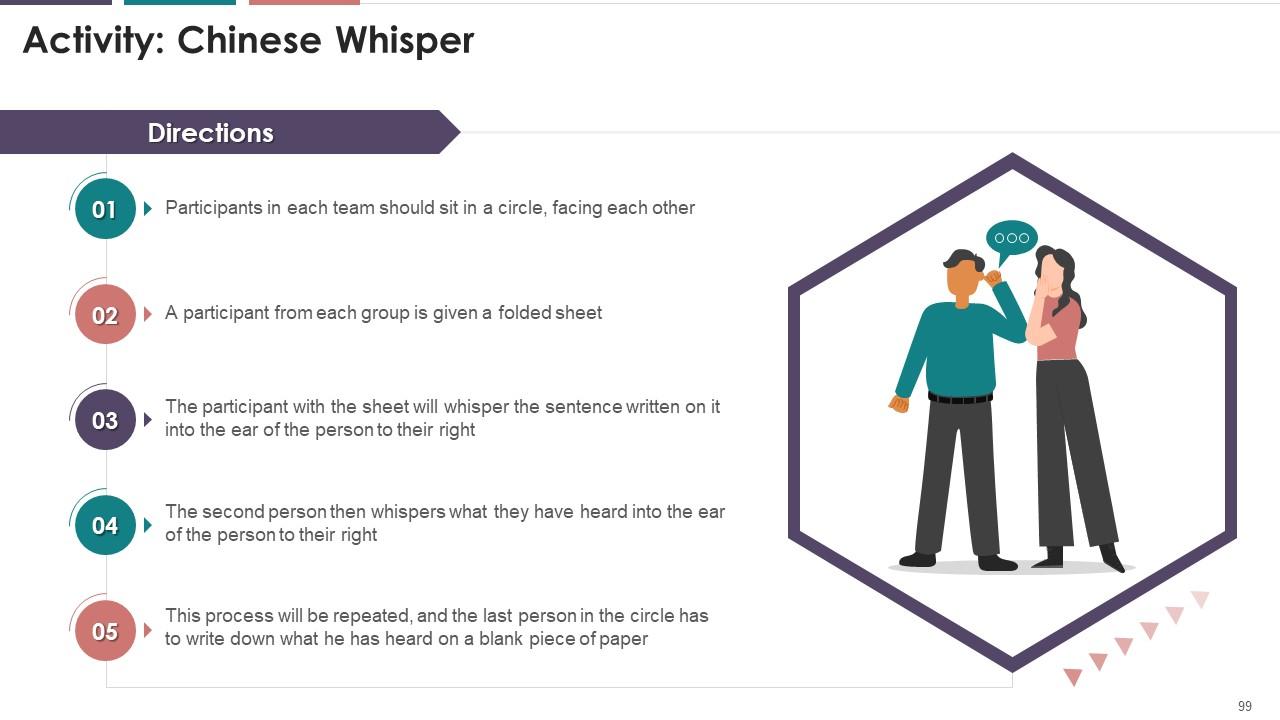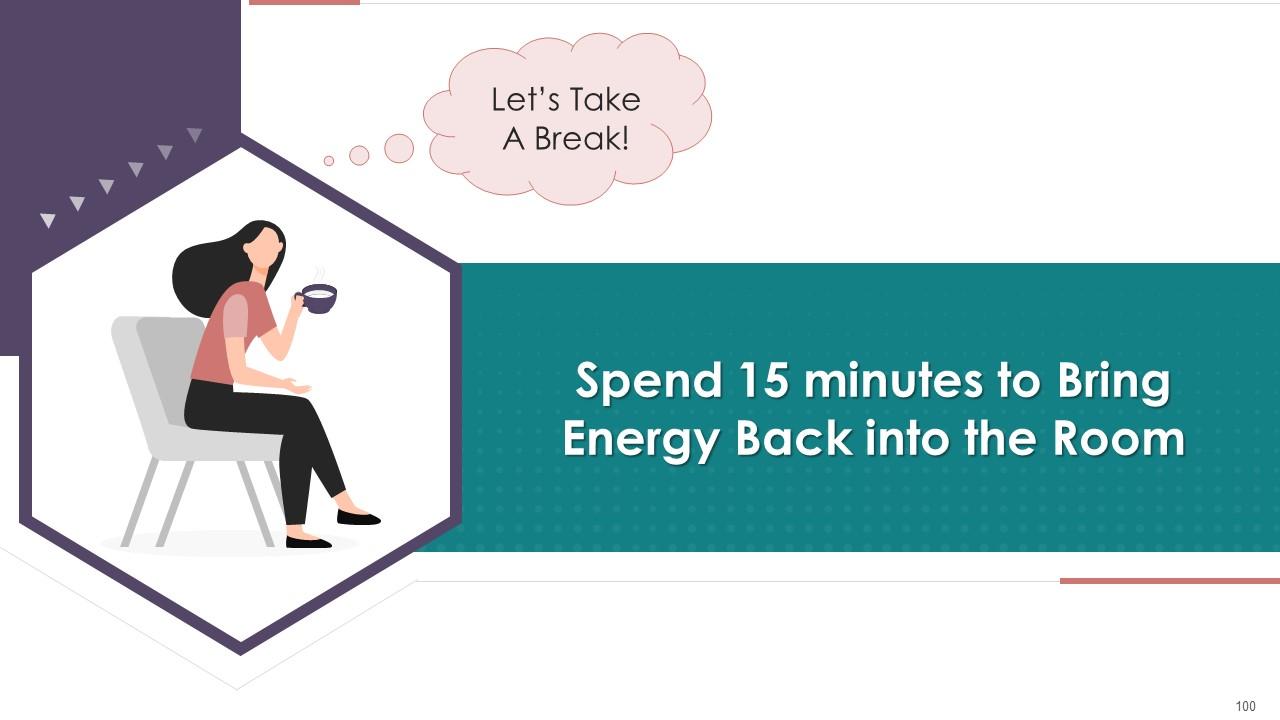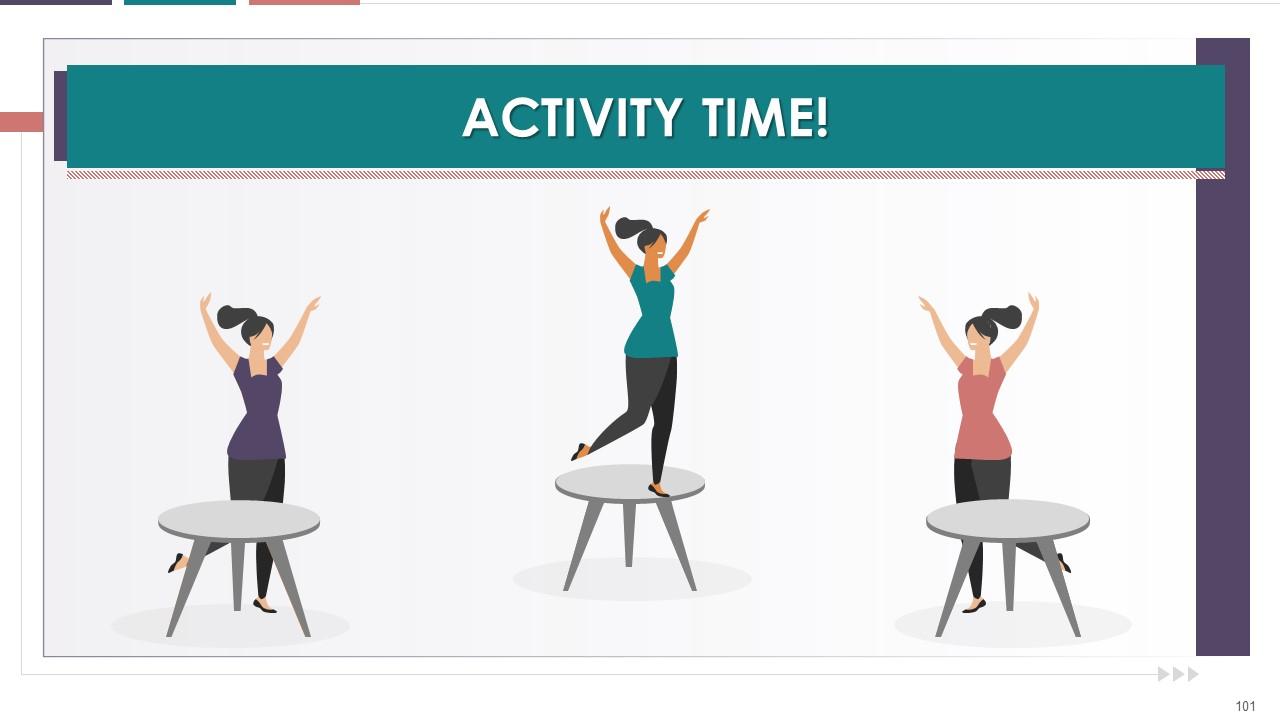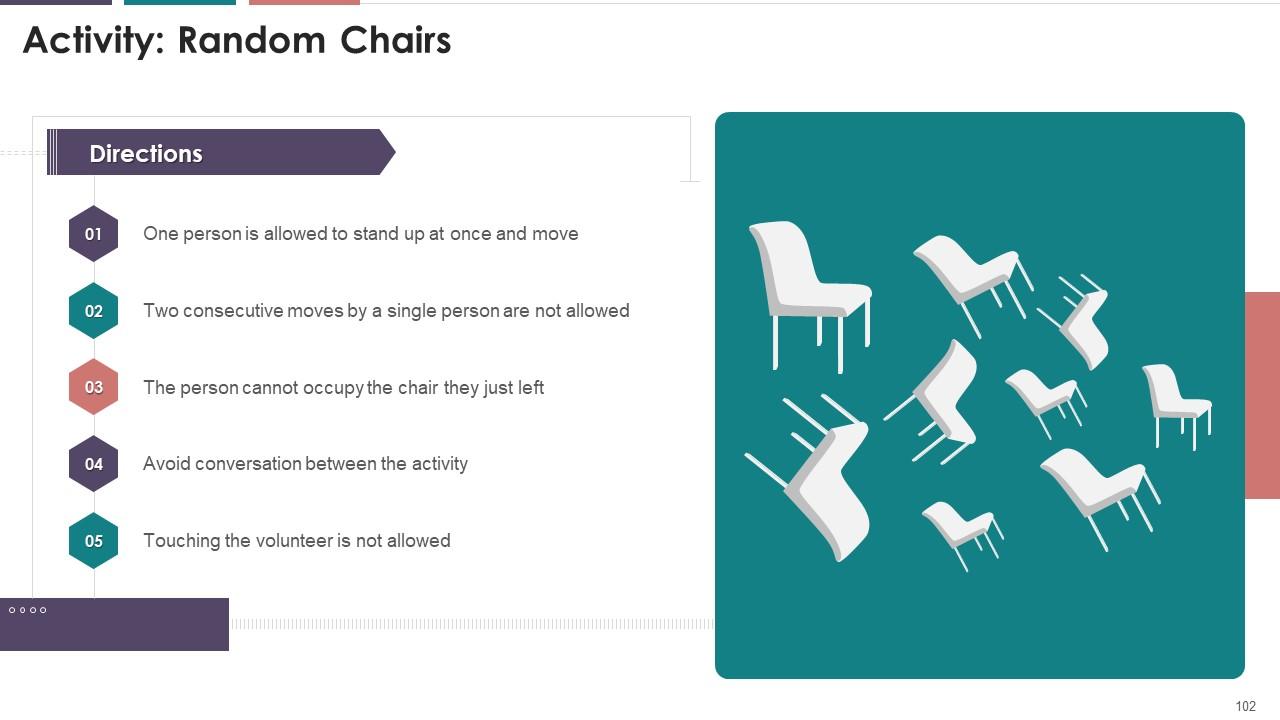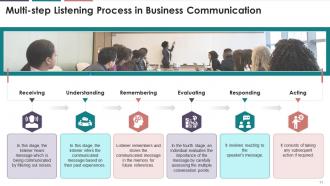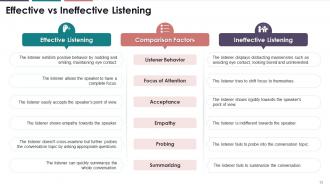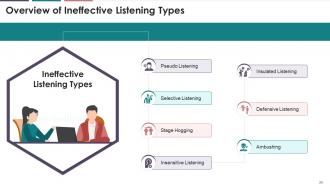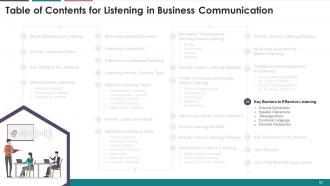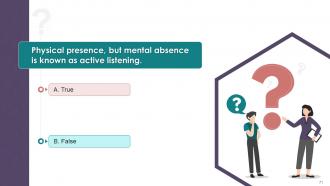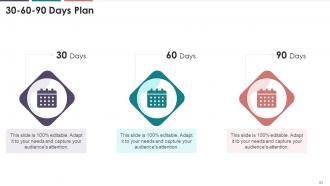Listening In Business Communication Training Module On Business Communication Edu Ppt
This PPT training deck covers the concept of Listening in Business Communication. It covers the principles, significance, and statistics of business listening, along with the difference between listening and hearing. It also covers effective listening types, such as discriminative, comprehensive, empathic, analytical, and appreciative listening. Further, it includes slides on ineffective listening types that are pseudo, selective, stage hogging, insensitive, ambushing, defensive, and insulated listening. The PPT training module also includes verbal and nonverbal techniques to develop active listening. Further, it covers barriers to effective listening, such as external distractions, speaker distractions, message intent, emotional language, and personal perspective. The PowerPoint deck also contains key takeaways, case studies, activities, discussion questions, MCQs, and memes to make the training session interactive. It also includes additional slides on about us, vision, mission, goal, 30-60-90 days plan, timeline, roadmap, training completion certificate, energizer activities.
This PPT training deck covers the concept of Listening in Business Communication. It covers the principles, significance, a..
- Google Slides is a new FREE Presentation software from Google.
- All our content is 100% compatible with Google Slides.
- Just download our designs, and upload them to Google Slides and they will work automatically.
- Amaze your audience with SlideTeam and Google Slides.
-
Want Changes to This PPT Slide? Check out our Presentation Design Services
- WideScreen Aspect ratio is becoming a very popular format. When you download this product, the downloaded ZIP will contain this product in both standard and widescreen format.
-

- Some older products that we have may only be in standard format, but they can easily be converted to widescreen.
- To do this, please open the SlideTeam product in Powerpoint, and go to
- Design ( On the top bar) -> Page Setup -> and select "On-screen Show (16:9)” in the drop down for "Slides Sized for".
- The slide or theme will change to widescreen, and all graphics will adjust automatically. You can similarly convert our content to any other desired screen aspect ratio.
Compatible With Google Slides

Get This In WideScreen
You must be logged in to download this presentation.
PowerPoint presentation slides
Presenting Training Module on Listening in Business Communication. This presentation deck contains 102 well researched and uniquely designed slides. These slides are 100 percent made in PowerPoint and are compatible with all screen types and monitors. They also support Google Slides. Premium Customer Support available. Suitable for use by managers, employees and organizations. These slides are easily customizable. You can edit the color, text, icon and font size to suit your requirements.
People who downloaded this PowerPoint presentation also viewed the following :
Content of this Powerpoint Presentation
Slide 4
This slide provides information regarding the definition of listening in business communication.
Slide 5
The purpose of this slide is to highlight the major principles of listening in business communication, such as aim, alertness, accuracy, and activity.
Instructor’s Notes:
The major principles of listening are:
· Aim: Looking for keywords, signals, or ideas
· Alertness: Focusing on what the speaker is saying instead of formulating a response
· Accuracy: Avoiding any type of premature evaluation of what is being said
· Activity: Taking a keen interest and thinking about responding in terms of answers or questions
Slide 6
This slide tabulates the difference between listening and hearing. The multiple comparison parameters used are nature, process, focus, act, senses involved, and initiation point.
Slide 7
This slide visually presents the importance of listening in daily life of individuals.
Slide 8
This slide highlights the business communication listening activity for the training session. It also includes the instructions and material required for exercise.
Instructor’s Notes:
Objectives:
· To help the trainee understand the importance of listening in communication
· To help the trainee understand the consequences of ineffective communication between the speaker and listener
Learning Outcomes: Trainees will develop their ability to listen attentively
Slide 10
This slide highlights the key objectives of listening in business communication in terms of gaining information, building relationships, reducing conflicts, motivating employees, maintaining reputation and encashing growth opportunities.
Instructor’s Notes:
The purpose of listening is not to formulate a response. The key objectives of listening are listed as follows:
· Gaining Information: Listening helps extract relevant information from communication by clearly understanding the speaker's point of view and ideas
· Building Relationships: It fosters trust in team members as it allows individuals to understand each other better this build long-term associations
· Reducing Conflicts: It reduces conflicts in case an employee feels misunderstood or mistreated
· Motivating Employees: It boosts employee morale. For example, when a manager listens to employees' ideas, it makes them feel valued. They don't hesitate to go beyond the call of duty
· Maintaining Reputation: It helps maintain the reputation of a business. For example, listening and resolving customer complaints results in a positive brand image
· Encashing Growth Opportunities: It supports the encashment of growth opportunities. For example, a company can introduce new products and services and be a pioneer only after it makes the effort to listen to customers’ feedback, demands and needs
Slide 11
The slide provides information regarding the multiple-step listening process in business communication. The major stages highlighted are receiving, understanding, remembering, evaluating, responding, and acting.
Slide 12
The purpose of this slide is to showcase a listening meme to add humor to the business communication session. This slide depicts the phenomena of Chinese Whispers that dogs any communication.
Slide 13
This slide tabulates the difference between effective and ineffective listening on multiple comparison factors of listener behavior, the focus of attention, acceptance, empathy, and probing.
Slide 14
This slide illustrates the instructions for drawing twin activity. It also includes the picture sample for the listening activity.
Slide 15
The purpose of this slide is to highlight multiple image samples to conduct the drawing twin activity in business communication training.
Slide 17
This slide provides an overview of effective and ineffective listening types. It also lists out effective listening types such as discriminative, comprehensive, empathic, analytical, and appreciative.
Slide 18
This slide provides information regarding the concept of discriminative listening and its usage.
Instructor's Notes:
Example of discriminative listening: An American, James, is sitting in the airport waiting area. Two Swedes are sitting behind him and are engaged in a conversation. Though James can't understand what the conversation is about, he can distinguish males and females based on the tone of the speaker's voice.
Slide 19
This slide provides information regarding the concept of comprehensive listening and its usage.
Instructor's Notes:
Example of comprehensive listening: Mathew is listening to his professor giving a lecture on digital marketing. He understands the meaning of the message delivered. Thus, Mathew is practising the comprehensive type of listening.
Slide 20
This slide provides information regarding the concept of empathic listening and its usage.
Instructor's Notes:
Example of empathic listening: When the manager is giving a motivating lecture, and some team members feel a rush of emotion. The charged-up members are practising empathetic listening.
Slide 21
This slide provides information regarding the concept of analytical listening and its usage.
Instructor's Notes:
Example of analytical listening: When an associate shares the next quarter's sales targets with the area manager for approval, they listen, interpret and ask to increase/decrease the target depending on the demand of the product.
Slide 22
This slide provides information regarding the concept of appreciative listening and its usage.
Instructor's Notes:
Example of appreciative listening: When one listens to poetry to get words that excite or amaze. This also comes into play, when one listens to a political speech, to seek motivational phrases.
Slide 23
This slide depicts the instructions for listen and follow exercise. It can be used to conduct the listening activity in business communication training.
Slide 24
This slide illustrates the instructions for two-step listen and follow activity for listening in business communication.
Slide 26
This slide provides information about the ineffective listening types such as pseudo, stage, selective, insulated, defensive, ambushing, and insensitive listening.
Slide 27
This slide provides information regarding the concept of pseudo listening. It also contains details of how to identify pseudo listener and ways to prevent it.
Instructor's Notes:
How to Identify a Pseudo Listener
· If the listener is simply nodding his/her head without any other expression
· Using conversation fillers such as ”hmmm”
How to Prevent Pseudo Listening
· As a listener, one should provide undivided attention to speaker
Slide 28
This slide highlights the concept of selective listening. It also provides information regarding how to identify a selective listener and techniques to prevent it.
Instructor's Notes:
How to Identify a Selective Listener
· The listeners respond according to one’s own will, carrying a wrong or misleading interpretation of the what was said
How to Prevent Selective Listening
· As listener, regularly summarize the conversation
· Ask relevant questions to the speaker to ensure constant engagement
Slide 29
The purpose of this slide is to showcase the concept of stage hogging in ineffective business listening. It also contains details of how to identify a stage hogger and techniques to prevent stage hogging.
Instructor's Notes:
How to Identify a Stage Hogger
· The listener often interrupts the speaker
· The listener often plans what they are going to say as a response
How to Prevent Stage Hogging
· As a speaker, communicate your discomfort verbally to stage hogger (please let me complete first) or use nonverbal actions (breaking eye contact)
· As a listener, avoid interrupting the speaker and ask genuine questions when required
Slide 30
This slide provides information about insensitive listening, a type of ineffective listening. It also contains details of traits of an insensitive listener and methods to prevent it.
Instructor's Notes:
How to Identify a Insensitive Listener
· The listener looks absent-minded
· The listener often keeps the conversation brief by quickly offering a "solution" to "the problem.“
How to Prevent Insensitive Listening
· As a listener, give the speaker complete attention and provide nonverbal cues such as nodding in understanding
· Provide appropriate empathetic response as per the conversation requirement such as
· If it's a happy situation, say, "That is so great! Tell me more about it.“
· If someone is sharing difficult information, simply say, "I am sorry. If okay, please share in detail."
Slide 31
This slide highlights the overview of ambushing in ineffective listening. It also covers details of the characteristics of the ambush listener and techniques to avoid ambush listening.
Instructor's Notes:
How to Identify an Ambush Listener
· The ambush listener listens carefully, but isn't motivated by interest in the speaker
· Aggressive listeners often critique peers' ideas/solutions/work
· This behavior generally occurs due to poor interpersonal relationships with the speaker
· It also happens due to own low self-esteem and insecurities
How to Prevent Ambush Listening
· As a listener, avoid being aggressive with the sole objective of winning the argument
· Have an open-minded approach and respect other points of view in the conversation
Slide 32
This slide highlights the overview of defensive listening. It also provides information about the traits of a defensive listener and techniques to avoid defensive listening.
Instructor's Notes:
How to Identify a Defensive Listener
· A defensive listener hears a general statement and personalizes it
· A defensive listener often showcases the following feelings towards the speaker
· Insecurity
· Jealousy
· Guilt
· Lack of confidence
How to Prevent Defensive Listening
· As a listener, avoid interrupting the speaker and hear them out with empathy
· If the speaker is saying something that will trigger an emotional response, the listener must stays calm and asks them to reframe what they are saying
· As a good listener, assume that you are interacting with the particular individual for the first time
Slide 33
This slide provides information regarding the overview of insulated listening. It also covers details of the characteristic of the insulated listener and techniques to avoid insulated listening.
Instructor's Notes:
How to Identify Insulated Listener
· Insulated listener shows self-protective behavior
· They are always noncommittal towards a particular topic
How to Prevent Insulated Listening
· As a listener, try to listen to the speaker's point of view on a particular topic with an open mind
· If possible, showcase engagement using nonverbal cues
Slide 36
This slide provides information regarding the definition of active listening. It also includes details of 3As of active listening which are attitude, attention, and adjustment.
Instructor's Notes:
The three As of active listening are:
· Attention: Listener must be in the present moment and pay close attention to the speaker, disregarding any other anxieties of the day
· Attitude: Listener must listen to the speaker with a positive and open mind
· Adjustment: The listener must be willing to change and adapt their responses in line with to the speaker’s train of thought until the end of the conversation
Slide 37
This slide tabulates the difference between active and passive listening on multiple comparison factors such as the primary objective, self-motivation level, engagement level, and nonverbal cues.
Slide 38
This slide illustrates the instruction that needed to be followed to conduct listen and answer activity in business communication training. The slide provides information about the set of questions that should to be answered by trainees on the basis of the script read by the trainer.
Instructor’s Notes:
Read the script to training attendees
Business Markets:
· I’ve been talking to business managers and reading surveys about the future of management. I will present some ideas about how businesses will change over ten years. It is not a scientific, mathematical analysis but only an idea for us to discuss. I’m sure a significant development will be a substantial increase in competition
· Global Companies are trying to sell identical products. Consumers now have better food products from Australia that might be manufactured in other countries like the USA, China, Finland, etc. Mergers and takeovers, happening in parallel, mean the governments are losing control over private companies
· We can all think of companies that exert significant influence on consumer choice. Market demand is growing rapidly in India, Brazil, and other rapidly expanding economies. The pressure on resources around the world is disturbing balance that marks the functioning of nature
External Influences on Businesses: Companies are taking advice from customers before making new business decisions. Companies are finding out what customer requires and provide it instead of making products and sell them. Another issue is that concerns about the environment will force manufacturers to extend product life cycles and reduce pollution and waste. Strengthened regulations will be the order of the day.
Business Structures: Many societies are much more flexible and democratic, and the structure of companies is changing to indicate that. We will see greater importance within companies on teams created with a specific project in mind. When it is completed, the teams will disband and will form new groups. People experience work as one part of their life and not the essential part of life. With workforce essentially reducing in some countries, businesses have to compete for staff instead of choosing among many candidates. Facilities that will attract and retain employees are flexible working hours and work from home.
Management Styles:
· People living in home cities, abroad can choose these facilities given by the company. The working of senior management will have to evolve and efficiency will be just one key trait. Excellent leadership skills will assume a much greater role
· Around the world, the senior managers of large businesses are mainly men in their 50s and 60s. The organization can initiate and respond to change in a fast-moving world, where they face lots of efficiency issue and competition
· The dominant management style will almost certainly become more consultative and collaborative, caused by women moving to senior positions
· Developments influence many changes in the broader business environment. The traditional emphasis of the business is manufacturing, and of course, the service sector is significantly essential. We should not overlook the growing financial contribution of intellectual property. Books and films contribute a lot to the generation of money from the sale of related DVDs, music, games, clothes, etc. Another point is that although I’ve been talking about companies, one trend they have to face is moving away from people working for the same employer for years. Instead, more and more people are becoming self-employed
Slide 39
The slide showcases the significant advantages offered by active listening in business organizations. The key benefits of active listening are building trust, resolving conflict, boosting productivity, solving problems, increasing knowledge, and limiting the loss of information.
Instructor's Notes:
The key benefits of active listening in the workplace are:
· Builds Trust: Active listening helps build trust. When fellow employees know they can speak freely without being judged, they'll be more likely to confide in you, leading to the formation of a long-term relationship
· Resolves Conflict: In active listening by paraphrasing, the listener eliminates the possibility of misunderstandings, thus avoiding disagreements.
· Boosts Productivity: Actively listening helps in retaining employees as it allows them to express their ideas/opinions making them feel more freely energized, focused, and less prone to distraction
· Solves Problems: Active listening enables one to quickly identify issues that employees face and create an action plan to address these
· Increases Knowledge: Active listening improves one's knowledge base. You understand new topics across business domains
· Limits Loss of Information: Active listening helps avoid missing critical information, especially if the speaker is providing instructions or providing training on a new process
Slide 41
This slide provides information regarding the tips to become an active listener.
Slide 42
This slide provides information regarding the verbal methods to develop active listening such as positive reinforcement, remembering, questioning, reflecting and summarizing.
Slide 43
This slide indicates the verbal method of positive reinforcement to improve active listening in business communication.
Slide 44
This slide highlights the verbal method of remembering to improve active listening in business communication.
Slide 45
This slide showcases the verbal method of questioning to improve active listening.
Slide 46
This slide provides information regarding the verbal method of reflecting to improve active listening.
Slide 47
This slide provides information regarding the verbal method of summarizing to improve active listening in business communication.
Slide 48
This slide illustrates the active listening activity that can be conducted in business communication training. It also contains the examples of open-ended questions for roleplay.
Slide 50
This slide lists nonverbal techniques to improve active listening in business communication. The major techniques are smiling, eye contact, posture and mirroring.
Slide 51
This slide provides information regarding the nonverbal method of smiling to improve active listening in business communication.
Slide 52
This slide indicates the nonverbal method of eye contact to enhance active listening.
Slide 53
The purpose of this slide provides detail of nonverbal method of posture to improve active listening.
Slide 54
This slide provides information regarding the nonverbal method of mirroring to improve active listening.
Slide 55
This slide showcases the instructions in active listening activity that can be conducted as listening roleplay in business communication training.
Instructor’s Notes:
Objectives:
· To develop active listening skills in training
· To highlight the importance of open-ended questions in communication
Slide 56
This slide illustrates information regarding the discussion questions that trainer can ask business communication training attendees for active listening roleplay activity.
Slide 58
The purpose of this slide is to highlight the multi-step approach for developing better listening.
Slide 60
This slide lists the approach to give feedback using the active listening approach.
Slide 61
This slide provides information regarding the active listening approach for receiving feedback in business communication.
Slide 63
In this slide, multiple listening barriers are listed, such as external distractions, speaker distractions, message intent, emotional language, and personal perspective. It also includes information regarding techniques to overcome each barrier.
Slide 65
This slide depicts the summary of listening in business communication session.
Slide 88 to 99
These slides depict energizer activities to engage the audience of the training session.
Slide 102
The above slide displays the activity for the team members found less energetic and enthusiastic. It will ensure an increase in energy levels and the productivity of employees at the workplace.
Instructor's Notes:
· Multiple chairs are to be adjusted in the empty and spacious room in a random order
· The chairs should be put in a manner that every chair points in a different direction and all the chairs are occupied
Now,
· Ask for a volunteer from the batch. (Batch may include a maximum of 15 people for a regular size room)
· The volunteer is supposed to walk slowly and approach his/her empty chair and sit down. If the chair is already occupied, then he/she is expected to occupy the other/next alternative empty chair available
· All other members will try to stop the person from approaching the relevant chair
Strategy Formulation:
· Multiple teams can be made to conduct the activity
· Each team can be allotted 2 minutes for planning
· Each round is to be reviewed for the outcomes achieved from the activity
· Each team should have a different volunteer, preferably the person with the lowest energy levels from the batch
· The volunteer should move cautiously so as to not bump into any of the props or persons in the room
Activity Review/Outcomes:
· How did the activity influence the teamwork and engagement skills of all the participants?
· How was the experience while planning and working with 15-20 members at a time?
· Was everybody clear about the purpose and conduct of the respective activity?
· Did you observe any flaws that you wish to improve? Or any other instructions you want to include to make the activity conduct easier?
Listening In Business Communication Training Module On Business Communication Edu Ppt with all 107 slides:
Use our Listening In Business Communication Training Module On Business Communication Edu Ppt to effectively help you save your valuable time. They are readymade to fit into any presentation structure.
-
Loved the fact that SlideTeam provides clean, high-definition, and professional PowerPoint products.
-
The ease of modifying templates is just superb! Also, the vast collection offers plenty of options to choose from.


